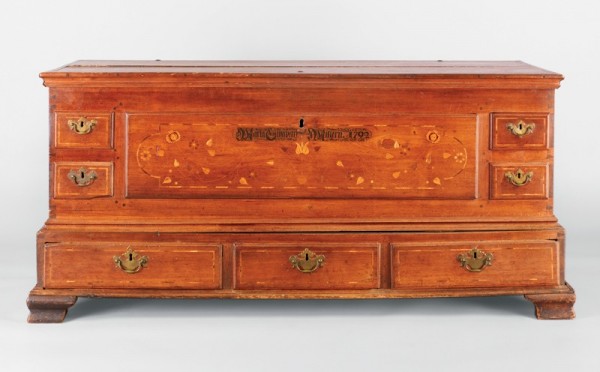
Chest, Heidelberg Township area, Lebanon or Berks County, Pennsylvania, 1792. Walnut and mixed-wood inlay (including maple, sumac, holly, birch, and possibly mahogany) with white pine and oak; brass, iron. H. 27", W. 59 1/4", D. 24 1/2". (Private collection; photo, Laszlo Bodo.) The brasses are replaced.
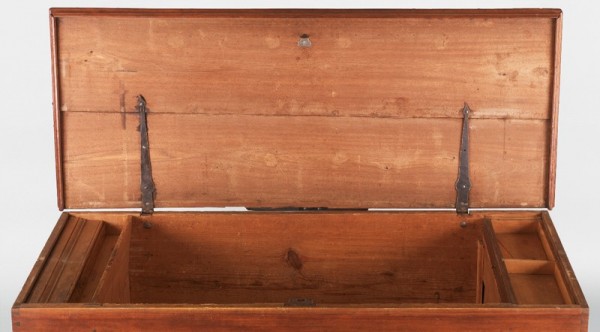
Detail of the interior of the chest illustrated in fig. 1. (Photo, Laszlo Bodo.) The surviving till lid has a molded top and edge. Two large fraktur were once pasted to the underside of the chest lid.
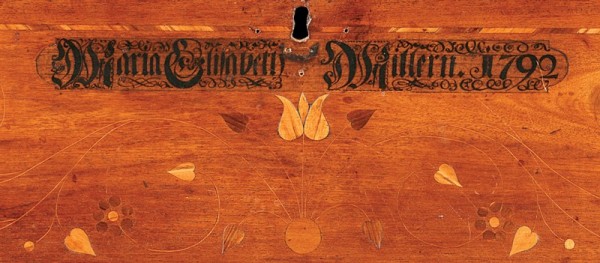
Detail of the inscription on the chest illustrated in fig. 1. (Photo, Laszlo Bodo.) The “n” after Miller is a suffix applied to women’s surnames (both married and unmarried) in German; depending on the surname, an –n, –en/–in or –sen/–sin suffix was used (e.g., Hoffman/Hoffmanin).
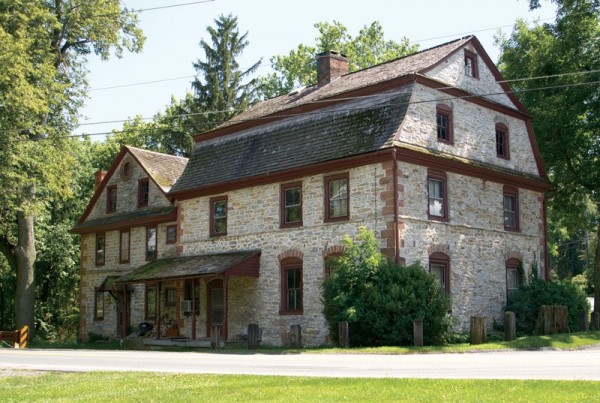
House of George and Maria Catharina Miller, then Michael and Maria Elisabeth Miller, Millbach, Heidelberg Township, Lancaster County (now Millcreek Township, Lebanon County), Pennsylvania, built in 1752 and expanded by 1760. (Courtesy, Millbach Foundation, Inc.; photo, Laszlo Bodo.) The gable end of the original gambrel-roof house is to the right, and the addition built by Michael Miller, to the left.

Gristmill of Michael Miller, Millbach, Heidelberg Township, Lancaster County (now Millcreek Township, Lebanon County), Pennsylvania, built in 1784. (Courtesy, Millbach Foundation, Inc.; photo, Laszlo Bodo.)
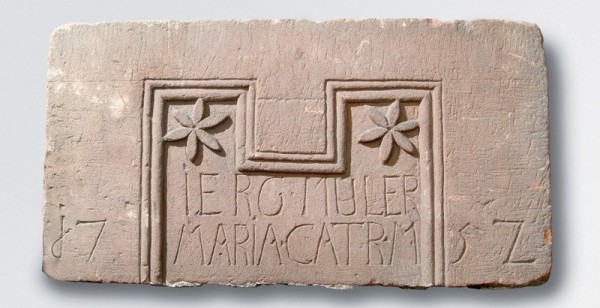
Date stone from the Miller house, 1752. (Courtesy, Philadelphia Museum of Art.)
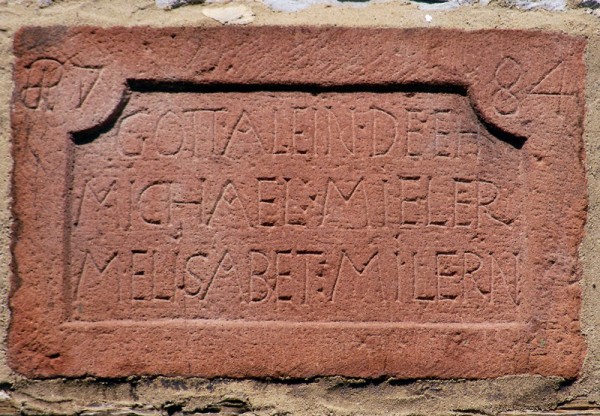
Date stone of Michael Miller’s gristmill, 1784. (Courtesy, Millbach Foundation, Inc.; photo, Laszlo Bodo.)
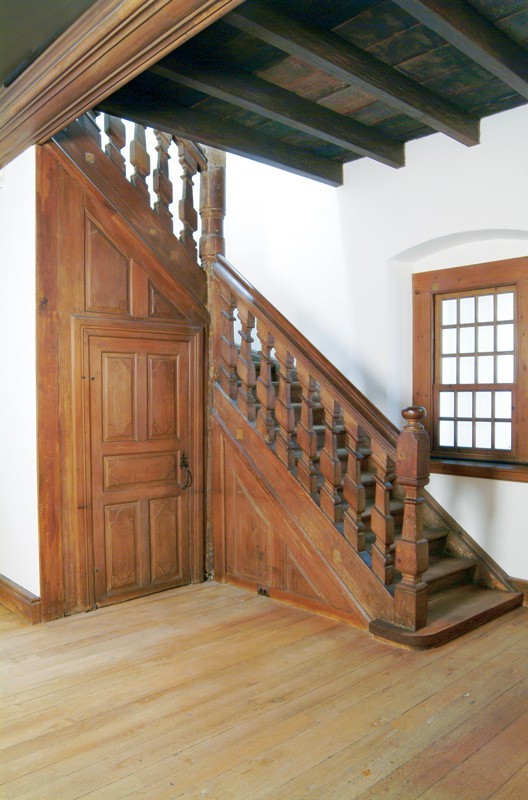
Staircase from the Miller house. (Courtesy, Philadelphia Museum of Art, gift of Mr. and Mrs. Pierre S. du Pont and Mr. and Mrs. Lammot du Pont, 1926.) The staircase was removed in 1926 along with other interior woodwork and installed as a period room at the Philadelphia Museum of Art.

Stove support from the Miller house, 1757. Stone. H. 14 3/4", W. 20 1/2", D. 5 1/2". (Courtesy of Conrad Weiser Homestead, Bureau of Historic Sites and Museums, Pennsylvania Historical and Museum Commission, CW74.190; photo, Gavin Ashworth.) The foliate design above the initials is similar to one carved above the entry of the nearby Heinrich Zeller house, built in 1745 (see fig. 24).

Tall-case clock with movement by Jacob Graff (1729–1778), Lebanon, Lancaster (now Lebanon) County, Pennsylvania, 1750–1760. Walnut and mixed-wood inlays; brass, silvered brass, bronze, iron, steel; glass. H. 98", W. 24 1/4", D. 12 1/2". (Courtesy, Winterthur Museum, bequest of Henry Francis du Pont, 1965.2261; photo, Laszlo Bodo.)
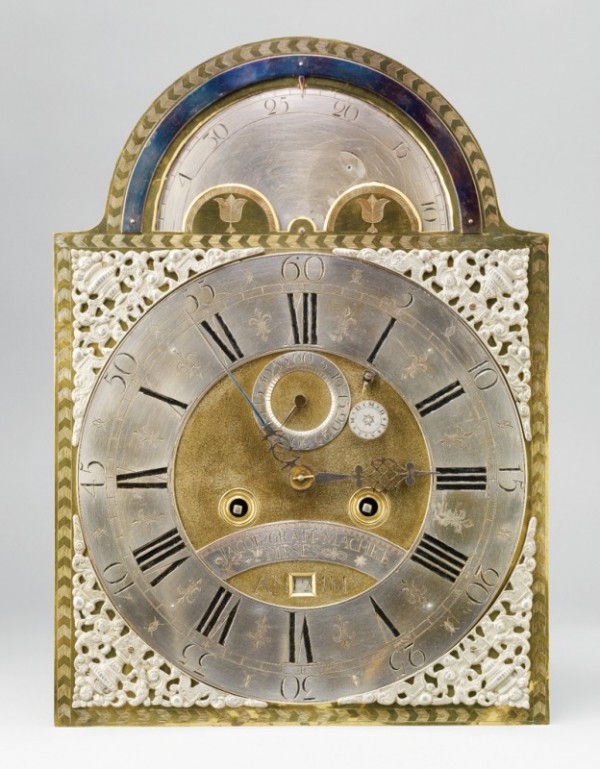
Detail of the movement of the clock illustrated in fig. 10. (Photo, Laszlo Bodo.)
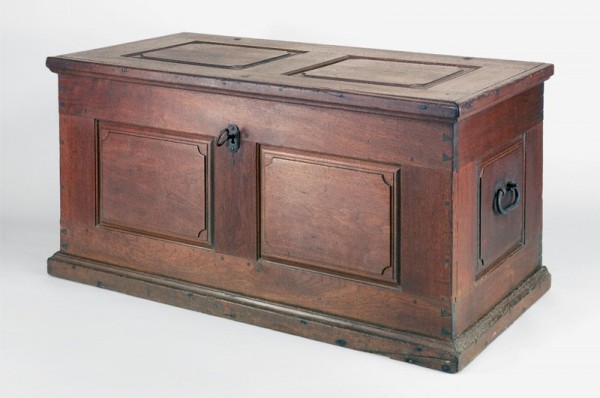
Chest, Millbach area, Heidelberg Township, Lancaster County (now Millcreek Township, Lebanon County), Pennsylvania, 1750–1775. Walnut with tulip poplar; iron. H. 25 1/2", W. 52 1/2", D. 26". (Courtesy, Millbach Foundation, Inc.; photo, Laszlo Bodo.)

Hanging corner cupboard, Millbach area, Heidelberg Township, Lancaster County (now Millcreek Township, Lebanon County), Pennsylvania, 1750–1775. Tulip poplar; iron. H. 34", W. 37", D. 21". (Private collection; photo, Laszlo Bodo.)
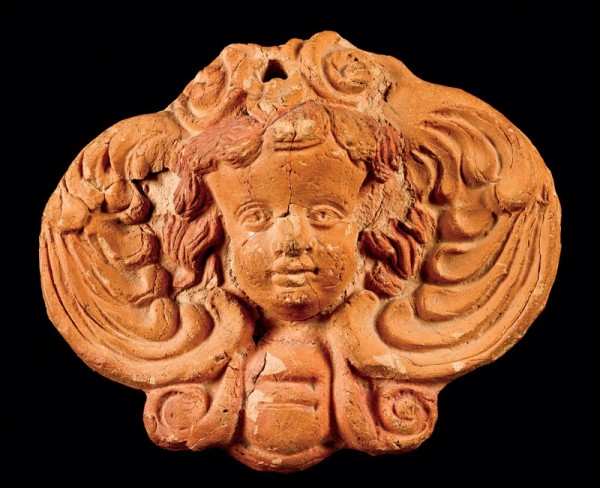
Winged angel head, Millbach area, Heidelberg Township, Lancaster County (now Millcreek Township, Lebanon County), Pennsylvania, 1750–1775. Unglazed earthenware. H. 5 3/4", W. 6 3/4", D. 2". (Courtesy, Millbach Foundation, Inc.; photo, Gavin Ashworth.)
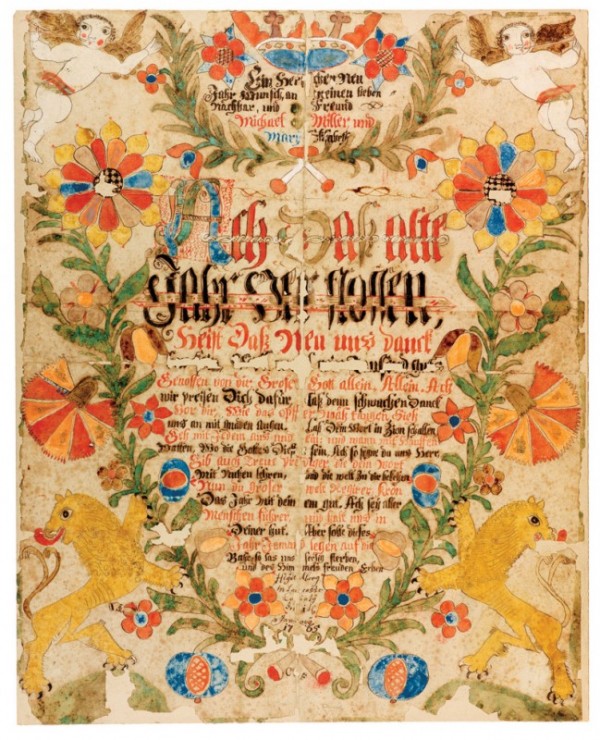
New Year’s greeting for Michael and Maria Elisabeth Miller, attributed to Caspar Feeman Jr. (ca. 1725–1810), Millbach area, Heidelberg Township, Lancaster County (now Millcreek Township, Lebanon County), Pennsylvania, 1765. Watercolor and ink on laid paper. 20 1/2" x 16 1/4". (Courtesy, Winterthur Museum, bequest of Henry Francis du Pont, 1957.1202; photo, Laszlo Bodo.) The foliate device framing the text is similar to that on the stove support illustrated in fig. 9.
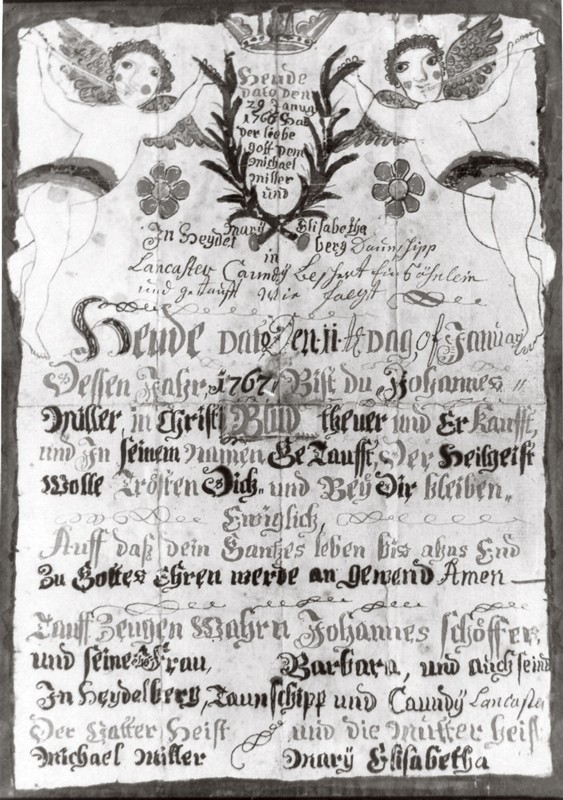
Photograph of a birth and baptismal certificate for Johannes Miller (1766–1848), attributed to Caspar Feeman Jr. (ca. 1725–1810), Millbach area, Heidelberg Township, Lancaster County (now Millcreek Township, Lebanon County), Pennsylvania, ca. 1767. (Courtesy, Winterthur Library, Joseph Downs Collection of Manuscripts and Printed Ephemera, Frederick S. Weiser Collection.)
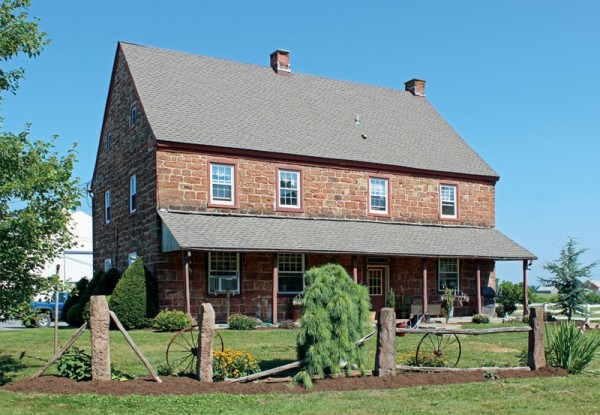
House of Valentine and Susanna Viehmann (Feeman), Millbach area, Heidelberg Township, Lancaster County (now Millcreek Township, Lebanon County), Pennsylvania, built in 1762. (Photo, Laszlo Bodo.)

Birth and baptismal certificate for Maria Elisabeth Miller (1775–1843), by Henrich Otto (1733–ca. 1799), Millbach, Heidelberg Township, Lancaster County (now Millcreek Township, Lebanon County), Pennsylvania, ca. 1775. Watercolor and ink on laid paper. 12 3/4" x 16 1/4". (Courtesy, Rare Book Department, Free Library of Philadelphia.)
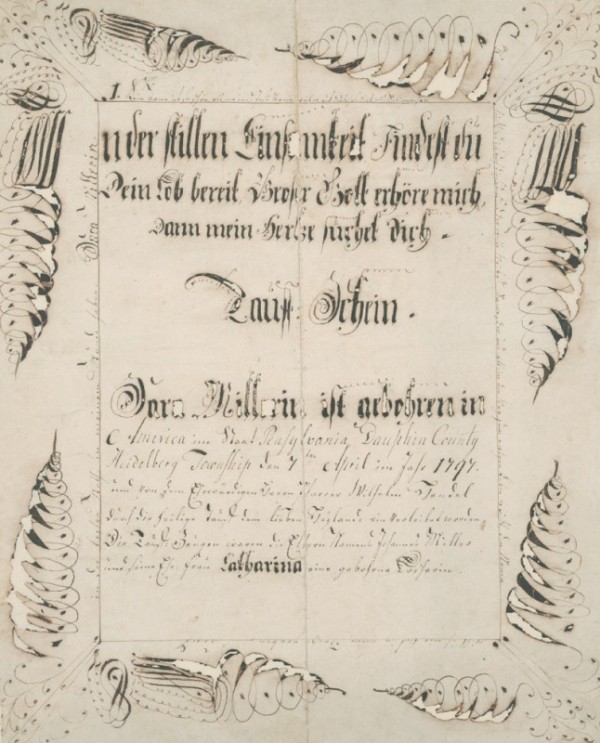
Birth and baptismal certificate for Sara Miller (1797–1870), Millbach, Heidelberg Township, Lancaster County (now Millcreek Township, Lebanon County), Pennsylvania, ca. 1797. Watercolor and ink on laid paper. 15 3/4" x 12 3/4". (Courtesy, Rare Book Department, Free Library of Philadelphia.)
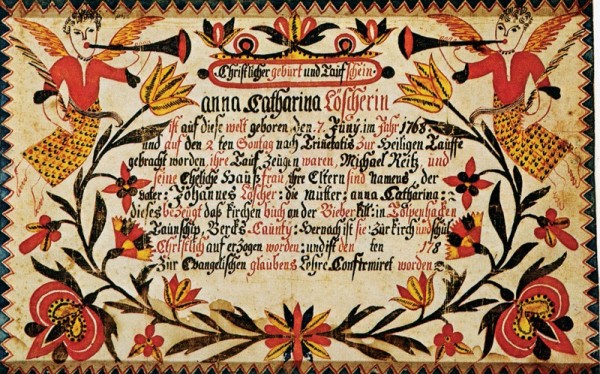
Birth and baptismal certificate for Anna Catharina Lescher (1768–1808), attributed to Johann Conrad Gilbert (1734–1812), ca. 1785. Watercolor and ink on laid paper. 8 1/4" x 12 5/8". (Private collection; photo, Winterthur Museum.)
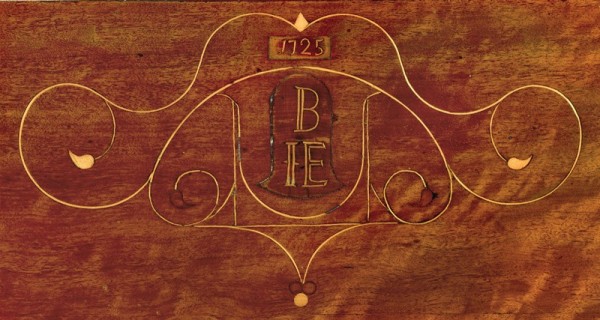
Detail of the line-and-berry inlay on a drop-leaf table owned by James and Elizabeth Bartram, possibly by James Bartram (1701–1771), Marple Township area, Chester (now Delaware) County, Pennsylvania, 1725. (Courtesy, Winterthur Museum, promised gift of Mr. and Mrs. John L. McGraw; photo, Gavin Ashworth.)
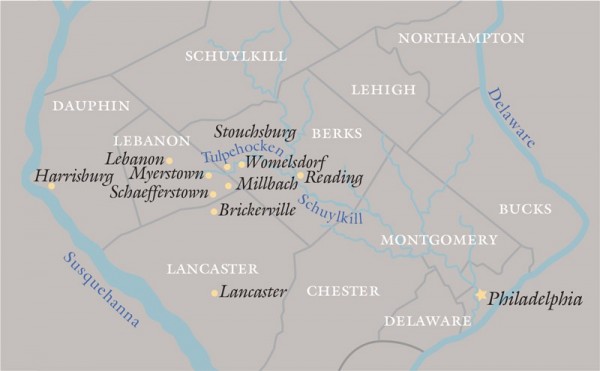
Map of southeastern Pennsylvania showing the location of the Tulpehocken Valley and the counties of Berks, Dauphin, Lancaster, and Lebanon. (Artwork, Nichole Drgan.)

House of Heinrich Zeller, near Newmanstown, Lebanon County, Pennsylvania, built in 1745. (Photo, Laszlo Bodo.) The central chimney and flared kick to the roof are Germanic features.
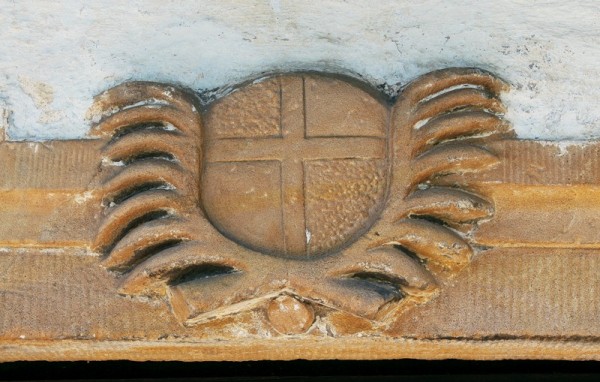
Detail of the door lintel of the Zeller house. (Photo, Laszlo Bodo.) The foliate device framing the shield is similar to that on the stove support illustrated in fig. 9.

Charming Forge Mansion, built for George Ege, near Womelsdorf, Heidelberg Township, Berks County, Pennsylvania, ca. 1783. (Photo, Kurfiss/Sotheby’s International Realty.)

Christ Lutheran Church, near Stouchsburg, Marion Township, Berks County, Pennsylvania, built in 1786. (Courtesy, Mr. and Mrs. Michael Emery.)

St. Luke Lutheran Church, Schaefferstown, Heidelberg Township, Lebanon County, Pennsylvania, built between 1765 and 1767. (Courtesy, Historic Schaefferstown, Inc.) This photograph was taken before 1884, when the church was remodeled.
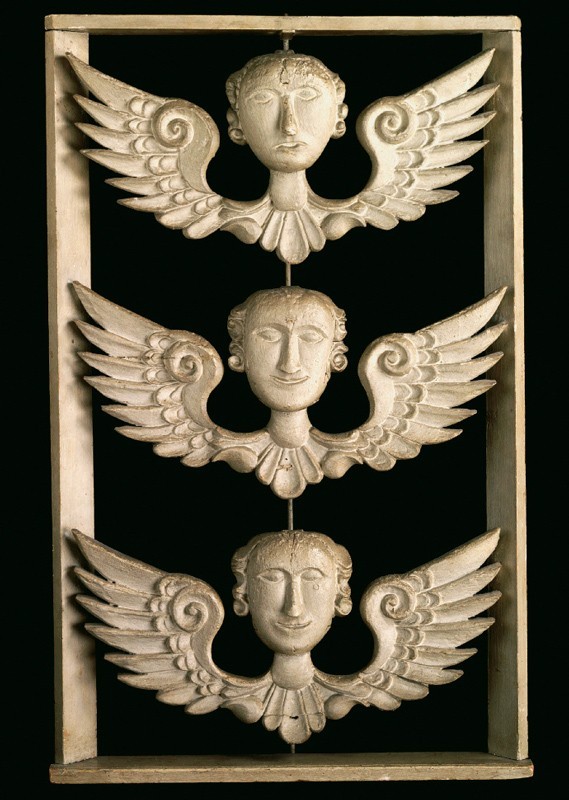
Winged angel heads from St. Luke Lutheran Church, Schaefferstown, Heidelberg Township, Lebanon County, Pennsylvania, ca. 1767. Pine. H. 36", W. 22", D. 6" (framed). (Courtesy, Katharine and Robert Booth; photo, Laszlo Bodo.) The frame is modern.
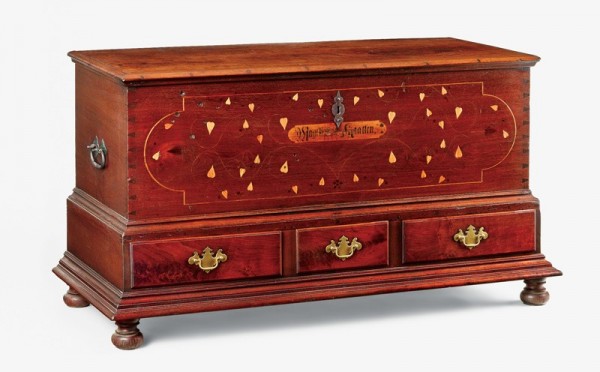
Chest, Elizabeth Township area, Lancaster County, Pennsylvania, ca. 1790. Walnut and mixed-wood inlay (including sumac, maple, holly, and fruitwood) with white pine; iron, brass. H. 30 1/4", W. 55 3/4", D. 24 1/2". (Private collection; photo, Gavin Ashworth.) The lower section, including the drawers, base molding, and feet, is rebuilt.
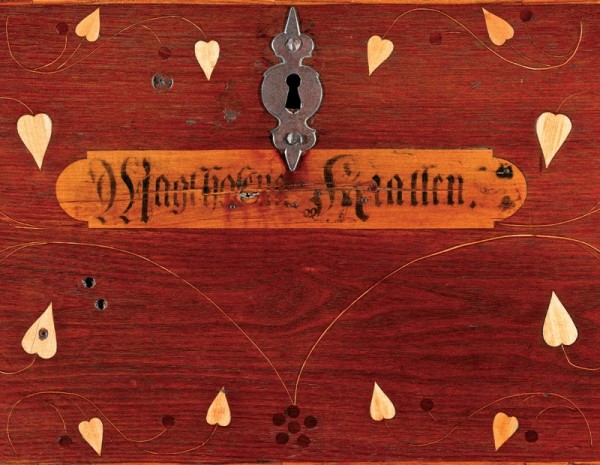
Detail of the inscription on the chest illustrated in fig. 29. (Photo, Gavin Ashworth.)

Tall-case clock, Berks County, Pennsylvania, ca. 1790. Walnut and mixed-wood inlay (including sumac) with white pine; brass, painted sheet iron, iron, bronze, steel; glass. H. 93 1/2", W. 22 1/4", D. 12 1/8". (Courtesy, John J. Snyder Jr.; photo, Gavin Ashworth.) The feet are replaced.

Detail of the inlay on the chest illustrated in fig. 29 (right) and the clock illustrated in fig. 30 (left). (Photos, Gavin Ashworth.)

Tall-case clock with movement by Jacob Diehl (d. 1857), Reading, Berks County, Pennsylvania, ca. 1790. Walnut and mixed-wood inlay with pine; brass, painted sheet iron, iron, bronze, steel; glass. H. 96 1/2", W. 21 1/2", D. 12 1/2". (Courtesy, Metropolitan Museum of Art, purchase, Douglas and Priscilla deForest Williams, Mr. and Mrs. Eric M. Wunsch, and The Sack Foundation Gifts, 1976.279; photo, Gavin Ashworth.)

Detail of the inlay on the clock illustrated in fig. 33. (Photo, Gavin Ashworth.)

Chest, Heidelberg Township area, Lebanon or Berks County, Pennsylvania, 1788. White pine; iron, brass. H. 26 3/4", W. 54", D. 2 1/2@". (Private collection; photo, David Bohl.) The feet are replaced.
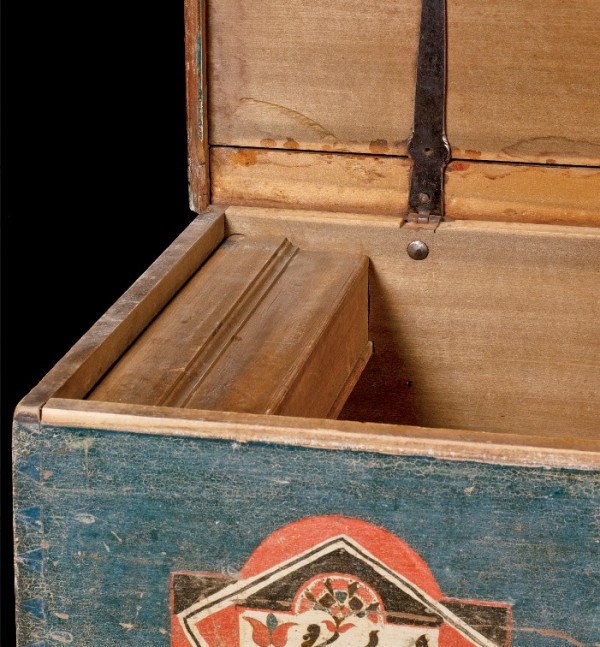
Detail of the till lid inside the chest illustrated in fig. 48. (Photo, Gavin Ashworth.)
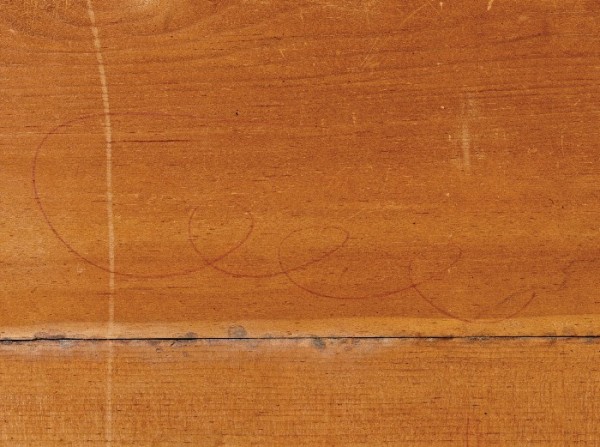
Detail of a crayon mark inside the chest illustrated in fig. 57. (Photo, Gavin Ashworth.)
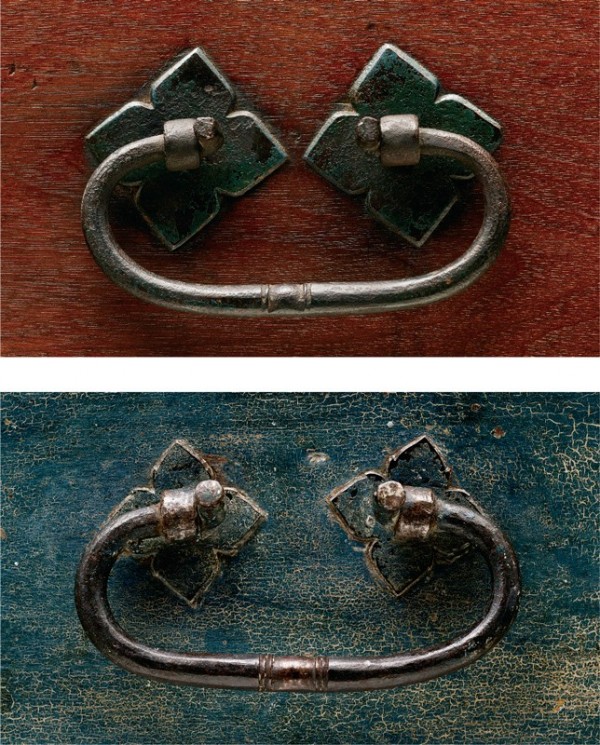
Carrying handles on the chests illustrated in figs. 29 (above) and 48 (below). (Photo, Gavin Ashworth.)
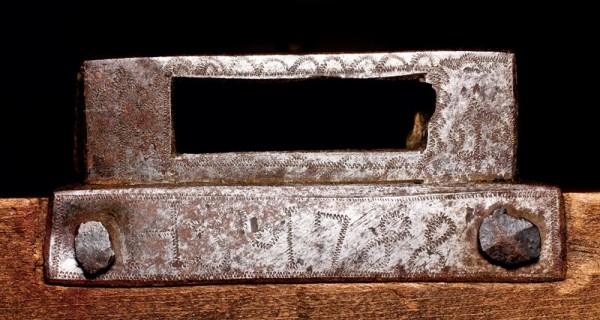
Detail of the lock inside the chest illustrated in fig. 48. (Photo, Gavin Ashworth.)
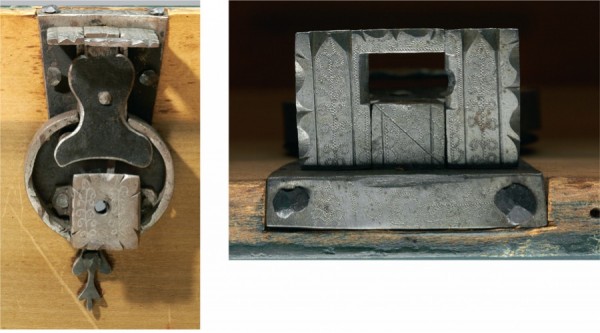
Details of the lock inside the chest illustrated in fig. 52. This lock is similar to the examples shown in fig. 86.
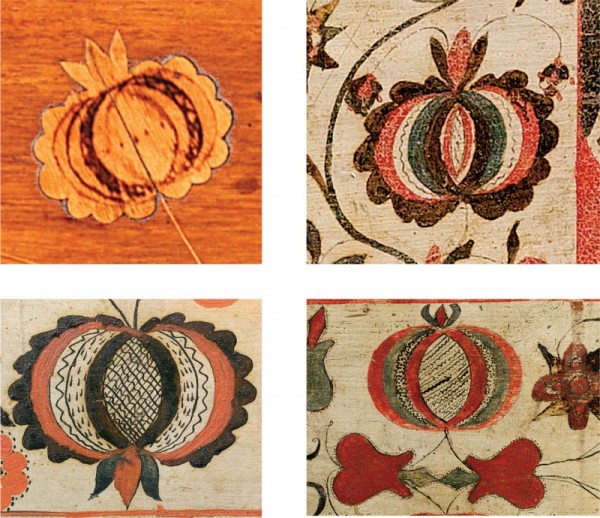
Detail of pomegranate motifs on the chests illustrated in figs. 1, 48, 52, and 55.

Detail of flower motifs on the chests illustrated in figs. 1 and 52.
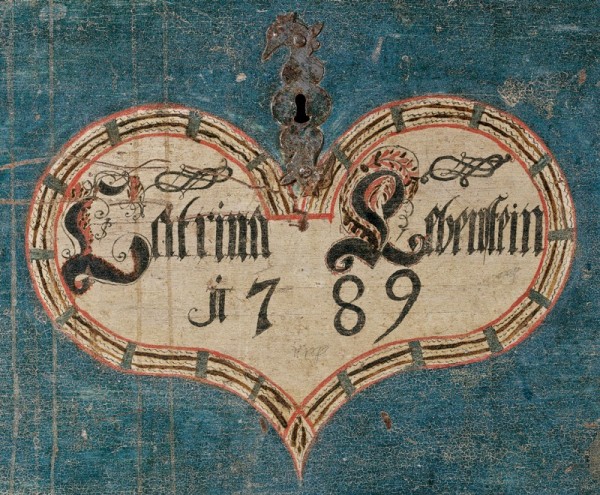
Detail of the inscription on the chest illustrated in fig. 48. (Photo, Gavin Ashworth.)

Detail of the small drawers under the till of the chest illustrated in fig. 76. (Photo, Gavin Ashworth.)

Detail of the decoration and inscription on the chest illustrated in fig. 35. (Photo, David Bohl.)
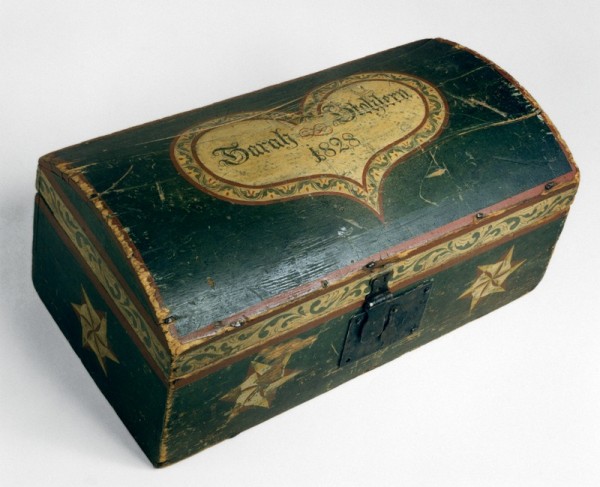
Box, Heidelberg Township area, Lebanon or Berks County, Pennsylvania, 1828. (Courtesy, James and Nancy Glazer.)
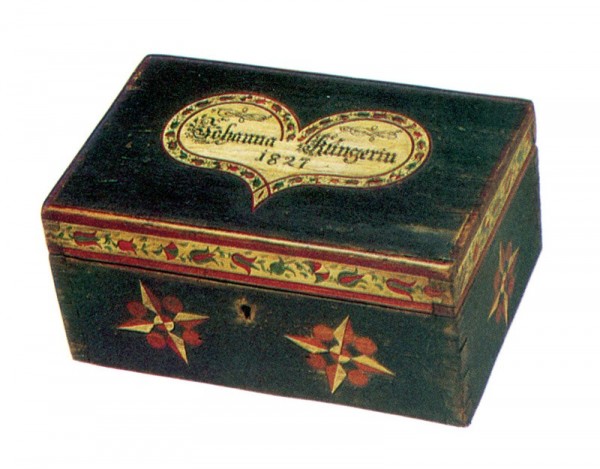
Box, Heidelberg Township area, Lebanon or Berks County, Pennsylvania, 1827. (Private collection; photo, Schecter Lee.)

Chest, Heidelberg Township area, Lebanon or Berks County, Pennsylvania, 1789. Tulip poplar; iron. H. 23 1/2", W. 53 3/4", D. 23". (Private collection; photo, Gavin Ashworth.)
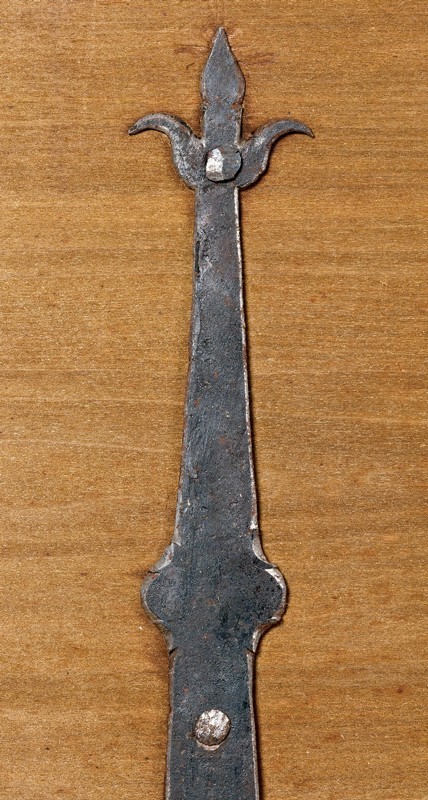
Detail of a hinge inside the chest illustrated in fig. 48. (Photo, Gavin Ashworth.)
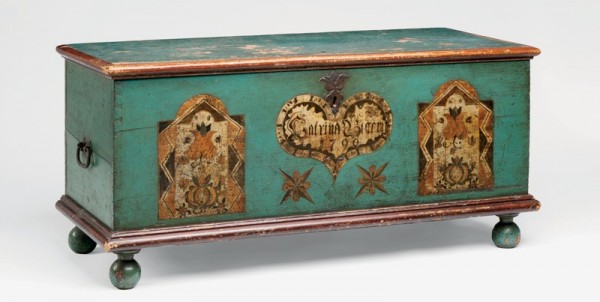
Chest, Heidelberg Township area, Lebanon or Berks County, Pennsylvania, 1790. Pine and tulip poplar; iron. H. 25", W. 54", D. 23 1/2". (Courtesy, Detroit Institute of Arts, USA/The Bridgeman Art Library, 41.127). The feet are replaced.

Chest, Heidelberg Township area, Lebanon or Berks County, Pennsylvania, 1793. Materials and dimensions unrecorded. (Photo, Clarence Spohn.)

Chest, Heidelberg Township area, Lebanon or Berks County, Pennsylvania, ca. 1790. Tulip poplar and pine; iron, brass. H. 26 3/4", W. 52", D. 23 1/8". (Courtesy, a Museum of Fine Arts, Boston trustee and her spouse; photo, Museum of Fine Arts, Boston.)
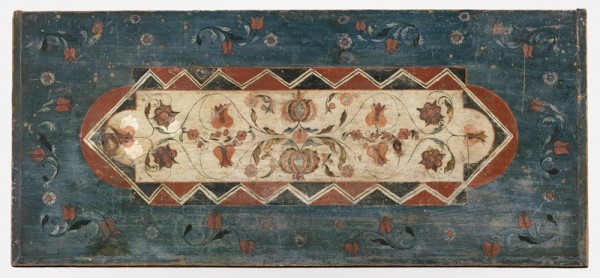
Detail of the lid of the chest illustrated in fig. 52.
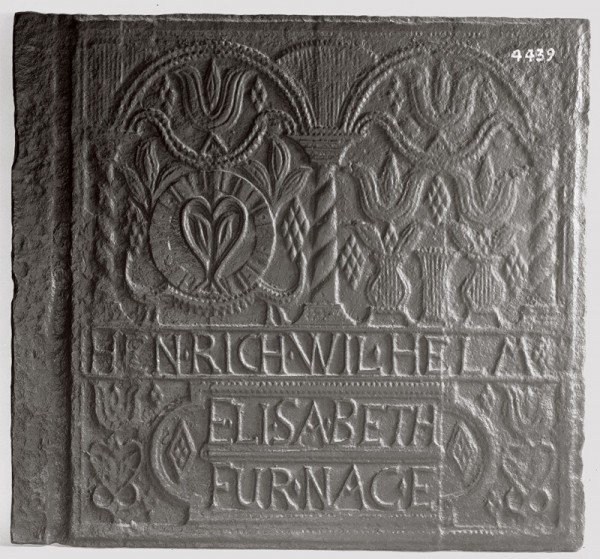
Stove plate, Elisabeth Furnace, Lancaster County, Pennsylvania, ca. 1765. Iron. 23 1/2" x 25 1/2". (Courtesy, Mercer Museum of the Bucks County Historical Society.)
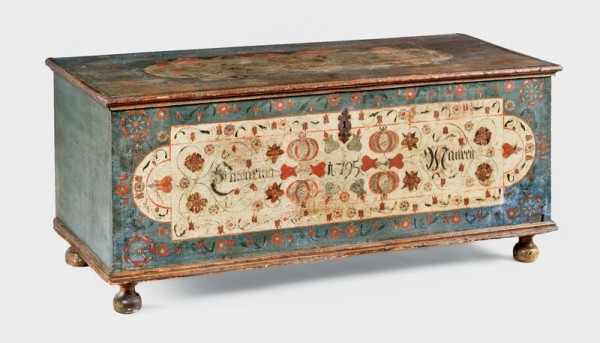
Chest, Heidelberg Township area, Lebanon or Berks County, Pennsylvania, 1795. White pine; iron, brass. H. 22 3/4", W. 50", D. 21 1/2". (Private collection; photo, Gavin Ashworth.) The feet are replaced.
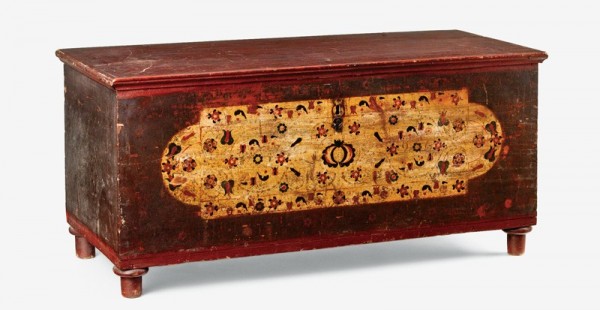
Chest, Heidelberg Township area, Lebanon or Berks County, Pennsylvania, 1796. Tulip poplar; iron. H. 23 3/4", W. 51 1/2", D. 22 3/8". (Private collection; photo, Gavin Ashworth.) The feet are replaced.

Chest, Heidelberg Township area, Lebanon or Berks County, Pennsylvania, ca. 1790. White pine; iron. H. 23 1/2", W. 52", D. 22 1/2". (Private collection; photo, Gavin Ashworth.)
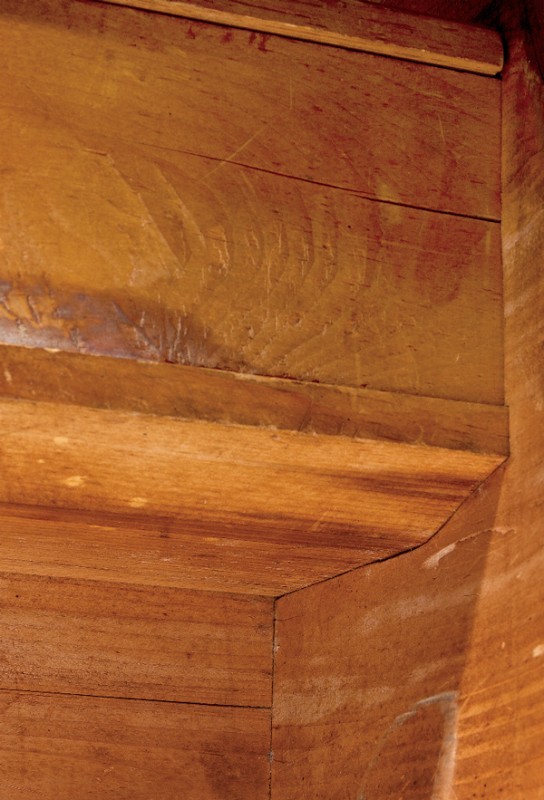
Detail showing the underside of the till of the chest illustrated in fig. 57. (Photo, Gavin Ashworth.)
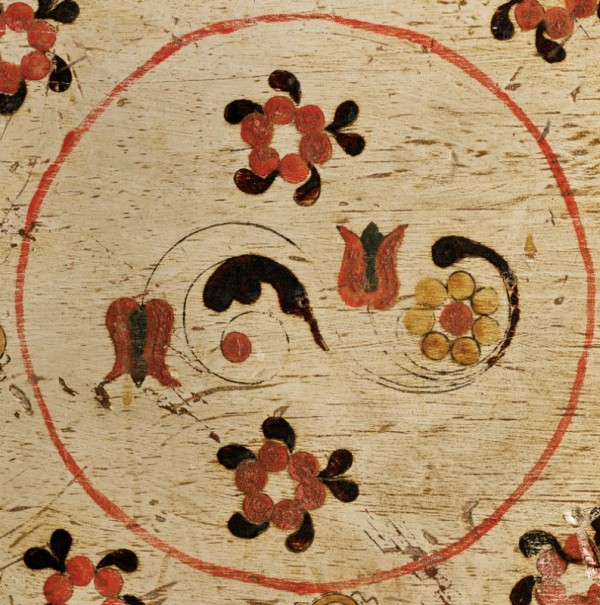
Detail of the end panel of the chest illustrated in fig. 57. (Photo, Gavin Ashworth.)
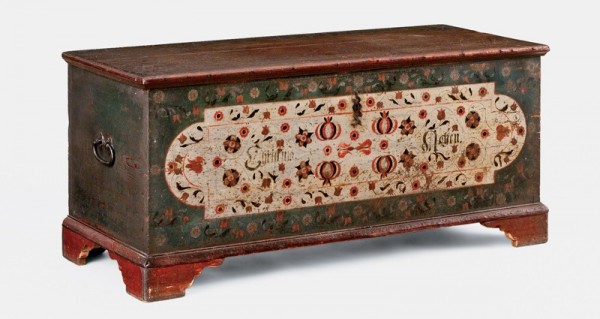
Chest, Heidelberg Township area, Lebanon or Berks County, Pennsylvania, ca. 1790. White pine and tulip poplar; iron. H. 23 1/2", W. 51 5/8", D. 22 1/4". (Private collection; photo, Gavin Ashworth.) The feet are replaced.
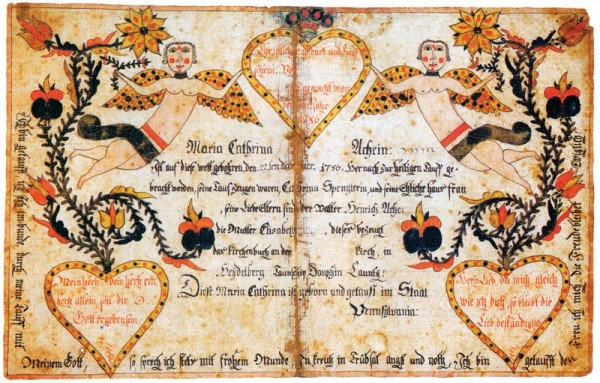
Birth and baptismal certificate for Maria Catharina Ache, attributed to Johann Henrich Goettel (1745–1807), Heidelberg Township area, Lebanon or Berks County, Pennsylvania, ca. 1786. Watercolor and ink on laid paper. 7 3/4" x 12 1/2". (Courtesy, Sotheby’s.)

Chest, Heidelberg Township area, Lebanon or Berks County, Pennsylvania, ca. 1790. White pine and tulip poplar; iron. H. 22", W. 50", D. 21 1/8". (Private collection; photo, Raymond Martinot.)

Zither, attributed to Samuel Ache (1764–1832), Schaefferstown, Heidelberg Township, Dauphin (now Lebanon) County, Pennsylvania, 1788. Maple and pine; iron. H. 1 7/8", W. 3 3/4", L. 37 3/8". (Courtesy, Colonial Williamsburg Foundation, gift of Mrs. Jeannette S. Hamner, 2000.708.1.) The inscription on the side reads “Das Hertze mein, Soll dir Allein, Ergeben sein, Amen das werde Wahr, wir wollen Singen und Spihlen Ein gantzes jahr / Heydelberg Daunschip Dauphin Caunty 27 Den feberwari SAMUEL ACHE 1788” (This heart of mine shall be given to you alone, Amen. That is true we will sing and play an entire year. Heidelberg Township, Dauphin County 27th of February Samuel Ache 1788).

Detail of the inscription on the zither illustrated in fig. 63.
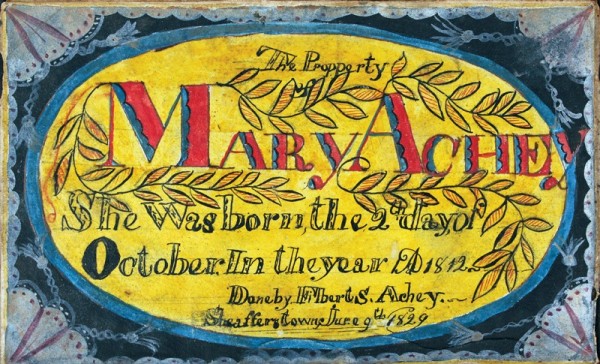
Bookplate for Mary Ache, by Filbert Achey (1812–1832), Schaefferstown, Lebanon County, Pennsylvania, 1829. Watercolor and ink on wove paper. 3 1/4" x 5 1/2". (Courtesy, Dr. and Mrs. Robert M. Kline; photo, Laszlo Bodo.)
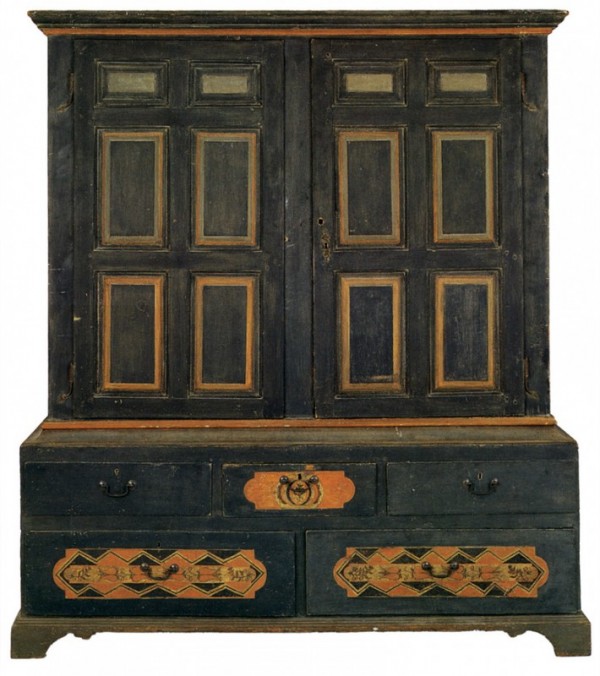
Schrank, Heidelberg Township area, Lebanon or Berks County, Pennsylvania, ca. 1790. Pine; iron, brass. H. 80", W. 70", D. 21". (Courtesy, Pook & Pook.)

Detail of the tulips on the zither illustrated in fig. 63.
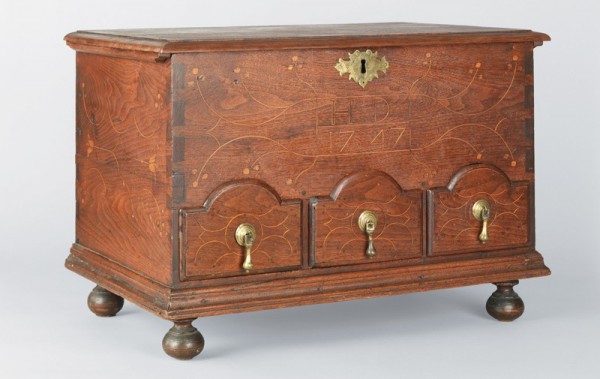
Chest, probably by Moses Pyle (d. 1784), London Grove Township area, Chester County, Pennsylvania, 1747. Walnut and mixed-wood inlay (including sumac, maple, and holly) with white oak, white cedar, and tulip poplar; brass, iron. H. 14 1/4", W. 21 1/8", D. 13 1/2". (Courtesy, Winterthur Museum, partial purchase and partial gift of William R. Smith and sons in memory of Marjorie B. Smith, wife and mother, 2001.19; photo, Laszlo Bodo.) The left drawer is replaced.

Chest façade, Heidelberg Township area, Lebanon or Berks County, Pennsylvania, ca. 1790. White pine; iron. 14 1/2" x 50 3/4". (Private collection; photo, Gavin Ashworth.) The façade retains its original lock (fig. 86).
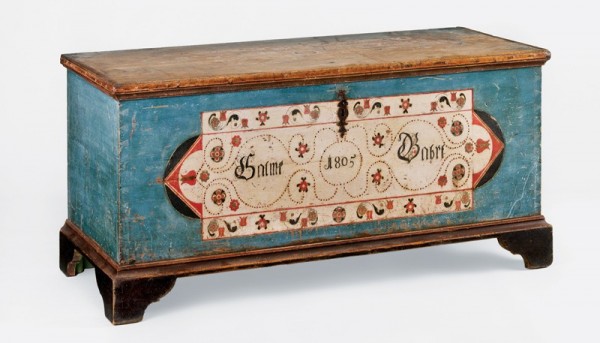
Chest, Heidelberg Township area, Lebanon or Berks County, Pennsylvania, 1805. Pine; iron. H. 23 1/2", W. 52 1/2", D. 23". (Private collection; photo, Gavin Ashworth.) The feet are replaced.
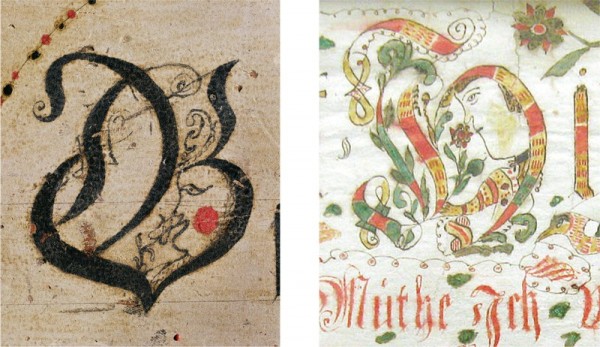
Details showing the painted faces on the chest illustrated in fig. 70 and a fraktur. (Private collection.)
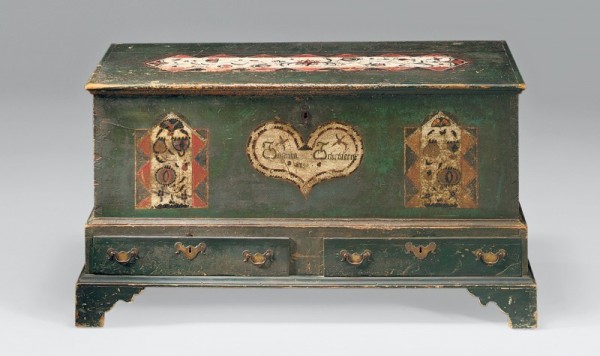
Chest, Heidelberg Township area, Lebanon or Berks County, Pennsylvania, 1790. Pine; iron, brass. H. 29 1/2", W. 53 1/2", D. 23". (Courtesy, Christie’s.) The feet are replaced.

Pair of date boards on the house of Johannes and Anna Maria Bollman and their son George Bollman, Millbach, Heidelberg (now Millcreek) Township, Lebanon County, 1819. (Photo, Laszlo Bodo.) The paint is restored, based on evidence found under a layer of white overpaint.
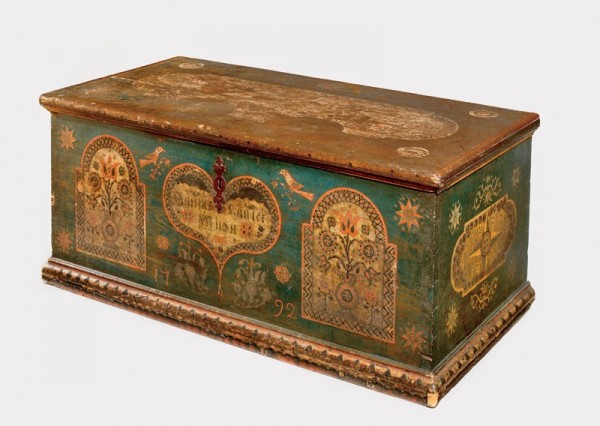
Chest, Heidelberg Township area, Lebanon or Berks County, Pennsylvania, 1792. Tulip poplar; iron. H. 19 1/2", W. 45 1/2", D. 23". (Courtesy, Renfrew Museum and Park, Waynesboro, Pa.; photo, Gavin Ashworth.)
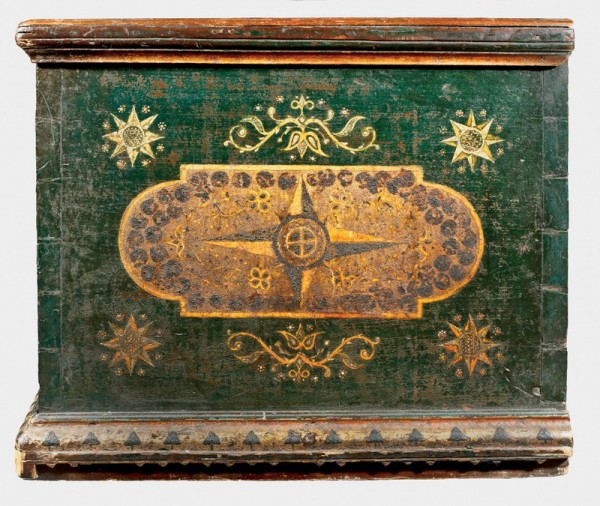
Detail of the end of the chest illustrated in fig. 74. (Photo, Gavin Ashworth.)
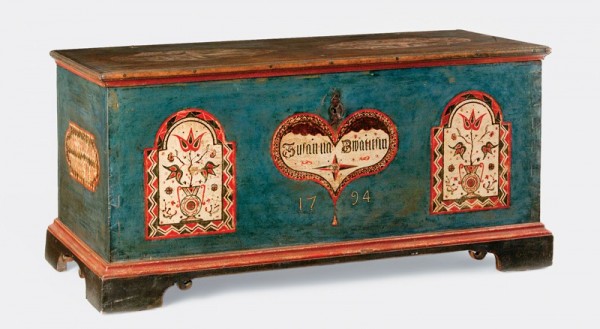
Chest, Heidelberg Township area, Lebanon or Berks County, Pennsylvania, 1794. Tulip poplar; iron. H. 24", W. 50", D. 22 3/4". (Private collection; photo, Gavin Ashworth.)

Detail of the bird drawing on the underside of the till drawer of the chest illustrated in fig. 76. (Photo, Gavin Ashworth.)

Birth and baptismal certificate for George Seibert, attributed to Andreas Kessler, Elizabeth Township, Lancaster County, Pennsylvania, ca. 1815. Watercolor and ink on laid paper. 12 5/8" x 15 3/8". (Private collection; photo, Gavin Ashworth.)
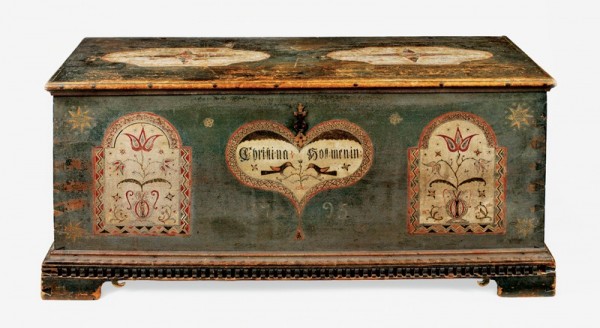
Chest, Heidelberg Township area, Lebanon or Berks County, Pennsylvania, 1795. Tulip poplar and pine; iron. H. 23", W. 50", D. 23". (Courtesy, Peter Tillou; photo, Gavin Ashworth.)

Chest, Heidelberg Township area, Lebanon or Berks County, Pennsylvania, 1795. Tulip poplar and pine; iron, brass. H. 26 3/4", W. 51 1/2", D. 23 1/4". (Private collection; photo, Milly McGehee.)

Chest, Heidelberg Township area, Lebanon or Berks County, Pennsylvania, 1798. Tulip poplar; iron. H. 24 5/8", W. 51 1/2", D. 23". (Courtesy, Historical Society of Berks County Museum and Library, Reading, Pa.; photo, Gavin Ashworth.)

Chest, Heidelberg Township area, Lebanon or Berks County, Pennsylvania, 1792. Tulip poplar and pine; iron, brass. H. 21 7/8", W. 51 1/2", D. 23". (Courtesy, Milwaukee Art Museum, Layton Art Collection, L2000.1; photo, Larry Sanders.)

Chest, Heidelberg Township area, Lebanon or Berks County, Pennsylvania, 1793. White pine and tulip poplar; iron. H. 22 1/4", W. 51 1/4", D. 21 3/4". (Courtesy, Greg K. Kramer Antiques; photo, Gavin Ashworth.)

Chest, Heidelberg Township area, Lebanon or Berks County, Pennsylvania, 1797. White pine; iron. H. 22", W. 50 1/2", D. 21 3/4". (Courtesy, Olde Hope Antiques; photo, Gavin Ashworth.)
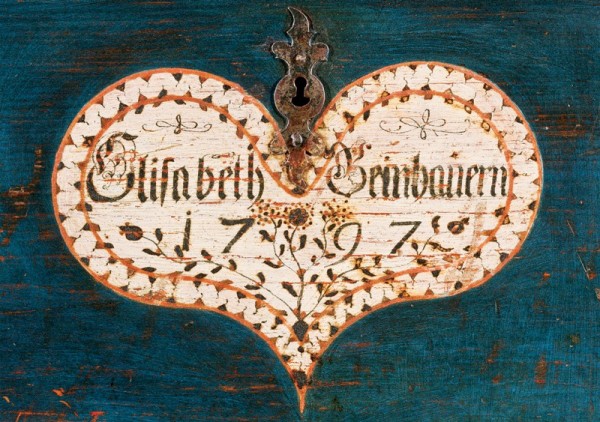
Detail of the decoration and inscription on the chest illustrated in fig. 84. (Photo, Gavin Ashworth.)

Details showing the tops and inner surfaces of three locks, the center example installed on the chest illustrated in fig. 69, probably by Henry Seiler (d. 1785) or Henry Seiler Jr. (b. 1772), Lebanon, Lebanon County, ca. 1780–1790. (Courtesy, Sidney Gecker and Philip H. Bradley Co.; photo, Gavin Ashworth.)
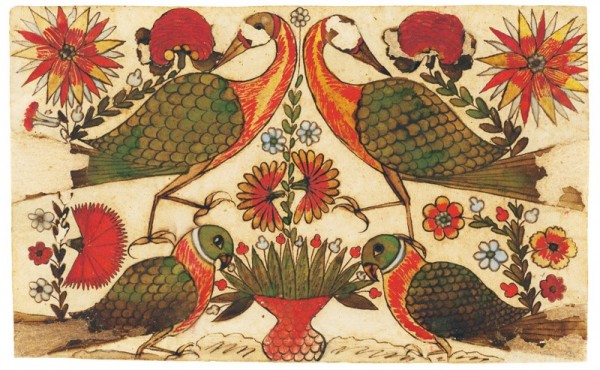
Drawing, attributed to Henrich Otto (1733–ca. 1799), probably Lancaster County, Pennsylvania, 1775–1785. Watercolor and ink on laid paper. 7 3/4" x 12 5/8". (Courtesy, Philadelphia Museum of Art, gift of George H. Lorimer, 25-95-2.)
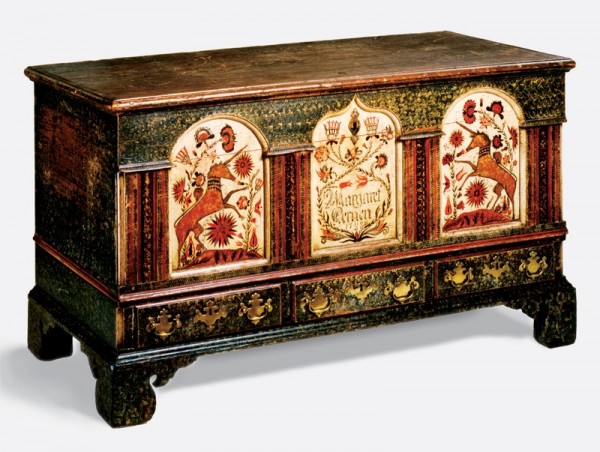
Chest, probably Alsace or Windsor Township area, Berks County, Pennsylvania, 1788. Tulip poplar; iron, brass. H. 28 3/8", W. 50", D. 24". (Courtesy, Winterthur Museum, bequest of Henry Francis du Pont, 1959.2804.) The feet are replaced.

Chest, probably Rapho Township area, Lancaster County, Pennsylvania, 1782. Tulip poplar and pine; iron. H. 23", W. 53 1/2", D. 21 5/8". (Courtesy, Philadelphia Museum of Art, gift of George H. Lorimer, 25-95-1; photo, Gavin Ashworth.) The feet are replaced.

Chest, probably Berks County, Pennsylvania, 1803. Tulip poplar and pine; iron, brass. H. 27", W. 50", D. 22". (Private collection; photo, Pook & Pook.)
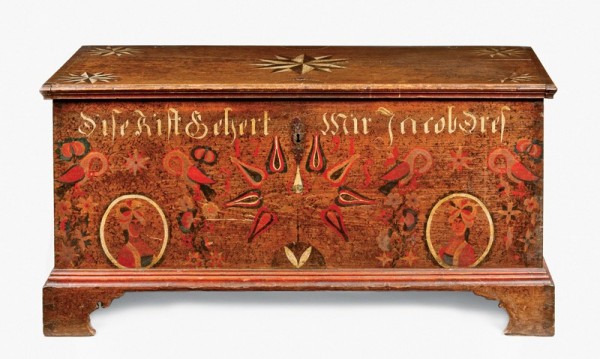
Chest, probably by John Flory (1767–1836), Rapho Township, Lancaster County, Pennsylvania, 1791. Tulip poplar and pine; iron. H. 25", W. 50", D. 24". (Courtesy, Philadelphia Museum of Art, Titus C. Geesey Collection, 58-110-1; photo, Gavin Ashworth.)

Bookplate for Elisabetha Beck, by Henrich Otto (1733–ca. 1799), probably Lancaster County, Pennsylvania, 1772. Watercolor and ink on laid paper. 6 1/8" x 13 1/2". (Courtesy, Schwenkfelder Library & Heritage Center, Pennsburg, Pa.; photo, Gavin Ashworth.) The tapering spiral motif after Otto’s signature, which he often used for embellishment or to fill space, is related to similar designs used to mark the inside of some chests (see fig. 37).
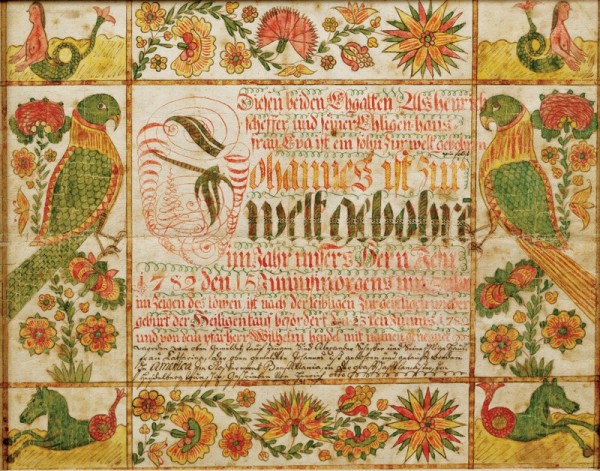
Birth and baptismal certificate for Johannes Schaeffer, by Henrich Otto (1733–ca. 1799), Schaefferstown, Heidelberg Township, Lancaster (now Lebanon) County, Pennsylvania, ca. 1782. Watercolor and ink on laid paper. 12 5/8" x 15 3/4". (Courtesy, Metropolitan Museum of Art, gift of Mrs. Robert W. de Forest, 1933, 34.100.66; photo, Gavin Ashworth.)

Details of the pomegranate motifs on the chest illustrated in fig. 48 and the fraktur illustrated in fig. 18.
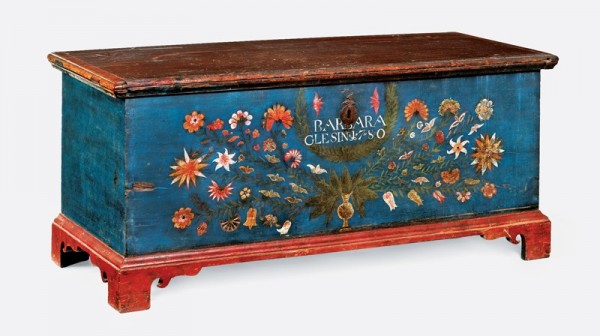
Chest, painted decoration attributed to Henrich Otto (1733–ca. 1799), Earl Township area, Lancaster County, Pennsylvania, 1780. Tulip poplar with oak and walnut; iron. H. 23", W. 50 1/2", D. 21 1/4". (Courtesy, State Museum of Pennsylvania, Pennsylvania Historical and Museum Commission, 73.163.83; photo, Gavin Ashworth.)

Detail of the floral motifs on the chest illustrated in fig. 95. (Photo, Gavin Ashworth.)
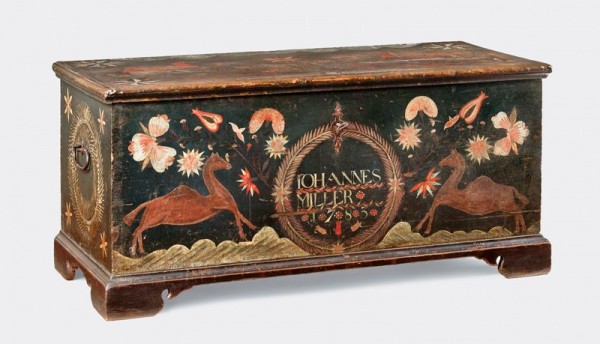
Chest, painted decoration attributed to Henrich Otto (1733–ca. 1799), Millbach area, Heidelberg Township, Lancaster County (now Millcreek Township, Lebanon County), Pennsylvania, 1783. Tulip poplar; iron. H. 23 1/8", W. 49 3/4", D. 22 1/8". (Private collection; photo, Gavin Ashworth.) The feet are replaced.

Detail of the lid on the chest illustrated in fig. 97. (Photo, Gavin Ashworth.)

Chest, painted decoration probably by Henrich Otto (1733–ca. 1799), Earl Township area, Lancaster County, Pennsylvania, 1772. Tulip poplar; iron. H. 24 5/8", W. 52 1/8", D. 22 1/2". (Private collection; photo, Gavin Ashworth.)
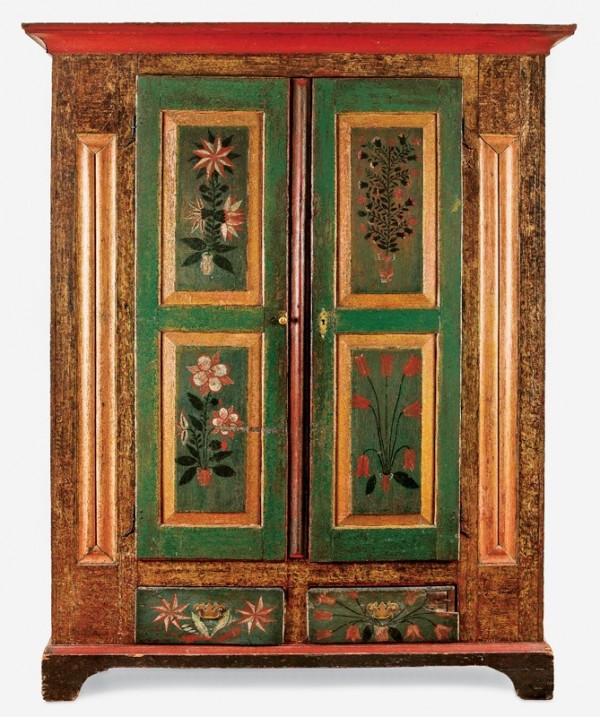
Schrank, painted decoration probably by Henrich Otto (1733–ca. 1799), probably Earl Township area, Lancaster County, Pennsylvania, ca. 1775. Tulip poplar; iron, brass. H. 82", W. 64", D. 19". (Private collection; photo, Gavin Ashworth.)

Details showing the flowers on the chests illustrated in figs. 95, 97, 99; schrank in fig. 100; and fraktur in figs. 92 and 93.
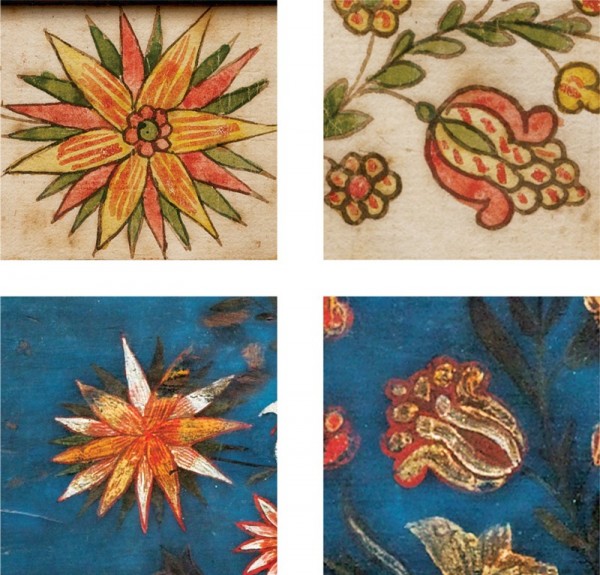
Details showing flowers on the fraktur illustrated in fig. 93 and the chest illustrated in fig. 95.

Details showing the letters and dates on the fraktur illustrated in fig. 92 and the chests illustrated in figs. 95 and 97.
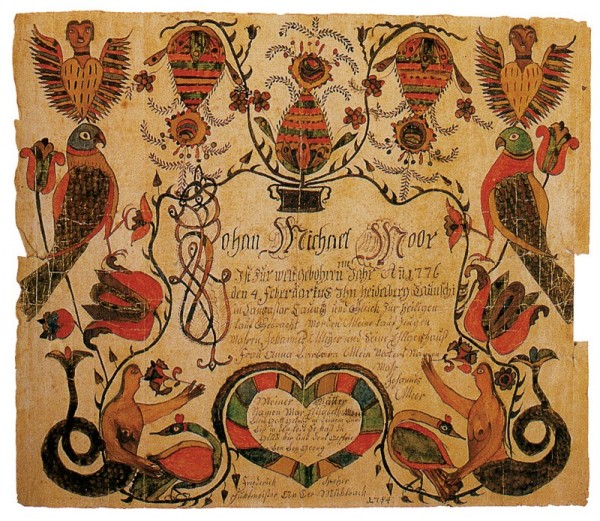
Birth and baptismal certificate for Johann Michael Moor (b. 1776) by Friedrich Speyer (act. ca. 1774–1801), Millbach, Lebanon County, Pennsylvania, 1784. Watercolor and ink on laid paper. 13" x 16". (Private collection; photo, Irwin Richman.) The certificate is signed by Speyer and inscribed “Schulmeister au der Mühlbach” (Schoolmaster on the Mill Creek).

Birth and baptismal certificate for William Heiser (b. 1843), infill by Conrad Otto (ca. 1770–1857) on a form printed by Gustav S. Peters in Harrisburg, Dauphin County, Pennsylvania, ca. 1840. Watercolor and ink on wove paper. 16 1/2" x 12 7/8". (Courtesy, Philip and Muriel Berman Museum of Art at Ursinus College, Pennsylvania Folklife Society Collection, PAG1998.218; photo, Glenn Holcombe.)
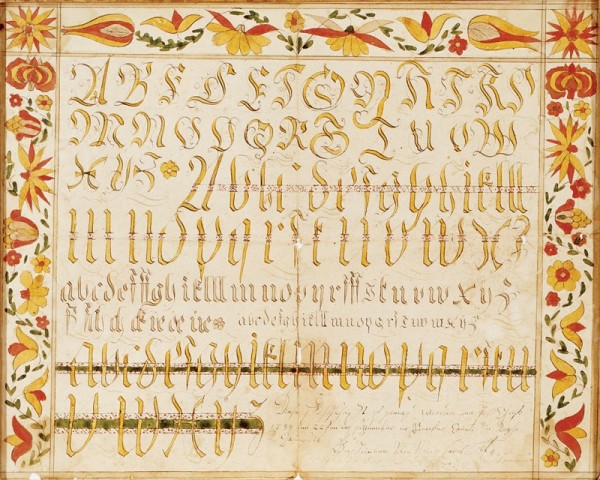
Writing sample, by Jacob Otto (ca. 1762–ca. 1825), Rapho Township, Lancaster County, Pennsylvania, 1795. Watercolor and ink on laid paper. 16 3/4" x 21". (Private collection; photo, Winterthur Library, Joseph Downs Collection of Manuscripts and Printed Ephemera, Frederick S. Weiser Collection.)

Birth and baptismal certificate for Maria Breneise (b. 1770), infill and decoration by Jacob Otto (ca. 1762–ca. 1825) on a form printed at Ephrata, Lancaster County, Pennsylvania, 1784. Watercolor and ink on laid paper. 13 3/8" x 16 5/8". (Courtesy, Philadelphia Museum of Art, gift of J. Stogdell Stokes, 28-10-91.)
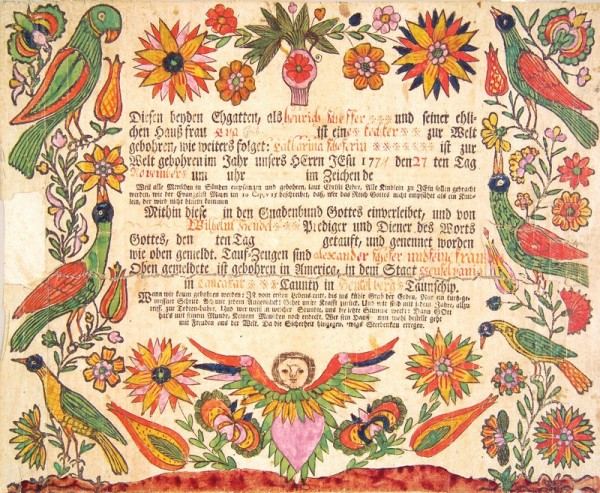
Birth and baptismal certificate for Catharina Schaeffer (b. 1774), infill and decoration attributed to Jacob Otto (ca. 1762–ca. 1825) on a form printed at Ephrata, Lancaster County, Pennsylvania, ca. 1787. Watercolor and ink on laid paper. 12 1/2" x 15 3/4". (Courtesy, Philip and Muriel Berman Museum of Art at Ursinus College, Pennsylvania Folklife Society Collection, pag1998.156.) The vase with cluster of leaves is similar to that on the chest illustrated in fig. 95. Although the flowers on this fraktur are quite similar to those on examples signed by Henrich Otto, there is a slightly heavier feel to them, suggesting that Jacob Otto both infilled and embellished this work.
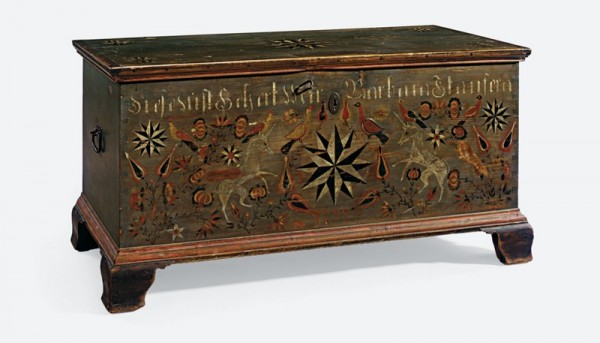
Chest, probably by John Flory (1767–1836), Rapho Township, Lancaster County, Pennsylvania, 1799. Pine; iron. H. 26", W. 52 1/4", D. 24". (Private collection; photo, Christie’s Images/Bridgeman Art Library.)
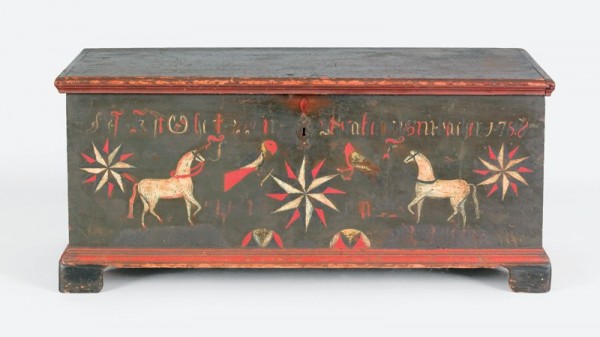
Chest, probably by John Flory (1767–1836), Rapho Township, Lancaster County, Pennsylvania, 1788. Pine; iron. H. 21 1/2", W. 50", D. 21 1/2". (Private collection; photo, Pook & Pook.)
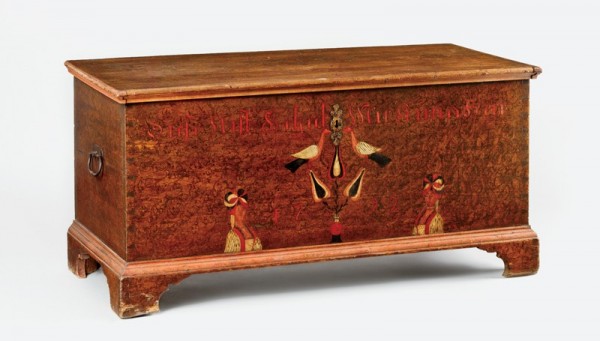
Chest, probably by John Flory (1767–1836), Rapho Township area, Lancaster County, Pennsylvania, 1792. White pine; iron. H. 24 1/2", W. 50", D. 23". (Private collection; photo, Gavin Ashworth.)
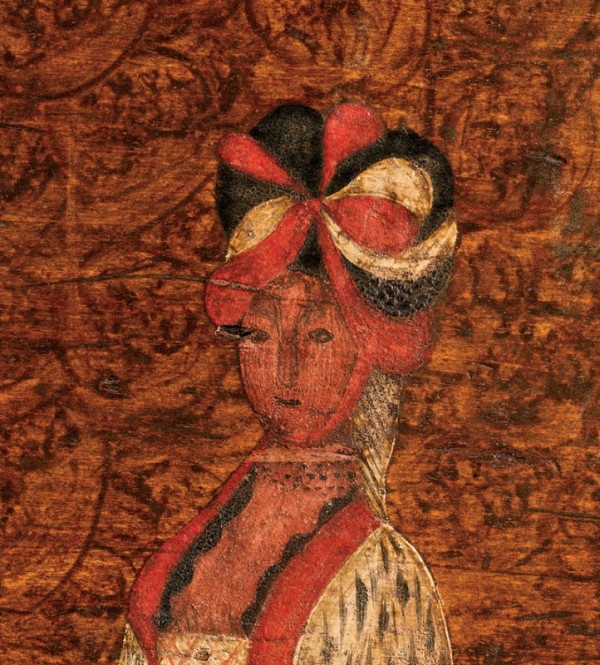
Detail of the chest illustrated in fig. 111. (Photo, Gavin Ashworth.)
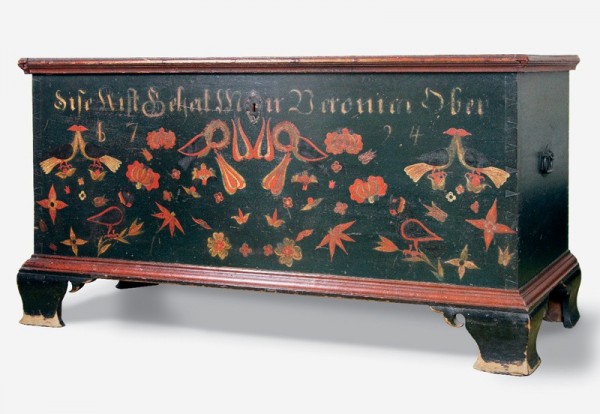
Chest, probably by John Flory (1767–1836), Rapho Township, Lancaster County, Pennsylvania, 1794. Pine; iron. H. 26 1/4", W. 50", D. 23". (Courtesy, American Museum in Britain, Bath, UK.)
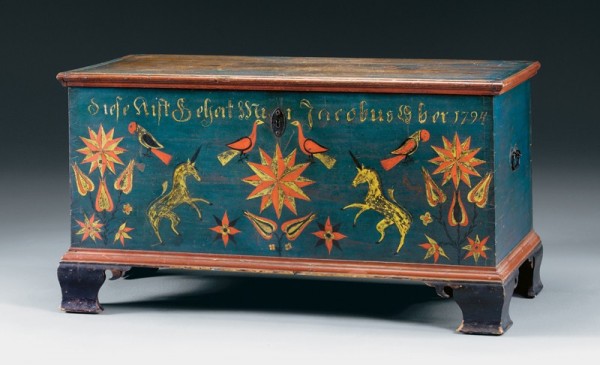
Chest, probably by John Flory (1767–1836), Rapho Township, Lancaster County, Pennsylvania, 1794. Pine; iron. H. 22 1/2", W. 51 3/4", D. 22". (Private collection; photo, courtesy of Christie’s Images/Bridgeman Art Library.)
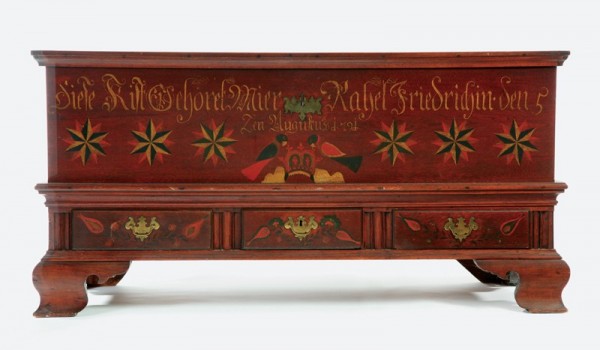
Chest, possibly by Jacob Otto (ca. 1762–ca. 1825), Rapho Township area, Lancaster County, Pennsylvania, 1791. Walnut with pine and walnut; brass, iron. H. 27 5/8", W. 56", D. 26". (Courtesy, G. W. Samaha; photo, Rob Manko.)

Birth and baptismal certificate for Anna Maria Haberack, by William Otto (1761–1841), Lower Mahantongo Township, Schuylkill County, Pennsylvania, 1834. Watercolor and ink on wove paper. 12" x 15 1/4". (Private collection; photo, Gavin Ashworth.)

Chest, attributed to William Otto (1761–1841), Lower Mahantongo Township, Schuylkill County, Pennsylvania, 1812. Pine; iron, brass. H. 23 1/4", W. 52 3/4", D. 18 1/4". (Courtesy, National Museum of American History, Smithsonian Institution.)

Chest, attributed to William Otto (1761–1841), Lower Mahantongo Township, Schuylkill County, Pennsylvania, 1814. Tulip poplar and white pine; iron. H. 22 5/8", W. 51", D. 22 1/2". (Courtesy, Olde Hope Antiques; photo, Gavin Ashworth.)
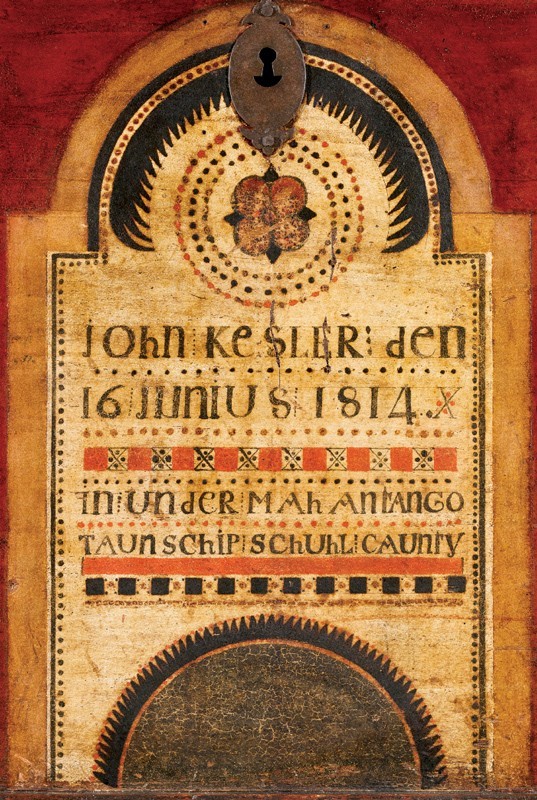
Detail of the chest illustrated in fig. 118. (Photo, Gavin Ashworth.)
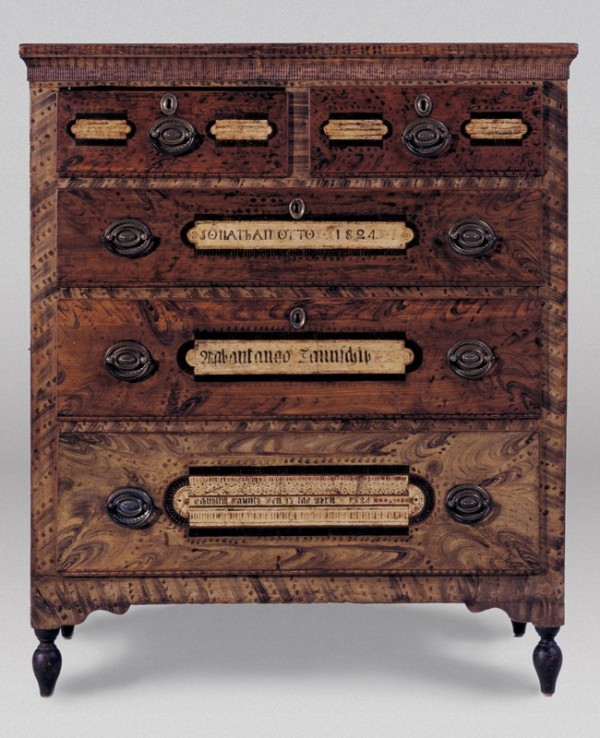
Chest of drawers, attributed to William Otto (1761–1841), Lower Mahantongo Township, Schuylkill County, Pennsylvania, 1824. Pine; brass. H. 44", W. 40", D. 19". (Private collection; photo, Olde Hope Antiques.) The feet are replaced.

Birth and baptismal certificate for Christian Zimmerman (b. 1799), attributed to Daniel Otto (ca. 1770–ca. 1820), probably Centre County, Pennsylvania, ca. 1815. Watercolor and ink on laid paper 7 1/2" x 12 1/2". (Courtesy, a trustee of the Museum of Fine Arts, Boston and her spouse; photo, Museum of Fine Arts, Boston.)

Drawing, attributed to Daniel Otto (ca. 1770–ca. 1820), probably Centre County, Pennsylvania, ca. 1815. Watercolor, pencil, and ink on laid paper. 8 1/8" x 13 1/4". (Courtesy, Colonial Williamsburg Foundation, 1959.305.2.)

Drawing, attributed to Henrich Otto (1733–ca. 1799), probably Lancaster County, Pennsylvania, ca. 1780. Watercolor and ink on laid paper. 13 1/8" x 16 1/2". (Courtesy, Metropolitan Museum of Art, gift of Edgar William and Bernice Chrysler Garbisch, 1966.66.242.1; photo, Gavin Ashworth.)
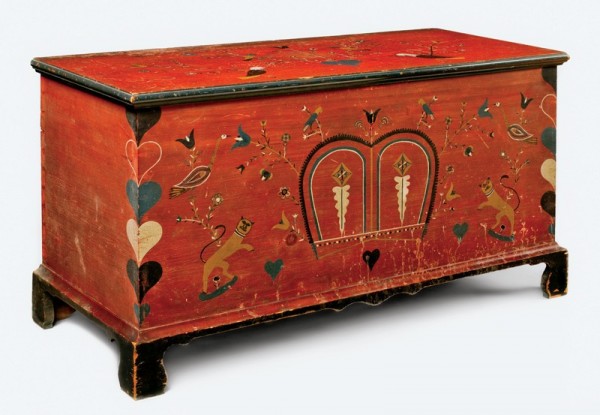
Chest, painted decoration probably by Daniel Otto (ca. 1770–ca. 1820), probably Centre County, Pennsylvania, ca. 1815. White pine and tulip poplar; iron. H. 27", W. 50", D. 21". (Private collection; photo, Gavin Ashworth.)
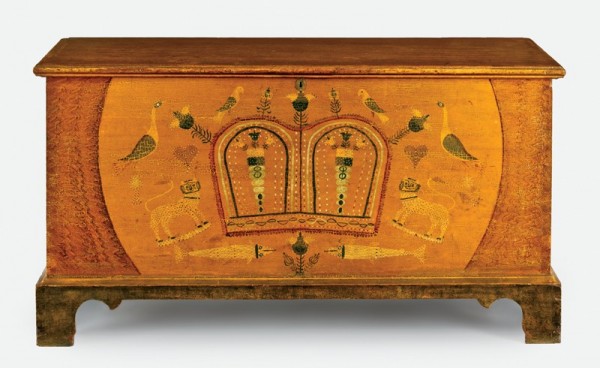
Chest, probably Centre County, Pennsylvania, ca. 1815. White pine; iron, brass. H. 27 1/2", W. 50 3/4", D. 21 7/8". (Courtesy, Barnes Foundation; photo, Gavin Ashworth.)
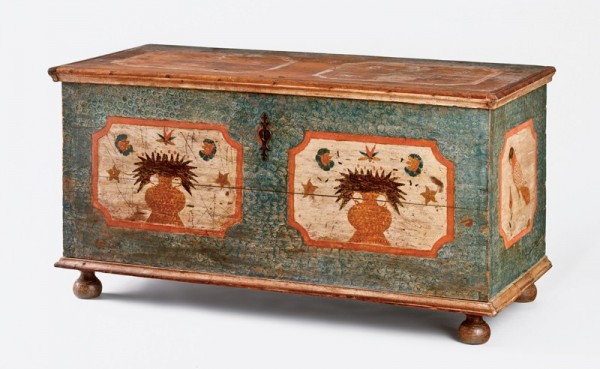
Chest, probably Lancaster or Centre County, Pennsylvania, 1790–1815. Tulip poplar; iron. H. 23 1/2", W. 48", D. 20 3/4". (Private collection; photo, Gavin Ashworth.) The feet are replaced.

Details showing the lions on the chests illustrated in figs. 124–26. (Photo, Gavin Ashworth.)
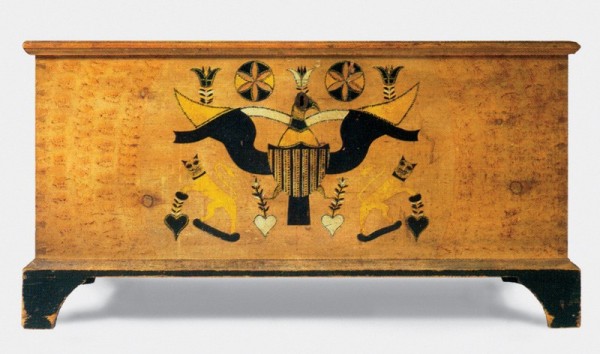
Chest, painted decoration probably by Daniel Otto (ca. 1770–ca. 1820), probably Centre County, Pennsylvania, ca. 1815. Pine; iron. H. 24 3/4", W. 48", D. 23". (Private collection; photo, Sotheby’s.)

Tall-case clock with case by Baltzer Heydrich (1765–1846) and movement by Abraham Swartz, Lower Salford Township, Montgomery County, Pennsylvania, 1823. Cherry with mixed-wood inlays; brass, painted sheet iron, iron, bronze, steel; glass. H. 90 1/2", W. 21 7/8", D. 11 1/4". (Courtesy, Schwenkfelder Library and Heritage Center, Pennsburg, Pa. gift of Mr. and Mrs. Robert Calhoun; photo, Gavin Ashworth.) Inside the pendulum door the date “October 18th 1823” is written in chalk.
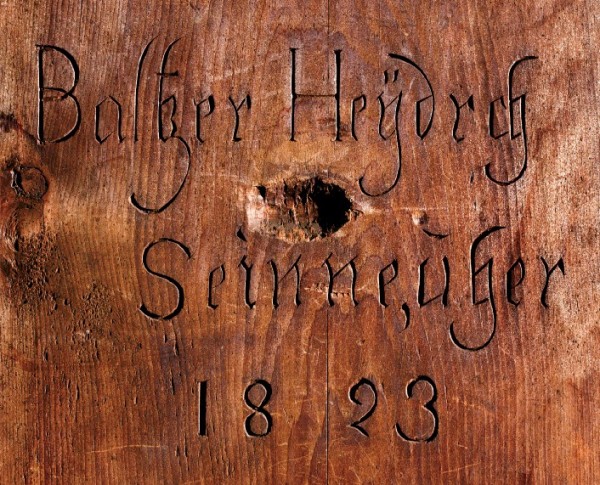
Detail of the inscription inside the clock illustrated in fig. 129. (Photo, Gavin Ashworth.)
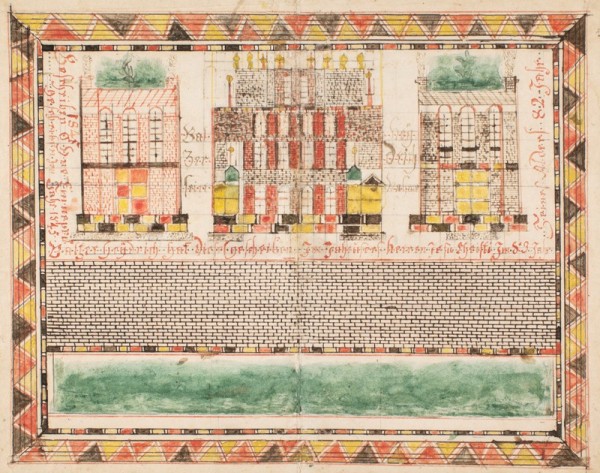
Drawing, by Baltzer Heydrich (1765–1846), Lower Salford Township, Montgomery County, Pennsylvania, 1845. Watercolor and ink on wove paper. 12 7/8" x 16 3/4". (Courtesy, Winterthur Museum, 1959.141; photo, Jim Schneck.)
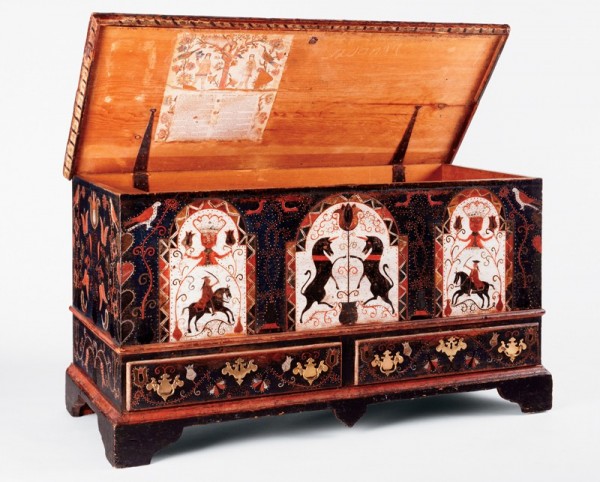
Chest with printed broadside decorated by Friedrich Speyer (act. ca. 1774–1801), Probably Bern Township, Berks County, Pennsylvania, ca. 1790. White pine; iron, brass. H. 28", W. 50 5/8", D. 22 3/4". (Courtesy, Winterthur Museum, 1955.95.1; photo, Gavin Ashworth.)

Tall-case clock with movement by Heinrich Rentzheimer, Salisbury Township, Lehigh County, Pennsylvania, ca. 1788. Walnut with pine; watercolor and ink on laid paper; brass, painted sheet iron, iron, bronze, steel; glass. H. 99", W. 23 3/4", D. 12 1/2". (Courtesy, James and Nancy Glazer.) The bottom third of the lower section and the feet are rebuilt.
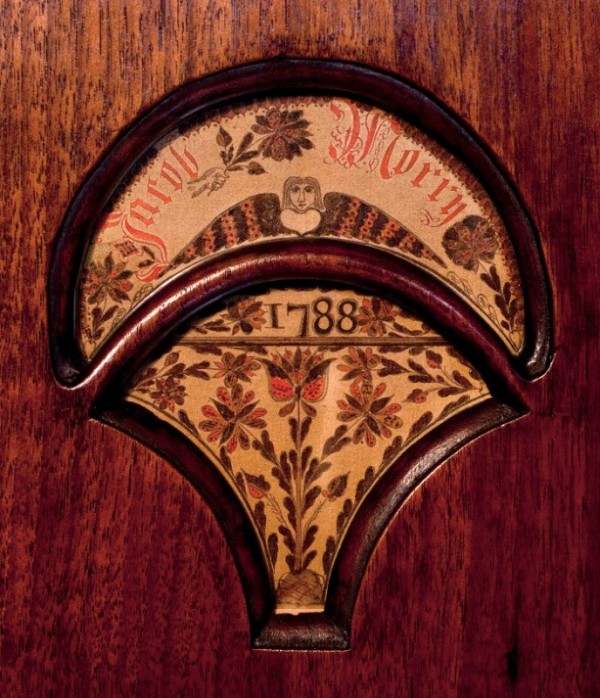
Detail of the fraktur in the waist door of the clock illustrated in fig. 133.

Chest of drawers, Mahantongo Valley, Northumberland County, Pennsylvania, ca. 1835. Tulip poplar and yellow pine; brass. H. 52 1/2", W. 44", D. 20". (Courtesy, Katharine and Robert Booth; photo, Gavin Ashworth.)

Details showing an angel on a fraktur printed by Henrich Ebner, Allentown, Lehigh County, Pennsylvania, ca. 1820 and the chest illustrated in fig. 135. (Courtesy, Katharine and Robert Booth; photo, Gavin Ashworth.)

Kitchen cupboard, Mahantongo Valley, Northumberland County, Pennsylvania, 1830. Tulip poplar and pine; glass; brass. H. 83 1/4", W. 66", D. 33 1/2". (Courtesy, Philadelphia Museum of Art, Titus C. Geesey Collection, 54-85-32a,b; photo, Gavin Ashworth.)

Details showing the angel on the broadside of the poem Concordia printed by Daniel P. Lange and the angels on the door of the cupboard illustrated in fig. 137, Hanover, Adams County, Pennsylvania, ca. 1825. (Courtesy, York County Heritage Trust.) Printer John S. Wiestling of Harrisburg, Dauphin County, also used similar angels.
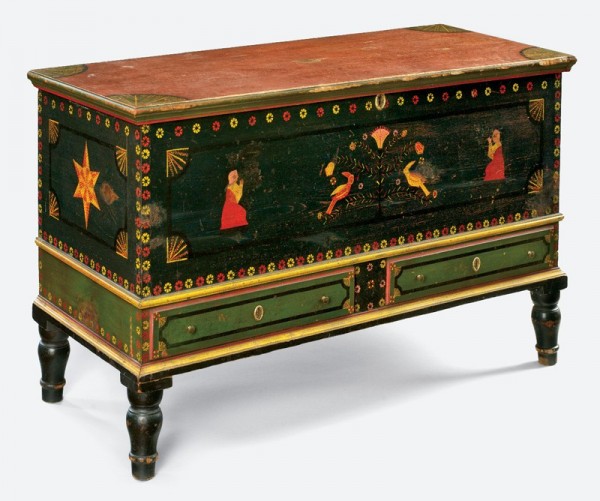
Chest, Mahantongo Valley, Northumberland County, Pennsylvania, ca. 1835. Yellow pine and tulip poplar; iron, brass. H. 28 1/2", W. 49 7/8", D. 21". (Courtesy, Katharine and Robert Booth; photo, Gavin Ashworth.) The drawers are false.
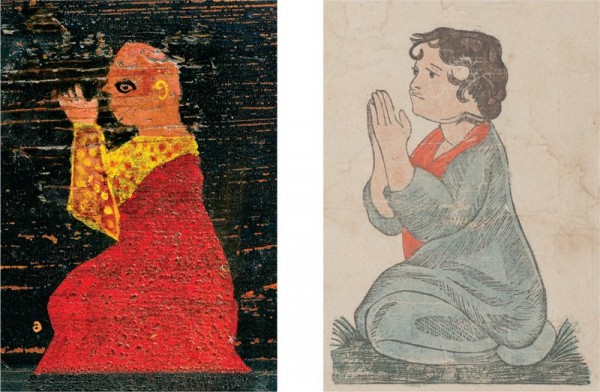
Details of a praying child on the chest illustrated in fig. 139 and a praying child from a birth and baptismal certificate with printing attributed to Jacob Schnee, Lebanon, Lebanon County, Pennsylvania, ca. 1815. (Courtesy, Rare Book Department, Free Library of Philadelphia.)
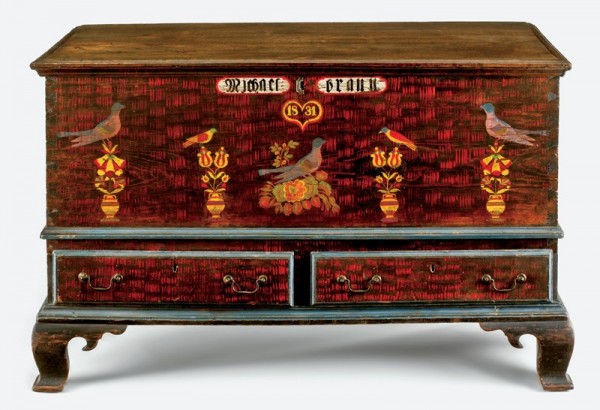
Chest, Mahantongo Valley, Northumberland County, Pennsylvania, 1831. Yellow pine and tulip poplar; iron, brass. H. 29 7/8", W. 50", D. 23". (Courtesy, Katharine and Robert Booth; photo, Gavin Ashworth.) The feet are replaced.

Birth and baptismal certificate for Elisabeth Baumgardner (b. 1812), by Johann Valentin Schuller Jr. (1759–ca. 1816), on a form probably printed in Reading, Berks County, Pennsylvania, ca. 1811. Watercolor and ink on laid paper. 7 1/2" x 12 3/8". (Courtesy, Philip and Muriel Berman Museum of Art at Ursinus College, Pennsylvania Folklife Society Collection, PAG1998.173.)
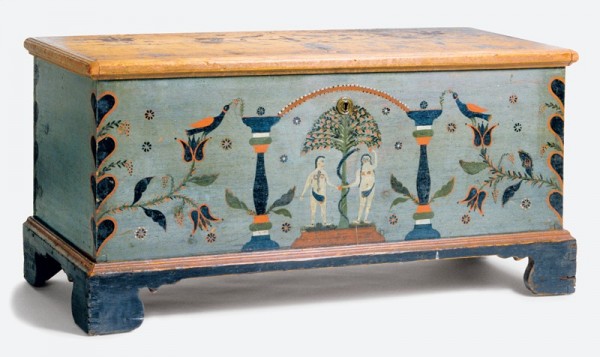
Chest, probably Mahantongo Valley, Northumberland County or Centre County, Pennsylvania, 1800–1820. Pine; iron, brass. H. 24 3/4", W. 50", D. 17 3/4". (Courtesy, Winterthur Museum, 1957.99.4).
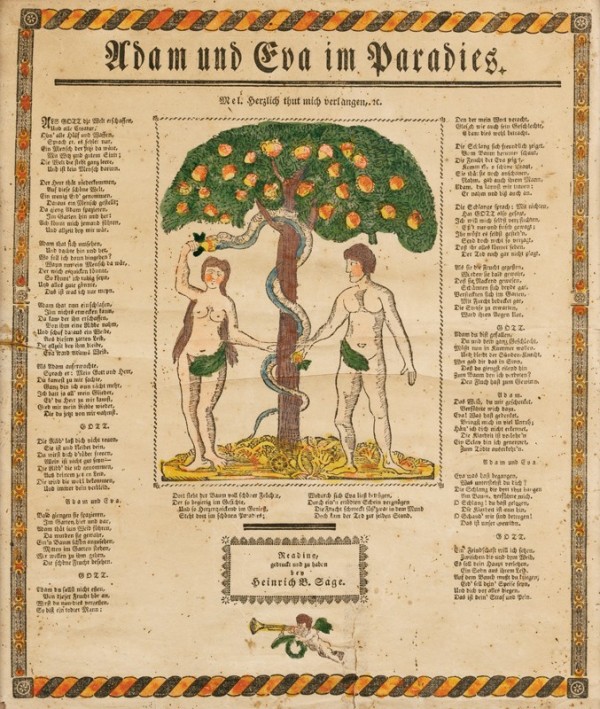
Broadside of Adam and Eve, printed by Heinrich B. Sage, Reading, Berks County, Pennsylvania, ca. 1820. Watercolor and ink on wove paper. 14 1/2" x 12 1/4". (Private collection; photo, Gavin Ashworth.)
In 1792 an extraordinary walnut chest with inlaid decoration was made for Maria Elisabeth Miller (fig. 1). Many unusual features distinguish this object, most notably the four external drawers within the main compartment and three lower drawers, two interior tills, and one till drawer (fig. 2). This extravagant construction would have added greatly to the overall cost of the chest, requiring additional labor to build the seven exterior drawers as well the cost of brass locks, escutcheons, and pulls for each. Walnut was also a more expensive choice than tulip poplar or pine, as were the ogee feet, which are more difficult to make than straight bracket or turned feet. Although the exact cost of the Miller chest is unknown, some idea can be derived from the account book of Bucks County joiner Abraham Overholt, who charged £1.10 in 1792 for a pine chest with three drawers, painted brown, and £3 in 1799 for a “walnut chest with three drawers, locks and hardware.” The Miller chest has inlaid floral motifs on a large horizontal panel that is attached to a mortise-and-tenoned frame, rather than the more typical single-board façade. Presumably the maker used that construction to accommodate the external drawers flanking the panel. A second panel containing the owner’s name, in elaborate German Fraktur lettering, is inset within the larger panel (fig. 3). Who was Maria Elisabeth Miller? Why was her chest built and inlaid in such a singular and costly manner, and who made it? Was the elaborate lettering of Maria Elisabeth’s name rendered by the maker of the chest or by a professional calligrapher such as a fraktur artist? Although not all of these questions can be definitively answered, the examination of the Miller chest and other related inlaid or painted objects sheds light on the remarkable furniture production of a distinctive cultural region and enables an exploration of the myriad connections between fraktur and furniture.[1]
The Miller Chest
The identification of Maria Elisabeth Miller is critical for understanding this chest within its original context and exploring its relation to other objects. Maria Elisabeth Miller (1775–1843) was the youngest child of Michael and Maria Elisabeth (Becker) Miller of Millbach, in Heidelberg Township, Lancaster County (now Millcreek Township, Lebanon County). Named after the Mill Creek or Mühlbach, the village was home to several families who attained significant wealth through farming and milling. Four miles to the southwest was Schaefferstown, the largest settlement in the area (see fig. 22). In 1746 Maria Elisabeth’s paternal grandfather, George Miller, provided an acre of land on which a German Reformed church and schoolhouse were built. Construction of the church began in 1751, and in 1770 Lutheran patriarch Henry Melchior Muhlenberg (1711–1787) described it as “built of massive stones and is furnished with a tower. . . . Lying between trees and open fields, it offers a pleasant prospect.”[2]
A German immigrant, George Miller (1706–1791) and his wife, Maria Catharina Stump (1711–1787), built a large stone house along the banks of the Mill Creek in 1752 (fig. 4). The house was soon expanded by their son Michael (1732–1815), who subsequently built a new gristmill that was attached to the main house and likely replaced an older mill in the same location (fig. 5). This house-mill combination is particularly associated with the Pennsylvania Germans and is a rare survival of a European house type. Notable is the house’s kicked gambrel roof, which provided a large attic well suited for the storage of grain. Two carved date stones (figs. 6, 7) were made for the buildings, one for the house with the inscription “JERG MULER / 17 MARIA CATR M 52” and the other for the mill, “1784 / GOTT ALEIN DE EHR (God alone the Honor) / MICHAEL MIELER / M ELISABET MILERN.” The interior of the house is equally impressive, with a Germanic floor plan consisting of a large kitchen, stove room, and bedchamber on the first floor. Other distinctive features include elaborately paneled doors and a massive staircase with square-sawn balusters in the German baroque manner (fig. 8).[3]
In 1753 George Miller transferred the house, mill, and 144 acres to his son Michael. According to the deed, George was then a resident of Rowan County, North Carolina. Records there appear to confirm the family tradition that George left his wife, Maria Catharina, behind in Pennsylvania and moved to North Carolina with a servant girl. In 1754 he applied for a license to keep a tavern on his plantation in Rowan County. Deed books show that George settled on Abbotts Creek, now part of Davidson County, and established a gristmill. In 1773 he transferred three enslaved servants “for natural love & affection to & for services of 20 yrs. to Glory Miller otherwise Glory Lettsler.” In his will of 1785, George refers to his wife, “Glory Litsler Miller,” as well as four sons, John, Jacob, David, and Frederick. He died in 1791. On the heels of this family scandal, Michael Miller acquired the Millbach property at only twenty-one years of age. He would become one of the wealthiest men in the community by the time of his death in 1815 and was consistently taxed at one of the highest rates of all residents in Heidelberg Township. In addition to expanding the house (probably to provide his mother with independent living quarters) and building a new gristmill, Michael made other improvements, including the construction of a sawmill by 1777. When the federal direct tax was taken in 1798, Heidelberg Township had a total of nine saw- or gristmills, two of which were owned by Michael Miller. His property comprised the large stone house; a two-storey stone gristmill of 50 by 20 feet, with two pairs of stones and described as “in good order, new”; a sawmill of 40 by 12 feet with double gears, “in very good order”; a large barn of 100 by 28 feet; and a log still house of 30 by 20 feet in “good order.” The house and mill were assessed at $1,000.00 each; by comparison, the average tradesman’s house in Schaefferstown was valued at $268 and the average farmhouse at $434.00.[4]
A partial inventory conducted after Michael Miller’s death in 1815 lists a table, stove and pipes; a bed and bedstead worth £3.15 and three more bedsteads; “1 Closset” (likely a schrank) worth £4.10; a “spinet” worth £11.5; “1 Conk shell”; a chest, cradle, dough trough, and meal chest; two kitchen dressers; four tables; a corner cupboard; and extensive pewter including a dozen plates, seventeen spoons, seven basins, and five other “large” forms. Also appraised were a still kettle valued at £16.17.6 and “63 vesels the half belonging to the Stillery” valued at £22.10.6. Known furnishings of the Miller house are as Germanic as the architecture. The stove room was heated by a large iron stove, fed through the back of the kitchen hearth, which was supported by an ornately carved stone (fig. 9) inscribed with the date “1757” and initials “MM / MLM” (for Michael Miller and Maria [E]lisabeth Miller), along with symbols of the miller’s trade—lower half of the main wooden gear from a gristmill, a square, and dividers. A tall-case clock (fig. 10) with eight-day movement by Jacob Graff (1729–1778) of Lebanon descended in the family until the early twentieth century and, according to tradition, stood in the kitchen. One of the earliest known Pennsylvania German tall-case clocks, it dates to about the time Michael Miller acquired the house. The case’s form and construction are overtly Germanic, with ample use of wooden pegs (rather than nails) and a trapezoidal pediment that appears on Continental furniture but is extremely rare in America. The clock’s eight-day movement features a moon phase dial, calendar wheel, and day-of-the-week disk (fig. 11). A walnut chest (fig. 12) with paneled lid in the Continental manner and a hanging corner cupboard with raised panel door (fig. 13) are also associated with the Miller house; details such as the notched corners of the raised panels on the chest and the shape of the raised panel of the cupboard door relate closely to the doors and shutters of the house.[5]
One of the most unusual objects associated with the house is an earthenware angel head (fig. 14) that was probably an architectural ornament. In 1765 Michael and Maria Elisabeth Miller were presented with a large New Year’s greeting (fig. 15), which is addressed to them as “my dear neighbors and friends.” The same artist also made a birth and baptismal certificate for the Millers’ son Johannes (John), born in 1766 (fig. 16). At the bottom of the New Year’s greeting are the initials “CF,” which stand for Caspar Feeman (Viehmann), who either made or commissioned this piece. Less than two miles from the Miller house stands the dwelling of Caspar’s brother, Valentine Viehmann (1719–1779) and his wife, Susanna, built in 1762 (fig. 17). The Viehmann and Miller houses share such details as massive carved summer beams and large attics. The Viehmanns’ attic also included a hoist system and large bin for storing grain. In 1778 Valentine and Susanna sold their property to their son Adam (1747–1815), who remained at that location until 1796.[6]
Michael Miller married Maria Elisabeth Becker (1736–1801) circa 1755. They had eight sons, four of whom predeceased them, and two daughters. Michael was an active member of the Millbach Reformed Church, serving intermittently as its treasurer, and his children were baptized and likely schooled there. Philip Erpf (1724–1803), a tavern keeper and prominent Schaefferstown resident, sponsored the baptisms of sons John Frederick and Philip; John Schaeffer (eldest son of Schaefferstown founder Alexander Schaeffer) and his wife, Barbara, sponsored son John (1766–1848); and Maria Catharina Miller (Michael’s mother) sponsored the youngest child, Maria Elisabeth (1775–1843). An elaborate certificate (fig. 18) made by fraktur artist Henrich Otto commemorated Maria Elisabeth’s baptism. Many of the motifs on this document relate to those inlaid on her chest, in particular the pomegranate with ruffled border. Little is known about Maria Elisabeth’s life between her baptism and the death of her father in 1815. She married Henry Schultze (born Henrich Christopher Emanuel Schultze; 1774–1824), probably before 1797, when the couple appear as baptismal sponsors for the daughter of Maria Elisabeth’s brother Frederick. Maria Elisabeth and Henry’s marriage was a union between two of the most preeminent Pennsylvania German families, the Millers being of significant wealth and the Schultzes of significant influence. Henry’s father, Emanuel Schultze (1740–1809), was the minister at Christ Lutheran Church near Stouchsburg, Berks County, from 1771 until his death in 1809, and his mother, Eve Elisabeth Muhlenberg (1748–1808), was the eldest daughter of Lutheran patriarch Henry Melchior Muhlenberg. Henry’s brother John Andrew Schultze (1775–1852) was a three-term member of the Pennsylvania House of Representatives; the first prothonotary, recorder of deeds, register of wills, and clerk of courts for Lebanon County, from 1813 to 1821; and a two-term governor of Pennsylvania from 1823 to 1829. Maria Elisabeth and Henry Schultze had no children, a fact that would play a role in her inheritance and, ultimately, the chest’s line of descent.[7]
Faced with a substantial estate and many heirs, Michael Miller prepared his last will and testament in 1809. In that document he mentioned 194 acres of land in Berks County given to his late son Benjamin; 94 acres in Tulpehocken Township, Berks County, given to his son Michael; 133 acres in Heidelberg Township given to his late son George; and 138 acres in Heidelberg Township given to his son Frederick (who would also predecease him). The elder Michael’s son Jonathan, a Philadelphia merchant, was to inherit £650, and his daughter Catherine, wife of Michael Gunckle, was to inherit £800. To his son John Miller, who had already received 300 acres of land along with the house and mill, Michael Sr. left a horse, two wagons, two plows, two harrows, “my Clock with the case,” a ten-plate stove and pipes, two still kettles of his choice and half of the distilling vessels, “and all my smith tools” but permitting “my son Fredk. and the heirs of my deceased son George to work with the said Tools in the smith shop.” To his youngest child, Maria Elisabeth, Michael bequeathed £150 outright (in addition to £300 that she had already received) and £600 to be put out at interest, for which she was to receive yearly dividends and payments of £150 at increments of eight, eleven, fourteen, and seventeen years after Michael’s death. If she was widowed, she was to receive the entire principal of £600 at once, but if her husband outlived her and they had no issue, the principal was to be divided among her siblings. Michael Miller appointed his son John as the sole executor.[8]
The careful wording of the bequest to Maria Elisabeth indicates that her father wanted to protect her inheritance from her husband. Although Henry Schultze came from a distinguished family, the archival record suggests that he was a bit of a ne’er-do-well. When Henry’s father, Emanuel Schultze, died in 1809, the inventory of the latter’s estate mentioned the sum from his “Family Book,” which listed what each of his children had received. Henry Schultze had been given £2,375.9.9—nearly triple the total of what his four siblings had together received. No record of Henry and Maria Elisabeth’s marriage has been found, which is surprising given the numerous ministers on his side of the family, nor have any deeds or estate papers for Henry Schultze come to light. Problems pertaining to inheritance began soon after Michael Miller’s will was recorded following his death in late 1815. In May 1817 Henry and Maria Elisabeth Schultze, along with her brother Jonathan Miller and his children Jonathan Miller Jr. and Catharine Miller, wife of Jacob Hiester, were named as defendants in a suit filed in the Lebanon County Court of Common Pleas “to try the validity of a Certain Instrument of Writing purported to be the last Will & Testament of Michael Miller.” The plaintiffs were John Miller; Catharine (Mayer/Meier) Miller, widow of George Miller (d. 1804); Catharine (Philippi) Miller, widow of Frederick Miller (d. 1811), and her daughter Catharine, wife of Daniel Strickler; and the heirs presumably of Benjamin Miller (d. 1814): Elisabeth Miller, wife of Andrew Kapp; and Catharine Miller, wife of Jonathan Mohr. Complicating matters further was the fact that John Andrew Schultze, Emanuel’s brother, not only was Lebanon County’s prothonotary and clerk of courts at the time but was also appointed by one of the defendants, Jonathan Miller, as his personal attorney in November 1816. A protracted legal battle ensued in which both sides hired attorneys and filed numerous appeals. Court documents include testimony that on September 28, 1816, all of the heirs discussed the validity of the will and that “John Miller had given the reasons why his brothers & sisters had got so small a portion.” The surviving witness to the will testified that he had met with Michael Miller on October 27, 1809, that following dinner Michael gave him instructions in German regarding his will, and that he then prepared Michael’s will in English and explained it to him in German. The court found in favor of the plaintiffs, but the defendants’ attorney filed a writ of error to move the case to the Supreme Court of Pennsylvania. On October 11, 1817, the Supreme Court upheld the Court of Common Pleas decision and ordered the defendants to pay the plaintiffs $300.00.[9]
The Schultzes responded by filing suit against John Miller, seeking “amicable action in debt.” The court referred the case to arbitration, and three men were appointed to meet at Jacob Stouch’s tavern in Lebanon to review the case on January 30, 1818. According to the testimony, John Miller and his attorney “appeared at first but shortly thereafter withdrew.” The Schultzes then presented their case, arguing that £150 (or $400.00) had been bequeathed to Maria Elisabeth by Michael Miller and was to be paid within two years of his death, that his executor John Miller had “neglected & refused” to do so, for which the Schultzes sought the £150 “with lawful interest.” In addition, the Schultzes claimed that Michael Miller was indebted to them “for the work and labor care and diligence of the said Maria . . . as nurse for the said Michael Miller in his lifetime and at his special instance and request in and about the nursing and taking care of him the said Michael Miller whilst he was sick & laboring under divers maladies and diseases.” Furthermore, “being so indebted he the said Michael Miller” had promised on September 1, 1815, to pay Maria Elisabeth the sum of $1,500.00 but died before doing so, and John Miller refused to honor the debt. The arbitrators decided in favor of the Schultzes and ordered John Miller to pay them $1,002.50 ($602.50 “for the attendance of Mrs. Shultze upon her father in his sickness” and $400.00 “as the Legacy in the Will what is Due”), plus court costs. On January 31, 1818, John Miller’s attorney filed an appeal and the case went before the Lebanon County Court of Common Pleas. No record of the court’s decision has been found, but the final administrative accounts of Michael Miller’s estate submitted by John Miller indicate that the Schultzes were paid $602.50.[10]
Henry Schultze died in 1824 and was buried at the Millbach Reformed Church. Soon after his death, Maria Elisabeth and her brother John Miller appear to have resolved their differences. Widowed and childless at the age of forty-nine, Maria Elisabeth moved back to Millbach by 1830 to live with John, who since 1808 had been a widower. She is listed in both the 1830 and 1840 censuses directly before his name. In 1827 and again in 1834, she stood as a baptismal sponsor at the Millbach Reformed Church for two of her great-nieces. Maria Elisabeth died in 1843 and was buried at Millbach beside her husband. Her tombstone identifies her as both the wife of Henry Schultze and the daughter of Michael Miller—nearly thirty years after her father’s death. The inventory of her estate totaled more than $1,400.00 and indicates a well-appointed household, including carpet and window curtains; three looking glasses; a stove and pipe; numerous books and two pairs of spectacles; twelve silver teaspoons (six of them German) and “Flowered Glass”; five “Profiles”; an orange tree, flowerpots, garden seed, and eleven chickens. Her furniture consisted of two bureaus and a small case of drawers; two dining tables, twelve chairs, and an armchair; three bedsteads; a thirty-hour clock, corner cupboard, and queensware; two dough troughs and a kitchen cupboard; quilting frames, two spinning wheels, and a wool wheel; “1 Trunk” valued at $1.00, and “2 Chests & 1 Box &c &c” valued at $2.00. On February 27, 1843, Maria Elisabeth prepared her will, beginning it with the date and the word “Mülbach.” This brief document, written by her own hand in German script, noted, “the household goods my brother Johannes shall keep what he can use,” and the leftover items were to be divided into four portions among his three daughters (Catharine, 1792–1869, m. Jacob Weigley; Sara, 1797–1870, m. William Forry; and Martha, 1802–1885, m. George Zeller) and the children of his deceased daughter Maria Magdalena (1789–1841, m. George Becker). The will also bequeathed a $1,200.00 bond to be divided between her brothers John and Jonathan Miller. Most significantly, the administrator’s account included a credit of $198.54 “for the Articles bequeathed to the daughters of John Miller & included in the Inventory.” One of these items was almost certainly the inlaid chest (fig. 1).[11]
Five years after Maria Elisabeth died in 1843, John Miller passed away and his executors sold the Millbach property to the Illig family. The inventory of John Miller’s belongings lists a silver watch and three items that likely represent the same objects in his father Michael’s estate: “1 clock & case” (probably the one made by Jacob Graff), a “Pianno Forte” (probably the “spinet”), and “old Blacksmith tools.” John Miller’s wife, Anna Catharina, had died in 1808, leaving him to finish raising their four daughters. Sara, born in 1797, was the recipient of a birth and baptismal certificate (fig. 19) that shows the family’s continued adherence to Germanic cultural traditions. In addition to the certificate made for John Miller (fig. 16), a colorful certificate with trumpeting angels was made for John Miller’s wife, Anna Catharina Lescher, by schoolmaster Johann Conrad Gilbert. Although this certificate documents her birth in 1768 (fig. 20), it was probably not made before the early 1780s, when Gilbert moved to Tulpehocken Township, Berks County. For some time before his death, John Miller shared the house with his daughter Catharine and her husband, Jacob Weigley (1789–1880). The Weigleys had ten children. One of their sons, William M. Weigley (1818–1887), married Anna Rex (1808–1900), great-granddaughter of Schaefferstown founder Alexander Schaeffer. William M. Weigley made a fortune in the mercantile business and in 1883 erected a brownstone mansion in Schaefferstown so grandiose that it was published in Godey’s Lady Book. Following Maria Elisabeth’s death, the chest likely went to her niece Catharine (Miller) Weigley, although no documentation exists to confirm this. However, the serendipitous discovery of a notation made by a later descendant reveals the subsequent line of descent. The next documented owner was Catharine Miller Weigley’s eldest daughter, Mary (1811–1898), who never married. Four years before her death, Mary gave the chest to her niece Emma (b. 1865), daughter of her youngest brother John (b. 1832). This is documented by a note in a ledger kept by Emma’s brother Walrow, who, on March 15, 1894, wrote, “Emma got great-grandfather Miller’s sister’s chest from Aunt Mary.” This notation provides conclusive evidence of this line of descent and indicates that the chest was regarded as a family heirloom. Emma Weigley most likely left the chest to her sister Westa (1859–1934), who lived near Millbach in Richland Borough, Lebanon County. The inventory taken of Westa Weigley’s belongings in 1935 includes what appears to be a short list of family heirlooms: a “Grandfathers clock” valued at $100.00; sideboard, $7.50; sofa, $3.00; marble-top table, $1.00; teapot and two pitchers, $1.00; and “Trunk” valued at 25 cents.[12]
What happened to the chest after Westa’s death in 1934 is unknown, but its history had been forgotten by 1969, when it was offered in the sale of Pennsylvania collector Perry Martin. The auction catalogue described it as an “Extremely rare Chester County Dower Chest with raised panel, inlaid with closed tulips, hearts, daisy, tulip trees, and vines and berries . . . the only known chest of this kind.” No doubt the Chester County attribution was based on the style of the inlaid decoration, which bears a resemblance to the line-and-berry inlay used on furniture owned primarily by Chester County Quaker families (fig. 21). The appearance of similar inlay on the Miller chest raises questions about potential cross-cultural influences, possibly introduced by Quakers who began moving into German-speaking areas of Berks County as early as the 1730s, when the Exeter Friends Meeting was founded by Welsh Quakers from the Gwynedd Monthly Meeting. Whatever the inspiration for the inlay, the revelation of Maria Elisabeth Miller’s identity enables the chest to be more fully understood as a product of the Tulpehocken Valley—a region long noted for its extraordinary Germanic architecture but heretofore with little known about its furniture.[13]
The Tulpehocken Valley
Derived from an Indian word meaning “land of turtles,” the Tulpehocken Valley is a fertile region that extends across what is now western Berks and eastern Lebanon Counties, bounded by the Blue Ridge and South Mountains and containing approximately 322 square miles or 206,000 acres (fig. 22). Much of the valley was originally part of Heidelberg Township, Lancaster County. The Tulpehocken Creek, of which Mill Creek is a major tributary, is the largest stream in western Berks County, rising just west of Myerstown and flowing east approximately twenty-six miles to join the Schuylkill River at Reading. Approximately 95 percent of the original Tulpehocken settlers were of German heritage, a fact that was reflected in the region’s early architecture, such as the house built in 1745 for Heinrich Zeller (figs. 23, 24). Many had settled initially in the Schoharie Valley of New York but relocated to the Tulpehocken region in response to an invitation in 1722 by Governor William Keith of Pennsylvania. In 1723 some fifteen to eighteen families from Schoharie traveled southward along the Susquehanna River, then east along the Swatara Creek to its juncture with the headwaters of the Tulpehocken. The early Tulpehocken inhabitants were of diverse religious backgrounds. From 1729 to 1743 Lutheran, Reformed, and Moravian factions competed for influence in a period known as the “Tulpehocken Confusion.” The arrival of Lutheran minister Henry Melchior Muhlenberg in 1742, followed by Reformed minister Michael Schlatter in 1746, and their efforts to organize churches and provide ordained ministers helped settle this matter.[14]
Many contemporary observers remarked on the agricultural prosperity and Germanic character of the region. In 1783 German physician Johann David Schoepf wrote, “We crossed Tulpehacken Creek, and passed through a part of the Tulpehacken valley, an especially fine and fertile landscape . . . the inhabitants are well-to-do and almost all of them Germans.” The 1790 census reveals that Schoepf was quite accurate in his observation: Berks County was 85 percent German, while Lancaster County was 72 percent and Dauphin County 52 percent. When Theophile Cazenove traveled in 1794 from Womelsdorf to Myerstown, he was astounded by the clothing worn by the local inhabitants, writing, “It seemed to me I saw people coming out of church in Westphalia, so much have all these farmers kept their ancestors’ costume.” In 1829 Philadelphia antiquarian John Fanning Watson traveled through the “Tulpehocken Country,” which he described as “a rich valley country—with high mountains in the distant views. The Cultivation & Scenery always fine. . . . The whole face of the Country looks German—All speak that language, & but very few can speak English. Almost all their houses are of squared logs neatly framed—of two stories high. The barns are large & well-fitted,—generally constructed of squared Logs or stone, but all the roofs were of thatched straw.” The region’s fertile and well drained limestone soil was responsible for the agricultural prosperity, and Tulpehocken Creek supported the development of numerous milling operations as well as an iron furnace. Founded in 1749 as the Tulpehocken Eisenhammer and later renamed Charming Forge, the site remained in operation until 1895. George Ege acquired the furnace in 1783 and erected a stately mansion with interior woodwork rivaling that of elite Philadelphia town houses (fig. 25). His son Michael Ege married Margaretha Schultze, a sister-in-law of Maria Elisabeth Miller. In the 1820s Tulpehocken Creek became part of the Union Canal system, built to connect the Schuylkill Canal at Reading to the Susquehanna River at Middletown. One of the first canals in the United States, the Union Canal brought great prosperity to Lebanon County before the advent of the railroad.[15]
Millbach, settled in the 1720s, was one of the earliest communities in the Tulpehocken Valley. About four miles to the northwest was Myerstown, founded in 1768. Four miles to the northeast was Womelsdorf (est. 1762), the home of Conrad Weiser (1696–1760), a renowned Indian interpreter and treaty negotiator, justice of the peace, and father-in-law of Henry Melchior Muhlenberg. Just west of Womelsdorf were the town of Stouchsburg and Christ Lutheran Church—one of the most affluent congregations in Pennsylvania in the 1700s and the center of a large parish that was made up of from five to nine congregations in Berks, Lebanon, and Lancaster Counties (fig. 26). Founded in 1743, Christ Lutheran was one of the first churches in Pennsylvania to have an organ, commissioned in 1752 from Moravian Johann Gottlob Clemm of Philadelphia for the staggering amount of £127.3.4 (to which Valentine Viehmann contributed). One of the largest settlements in the area was Schaefferstown, laid out in 1758 by Alexander Schaeffer (1712–1786) and initially known as Heidelberg. The illiterate son of a poor German peasant family, Alexander Schaeffer immigrated in 1738 and became a highly successful entrepreneur and landowner by the time of his death. He lived on a farm adjacent to the town, where he built and operated a tavern known as the King George. Schaefferstown grew rapidly after its founding. In 1759 the inhabitants began one of the first public water works in the country, using underground wooden pipes to carry water to two fountains on Market Street. A market house was erected near the center of town, used primarily during the annual cherry fair, which remains in operation to this day. In 1783 the Schaefferstown tax list included a locksmith, blacksmith, nailsmith, mason, miller, tanner, saddler, baker, three carpenters, three tailors, three shoemakers, and six weavers. By 1798 the town’s population approached five hundred people.[16]
Soon after Schaefferstown was laid out, the Lutheran and Reformed inhabitants built a log structure to serve as a shared or “union” church and schoolhouse. The arrangement did not last long. In 1765 the Lutheran congregation sold its interest in the log church to the Reformed congregation, which used it until 1795, when it was replaced by a stone church. Between 1765 and 1767 a new Lutheran church was built, later known as St. Luke, using gray limestone with contrasting red sandstone quoins and architraves (fig. 27). This style of stone construction was repeated throughout the Tulpehocken region on other churches as well as prominent houses such as that of the Millers, providing a visual cohesiveness to the region’s elite architecture. A unique feature of the new church was the three carved winged angel heads (fig. 28) attached to the cornice, which were likely removed when the building was remodeled in 1884. Dragon heads were also reputed to have been part of the building’s woodwork. A committee that included local innkeeper Philip Erpf oversaw the construction, led by master builders Henry and Philip Pfeffer, who inscribed the sounding board above the wineglass pulpit: “Heinrich Pfeffer, Philip Pfeffer, Schreiner, haben diese Kirche Arbeit gemacht in Juny Monat 1767” (Henry Pfeffer, Philip Pfeffer, Carpenters, have built this church. Made in month of June 1767). Henry Melchior Muhlenberg preached to a large crowd gathered for the dedication of the church in 1769 and described the building as “one of the best in this land, built of massive stones, large, well laid out, and adorned with a tower.” In 1770 his son Frederick Muhlenberg (1750–1801) became minister of St. Luke. Arriving in the Tulpehocken region after spending seven years in Germany, Frederick wrote that “the Tulpehocken people may be regarded as quite genteel.” In 1771 he married Catharine Schaeffer, daughter of a wealthy Philadelphia sugar refiner. Frederick served as pastor of St. Luke until 1773, when he accepted a call to New York City. He later left the ministry for politics and in 1789 became the first Speaker of the U.S. House. His sister, Eve Elisabeth Muhlenberg, married Lutheran minister Emanuel Schultze, the father-in-law of Maria Elisabeth Miller.
Another renowned Schaefferstown-area inhabitant was ironmaster and glassmaker “Baron” Henry William Stiegel, who emigrated from Germany in 1750 along with his mother and brother Anthony. Stiegel married the daughter of Jacob Huber, owner of the Elizabeth Furnace located some five miles south of Schaefferstown near Brickerville, and engaged in iron manufacture. In 1762 he founded the town of Manheim, Lancaster County, where he established a short-lived glassworks and built a large brick house that is reputed to have had imported Dutch tiles, tapestries and scenic painted landscapes on the walls, and a chapel. In 1769 Stiegel built a seventy-five-foot-tall wooden tower on a hilltop outside Schaefferstown to use for entertaining. Local legend maintains that his visits were heralded by trumpet players and his departures by cannon so the next destination was forewarned to prepare.[17]
The discovery of the Maria Elisabeth Miller chest and its history of ownership provides a starting point from which to explore the furniture of the Tulpehocken Valley. Several other examples of inlaid furniture have been found that relate to the Miller chest, as well as a large group of chests with painted decoration, long associated with the so-called Embroidery Artist. Genealogical research has identified many of the chests’ owners and linked them to the Tulpehocken region. Most of the families had ties to the Millbach Reformed Church, St. Luke Lutheran Church, or Christ Lutheran Church. Through an in-depth analysis of this group of furniture, distinctly local patterns of decoration and construction emerge that shed light on the furniture-making traditions of the Tulpehocken Valley.
Related Inlay
Closely related to the Miller chest is another inlaid walnut example made for Magdalena Krall (fig. 29). As on the Miller chest, a separate lightwood plaque that contains the owner’s name is set into the façade (fig. 30). Magdalena Krall was the daughter of Christian and Catharine Krall of Elizabeth Township, Lancaster County. Her paternal grandfather, Ulrich Krall, emigrated from Germany in 1729. Tax and probate records reveal that the Kralls were of moderate wealth in comparison with the Miller family. In 1798 Christian Krall’s dwelling was assessed as a one-storey log house of 30 by 24 feet, described as “old but in good repair.” The inventory taken at the time of his death in 1802 lists a case of drawers valued at £1.2, a clothespress at £5, a house clock at £8, a corner cupboard at £7.10, as well as queensware, pewter, grain, and livestock. The total value of his inventory was £1,283.17.10. The Kralls were likely Mennonite, as their name is absent from local church records, and about four miles west of Schaefferstown was the Krall’s Mennonite Meetinghouse, founded in 1811. Inlay related to that on the Krall chest appears on another walnut chest with two drawers— inlaid on the façade “1794 / M B” within a rectangular surround from which a pair of undulating vines with leaves and tulips emanates—and several tall-case clocks, including one dated 1789 and another with a history of ownership in the Taylor family of Womelsdorf, Berks County (fig. 31). Inlaid motifs on the pendulum door echo those on the Krall chest, such as heart-shaped leaf and single-berry terminals and flowers consisting of a ring of dots surrounding a single dot (fig. 32). A third clock, with a history of ownership in the Illig family of Millbach, has the initials “PI” (or “PL”), inlaid above the pendulum door and is embellished with line-and-berry motifs, tulips, and stars (figs. 33, 34).[18]
The Embroidery Artist Chests
The Miller and Krall chests have several distinctive features of ornament, construction, and hardware that also characterize a group of paint-decorated chests associated with the so-called Embroidery Artist, of which more than twenty examples are known, ranging in date from 1788 to 1805 (fig. 35). Two basic models of painted decoration are found, the first having a large, horizontal panel across the façade, similar to the inlaid walnut chests, in which the owner’s name and the date are typically inscribed. The alternative design features a central heart flanked by two arched-head panels. The painted chests are made of tulip poplar or pine and have typical Germanic construction details including the use of wooden pegs to attach the moldings and wedges driven into the end grain of the pins to secure the dovetails. Several more notable construction features are found on the Embroidery Artist chests that help provide a set of defining characteristics. Thirteen of the chests (in addition to the Miller example) have till lids with a stepped molding running down the center, rather than the typical flat board with molded edge (fig. 36). This detail, which has not been observed on any other group of chests, required the craftsman to remove nearly half the thickness from one side of the board and use a molding plane to finish the resulting lip. Another feature that often appears on the underside of the lid and interior of the chest is a tapering spiral motif, made by the craftsman in a red crayon to mark the inside of each board (fig. 37). The maker also typically marked the inside of the front and back boards in red to indicate the placement of the bottom edge of the till lid, as a guide for the two mortises he had to chisel out to hold the front board of the till compartment. Most of the chests have straight bracket feet, which extend from the base molding, and were built without glue blocks. Many of these unsupported feet broke over time and were replaced, sometimes with ball feet. The only known exception to this construction is the Miller chest, which has short ogee bracket feet that are supported by an oak batten that runs front to back at either side.[19]
The hardware of the chests is also unusual and related. Ten chests, including the walnut one made for Magdalena Krall, have identical wrought-iron carrying handles consisting of two quatrefoil backplates and a bale with a pair of incised lines at the center (fig. 38). Another common feature is the locks, eight of which have decorative wrigglework engraving—some with dates and/or initials. Although chest locks are commonly found with decorative filework, locks with wrigglework engraving are highly unusual; thus, the presence of this feature on so many chests in this group is extraordinary. The three locks that are dated correspond closely to the date on the chest. The lock on the Catharina Lebenstein chest, dated 1789, is inscribed “HS 1788” (fig. 39). The Henrich Schorck chest, dated 1793, has a lock inscribed with the same date, as does the Susanna Zwally chest with a lock inscribed “17 IS 94.” The undated locks range from the lock on the Miller chest, which has a small wrigglework flower between the initials “HS,” to that on the Peter Rammler chest, which is embellished with profuse wrigglework on both the top and side and inscribed with the initials “IS” (fig. 40).[20]
The painted ornament on the chests is quite similar. A pomegranate appears inlaid on the Miller chest and on many of the painted examples (fig. 41). Another typical design is a simple flower formed by multiple light-colored dots, surrounding a darker central dot (fig. 42). Because of the elaborate nature of the painted decoration, the overall pattern was laid out first with a compass and straightedge. Many of the designs were then drawn on with a fine brush or pen. Scribe lines were also used to help align the lettering of the names, which were typically rendered in elaborate fashion with many calligraphic flourishes (fig. 43). Fine lines were used to embellish the decoration and inscriptions on many of the chests, such as cross-hatching within the pomegranates and between the two vertical strokes of the “1” in the dates.
Variations in the painted decoration and lettering on the chests indicate that three or more decorators may have been involved in their production. Construction differences also help to subdivide the chests further. The largest group (A) is characterized by the use of till lids with a stepped molding, straight bracket feet without glue blocks, and red spiral motifs drawn on the inside of the boards. This group has painted decoration in two different formats, one having a long, horizontal panel with ovolo ends, the other a central heart flanked by arched-head panels. Six of the chests in this group have identical carrying handles, and five retain their original locks with wrigglework ornament. The second group (B) is made up of five chests, each of which has the same type of till lid as group A, along with the additional feature of two small drawers under the till (fig. 44). Only one of the five chests in group B has the iron carrying handles, and none has ornamented locks (although one lock is missing). Group B chests have straight bracket feet, with further embellishment on two examples that have cusps and two with a dentilled base molding. The painted decoration on all five group B chests consists of arched-head panels flanking a central heart but differs from the group A chests in the use of urns within the arched-head panels and the placement of the date flanking the central heart rather than within it. The smallest group (C) includes three chests, which have the same carrying handles as many of the group A chests but differ in that they have flat rather than molded till lids. On the whole, these three groups of chests share a distinctive set of construction details, hardware, and painted decoration—suggesting that they were made in a limited geographic area, if not a single shop, and providing a strong rationale for considering them as one body of evidence. New research on the owners of the chests, none of which has survived with a solid family history, reveals their common origin in the Tulpehocken region and provides a starting point from which to explore the potential makers and decorators of the chests.[21]
GROUP A
The earliest known chest is dated 1788 and bears the name “Maria Stohlern” within the central heart (fig. 45). This chest was recorded by the Index of American Design in 1938 and is one of the most widely published Pennsylvania German examples. Maria Stohler was born in 1761 and grew up on a farm about two miles north of Schaefferstown, near Reistville. Her father, Johannes Stohler (1714–1785), immigrated in 1749 and married Anna Maria Glassbrenner in 1759. Stohler was a wealthy man at the time of his death; his inventory lists eighteen pewter plates and dishes; nearly four dozen pewter spoons, half of them new; and extensive linens, including nineteen tablecloths. His daughters Maria and Magdalena were each bequeathed £106—the same as their sisters Ann and Elisabeth had already received, likely when they married. Maria was given an additional £5 and a new side saddle. Three years after her father’s death, she received the chest. Circa 1790 Maria married John Shenk (1740–1814), a wealthy Mennonite widower who was twenty-one years her elder. Shenk owned a substantial stone house and several hundred acres in an area of Heidelberg Township known as Buffalo Springs. His estate inventory totaled £3,153, of which £1,678.8 was “Cash in the House.” To Maria he bequeathed £1,000 along with the right to use the house, new kitchen and cellar, “Two good Beds and Bedsteads, all my Linen Cloath my two Copper Kettles all my Pewter Ware and Kitchen Furniture, as also all my China Glass Delph and Silver ware in my Corner Cupboard together with the said Cupboard . . . one Cloaths Press . . . House Clock and Case and Ten Plated Stove” and her choice of kitchen furniture. In addition, Maria was to receive an allowance of £36 annually for “cloathing and boarding” his son Christian. John instructed his sons John and Joseph to keep the house in good repair and provide their stepmother with food and firewood and appointed as sole executor “my trusty Friend Samuel Rex,” storekeeper in Schaefferstown. Maria outlived her husband by twenty-one years and died in 1835. Her niece Sarah Stohler (1809–1880) was the owner of a small dome-top box with related painted decoration and inscribed with her name and the date, 1828, on the top in elaborate lettering (fig. 46). A closely related flat-top box inscribed for Johanna Kunger and dated 1827 has geometric designs identical to those on the drawers and façade of the Maria Stohler chest (fig. 47).[22]
The next chest in the group is dated 1789 and was made for Catharina Lebenstein (1774–1828) (fig. 48). This object retains its original hinges with tulip-shape terminals (fig. 49), carrying handles (fig. 38), and wrigglework-decorated lock bearing the initials and date “HS 1788” (fig. 39). Catharina was born on January 12, 1774, to David Lebenstein Jr. (1736–1789) and Elisabeth Hock, who married in 1762. According to family tradition, her father was born aboard the ship Princess Augusta en route from Europe. Immigration records list a David Löebenstein, aged forty, among the ship’s passengers, along with such Schaefferstown-area settlers as Gottfried Lautermilch, Bastian Stoler, Durst Thoma; Sebastian, Jean, and Diederich Gackelie; and Hans Zwally. Two David Lebensteins appear in the 1759 tax list for Heidelberg Township, the younger listed as a freeman (single man over age twenty-one). The Lebensteins settled in Millbach, on land next to Michael Miller and the Viehmanns, where they joined a small group of German Baptists or Dunkards (so called for their practice of full-immersion baptism) who in the 1720s established a settlement in Millbach. David Lebenstein Sr. died sometime before 1771, when only David Jr. appears in the tax list. David Jr. died in 1789, having prepared copies of his will in both English and German in which he described himself as “being very Sick and weak in Body.” His inventory included farm equipment and livestock; a loom, forty yards of linen and tow; a house clock valued at £6.10; and pewter plates, dishes, and a basin worth £2. To each of his three daughters he bequeathed a £120 share in his estate. Catharina Lebenstein married John Royer (1765–1839) of Heidelberg Township, with whom she had seven children. In the 1798 direct tax list, her mother, “Widow Lebenstein,” appears as a member of John Royer’s household. The tax list also indicates that John Royer was a prosperous farmer and owned nearly two hundred acres of “good limestone land” with a “new and well finished” stone house of 40 by 31 feet along with two smaller hewn-log houses; a small log stable; and a large stone-and-log barn. Catharina died in 1828 and John in 1839; they are buried at the Millbach Brethren Meetinghouse along with her parents. The inventory of John’s estate included a weaving loom, anvil and smith tools, farm equipment, and one “Chist”—possibly the one made for Catharina.[23]
A chest bearing the name “Catrina Bicern” was made in 1790 (fig. 50). Although her exact identity remains uncertain, her surname was likely Becker, a prominent local family who intermarried with both the Miller and the Lebenstein families. It is possible that Catharina Bicer/Becker was related to Maria Elisabeth Miller, whose mother was Maria Elisabeth Becker (1736–1801). The composition of the painted designs on the Bicer/Becker chest is similar to those on the Stohler and Lebenstein examples. Another chest, which bears the name “Henrich Schorck” and the date 1793 (fig. 51), is the earliest dated example with a long horizontal panel on the façade rather than two arched-head panels flanking a heart. This chest was made for Johann Philip Heinrich Schorck (1772–1842?), son of John George and Salome (Brinsch) Schorck, who were married in 1771 at St. Luke Lutheran Church. Pastor Frederick Muhlenberg baptized Heinrich Schorck there the following year. In the tax list of 1783, George Schorck is identified as a resident of Schaefferstown and a shoemaker. The Schorcks had six other children baptized at St. Luke between 1774 and 1788; thereafter they appear in the records of Christ Lutheran Church near Stouchsburg, Berks County, where Henry was confirmed in 1788 and three of his siblings were baptized in 1796.[24]
An undated chest made for Peter Rammler (1770–1850) has a large horizontal panel like the Schorck chest on both the façade and the lid (figs. 52, 53). Although the panel on the façade has a floral border, the one on the lid, which survives in remarkably good condition, has a zigzag or sawtooth border that may have been inspired by similar panels on stove plates (fig. 54). Peter Rammler was born in 1770 to John and Anna Barbara (Ley) Rammler. John Rammler was born in 1726, shortly after his parents emigrated from Germany. Pastor Emanuel Schultze at Christ Lutheran Church confirmed Peter in 1784. Ten years later he married Eva Uhrig in that church, where four of their children were baptized. The Rammlers moved to East Hanover Township, Dauphin County, where Peter died in 1850 and was buried at Shell’s Church, as was Eva, who died in 1869. Peter Rammler’s mother grew up just west of Myerstown on a property known as Tulpehocken Manor, which was later acquired by her brother Michael Ley. Michael was one of the few residents in Heidelberg Township with assets comparable in value to those of Michael Miller, and in 1769 Ley and his wife, Eva Magdalena, erected an impressive stone house that rivaled the mass and grandeur of the earlier Miller and Viehmann houses. Built by master joiner Christoph Uhler of Lebanon, the Ley house had a carved pediment above the front door and a pair of date stones on the façade that recall those used on the Miller house and other prominent local buildings. The interior furnishings included a built-in corner cupboard and massive walnut schrank with sulfur-inlaid decoration. The Leys and Rammlers were consistent supporters of Christ Lutheran Church. In 1772 they were among the highest contributors for the construction of a new parsonage, to which Jacob Rammler and Michael Ley each paid £6 and John Rammler £5. When John Rammler died in 1788, letters of administration were granted to his widow and brother-in-law Michael Ley. The inventory of John Rammler’s belongings listed a Bible and eleven other books; “Ward-Rob” and clock; pewter plates, dishes, and spoons; “tea Dishes”; and farm equipment and livestock.[25]
Closely related to the decoration on the Rammler chest is that on one made in 1795 for Catharina Maurer (fig. 55), which also has a similar horizontal panel on the façade and lid, surrounded by floral decoration applied over the blue ground. Catharina Maurer (b. ca. 1775) was likely the daughter of John Philip Maurer Jr. (1746–1786) of Hanover Township, Dauphin County, as she is named in his will and was born circa 1775. Her paternal grandfather, Philip Maurer Sr. (b. 1706), immigrated in 1738 on the Charming Nancy and is listed in the Heidelberg Township tax list of 1759. The Maurer and Rammler families were closely intertwined through marriage and were frequent baptismal sponsors of each other’s children. Philip Maurer Jr. was a first cousin of Peter Rammler; his father, Philip Sr., married Peter’s aunt, Anna Catharina Rammler, in 1740.[26]
Horizontal panels like those on the Schorck, Rammler, and Maurer chests can be found on three more chests, two of which have nearly identical decoration, with a single large pomegranate in the center. The only significant difference between the two is that one is dated 1796 (fig. 56) but never had a name, while the other is undated but bears a name, Margaretha Stehlts (fig. 57). Both chests also share an unusual construction feature—the bottom board of the till has a beveled edge, which required the cabinetmaker to chisel out an angled mortise (fig. 58). The unique end panels on the Stehlts chest have S-scrolled floral motifs (fig. 59) similar to those inlaid on the Krall chest and related clock (fig. 32). The third chest was made for Christina Ache (fig. 60), daughter of Henry Ache (1718–1786) and Maria Catharina Filbert/Philbert (1739–1817). Henry Ache (Achey, Aughe) was of French Huguenot ancestry and had a farm outside Schaefferstown. Little is known of Christina, who was born in 1765. She is likely the same Christina Ache of Heidelberg Township who married Henrich Schmidt in 1792 at the Schwartzwald Reformed Church in Exeter Township, Berks County. The chest appears to have descended in the family of her brother Henry Ache Jr. (1761–1807), who married Maria Elisabeth Spengler (1767–1827). Remnants of a birth and baptismal certificate pasted to the underside of the chest’s lid name Elisabeth Spengler as the mother of the child for whom the certificate was made. German émigré and schoolmaster Johann Henrich Goettel prepared an elaborate birth and baptismal certificate for Maria Catharina Ache (b. 1786), daughter of Henry Ache Jr. (fig. 61). Brother Thomas Ache (d. 1826) married Christina Stiegel, niece of Henry William Stiegel, and lived in Schaefferstown. Another Ache sibling, Sophia (b. 1773), was the owner of an undated chest (fig. 62).[27]
Another sibling, Samuel Ache (1764–1832), owned a zither (figs. 63, 64) with painted floral decoration and a lengthy inscription that includes his name, the date February 27, 1788, and location of Heidelberg Township, Dauphin County. Also known as a Zitter, Scheitholz, or dulcimer, the zither was a popular musical instrument among the Pennsylvania Germans, used primarily for secular folk music. Samuel Ache married Elisabeth Albrecht (Albright) circa 1792 and lived about two miles north of Schaefferstown in an area formerly known as Achey’s Corner (now Reistville). He was a prominent member of the Reformed Church in Schaefferstown and was elected one of the first county commissioners when Lebanon County was established in 1813. Although Samuel Ache’s name on the zither has traditionally been interpreted as that of an owner rather than maker, newly discovered evidence reveals that he made musical instruments and quite possibly furniture as well. His 1833 estate inventory lists two “Carpenter Benches and a lot of old tools,” three hundred feet of cherry boards, three grindstones, “1 lott piano paterns,” pieces of ivory and ebony wood, “1 ball silver wire and lot piano wire,” gold leaf, twelve augers, one crosscut saw, seven hand saws, a lot of chisels and a lot of planes, files, squares, compasses, cramp screws, a vice, and “2 Sets wooden Alphibets.” Samuel also owned a “Forte Piano and a House Organ” appraised at $26.00, the highest value of any of his household furnishings. By comparison, the five beds and bedsteads together with forty-five pounds of heckled flax came to $24.50. Based on this inventory, it appears that Samuel was making both keyboard and string instruments, and thus it is reasonable to conclude that the zither inscribed with his name is an example of his work. Although abraded from years of use, the decoration, calligraphic embellishments, and inscription on the zither relate to those on contemporaneous painted chests. In addition to making a zither for his own use, Samuel Ache may have made a musical instrument for his brother Henry, who had a “Guitar” listed in his estate inventory of 1808. Woodworking and artistic talents may have run in their family. According to family tradition, Samuel’s son Jacob taught nephew Peter Ache the carpentry trade. Schoolmaster Hermannus Ache (ca. 1724–1815), who lived in Montgomery County and made several fraktur, may also have been a relative. Filbert Achey (1812–1832), a nephew of Samuel Ache, also made and signed several fraktur drawings (fig. 65).[28]
If Samuel Ache made the zither, it is possible that he built and decorated some of the Embroidery Artist chests, including the ones owned by his sisters Christina and Sophia. Born in 1764, Samuel was in his mid-twenties by 1788, when the earliest chest (fig. 35) was made, and was old enough to have acquired the basic skills needed for making such a form. He clearly had woodworking abilities, as evidenced by the two carpenter benches and extensive tools in his probate inventory. A painted schrank (fig. 66) with horizontal tulips similar to those on the zither (fig. 67) relates closely to the preceding chests and may also represent Ache’s work. In addition to his ties to owners of the painted chests and his woodworking skills, Samuel Ache also has an intriguing connection to a piece of line-and-berry inlaid furniture through his brother Jacob (1765–1819), who married Lydia Jefferis (1768–1850) of Chester County in 1788. Her mother, Hannah (Darlington) Jefferis (1729–1795), is believed to have been the owner of a small chest-over-drawers inlaid with the initials HD, date 1747, and line-and-berry ornament (fig. 68). It is possible that the decoration on this chest or another similarly decorated object inspired the line-and-berry inlay found on the Miller and Krall chests (figs. 1, 29). Another potential link between Ache and the production of inlaid hardwood furniture can be found in the inventory of Maria Elisabeth Miller’s father, Michael, who owned a “spinet” when he died in 1815. Valued at £11.5, the spinet was worth more than his bed and bedstead, stove and pipes, and “Closset” (likely a schrank) combined. Michael Miller appears to have acquired his furnishings locally, based on the surviving objects, and very few people in the area were capable of making musical instruments. Thus Samuel Ache, who lived nearby, is a strong candidate to have made the spinet and possibly the chest for Maria Elisabeth Miller as well. Because Michael Miller owned one of the only sawmills in the area, it is likely that the two men also interacted in that regard. It was not unusual for musical instrument makers also to work as joiners or cabinetmakers. David Tannenberg, the renowned Moravian organ builder, worked as a joiner in Bethlehem before making organs. Conrad Doll (1772–1819) of Lancaster was identified in tax records and deeds as a “spinet and organ maker” as well as a “joiner and cabinetmaker.” When organ builder Johannes Scheible of New Holland, Earl Township, Lancaster County, died in 1793, the inventory of his estate included an unfinished forte piano and unfinished house organ as well as patterns for clock cases, a painted chest, one chest “not painted without hindges,” and “1 unfinished Wallnut Chest.” Scheible also had walnut, cherry, and poplar boards; a workbench and lathe; seven new spinning wheels, spinning wheel parts, and bedsteads; tea-table tops and feet; carpenter’s tools and unspecified carpentry books; saws, files, bits, chisels, gouges, and thirty-seven molding planes in addition to four “Croofing” or grooving planes, two plough planes, and other molding planes; paintbrushes; and one “Sea Cow Tooth,” probably a walrus tusk.[29]
Two other painted chests with horizontal decorated panels similar to those on the Christina and Sophia Ache examples are known. One survives only as a fragment (fig. 69) and has neither name nor date. Unlike the other chests with horizontal panels, this one has a zigzag border rather than floral decoration. The use of a central urn motif from which the floral design springs is similar to the composition of the Miller and Krall chests (figs. 1, 29). The other chest, which is inscribed “Salme 1805 Bahrt” (fig. 70), is the latest of all the examples associated with the Embroidery Artist. She is likely the Salome Barth (1786–1816) who married John Philip Heilman (1781–1856) and had a son, Samuel, born in 1809. The Barth (Bard) and Heilman families owned adjacent land in Lebanon Township and were prominent members of the Hill Lutheran Church, located about four miles northwest of Lebanon. The decoration on the Bahrt chest may be the work of another hand. The flowers and zigzag border are slightly different from others in the group, and the decoration lacks pomegranates and flowers on the blue ground surrounding the panel. The lettering of the name also appears somewhat different, although the artist took care to use a straightedge for laying out the letters and drew a whimsical face sniffing a flower within the capital “B” of Bahrt; a similar device appears on some contemporary fraktur as well (fig. 71).[30]
Another chest dated 1790 and made for “Susanna Scheblern” or Scheppler (1775–1838)—daughter of Henry Scheppler and Justina Catharina Kraft (b. 1739)—may represent the work of another artist involved in the decoration of group A chests (fig. 72). The pomegranates are rendered very differently from those on the other chests, and the lettering of the name is not as elaborate. Little is known about Susanna’s father, but he may be the “Schepler” listed in the account book of Christ Lutheran Church as being paid for sawing wood in 1790 and 1792. Susanna Scheppler’s aunt, Anna Margaretha Kraft (b. 1734), married a Johannes Ache in 1754. Susanna married Benjamin Minnich (1766–1832) at Christ Lutheran Church in 1791; her brother Johann married Christina Minnich (1770–1843), Benjamin’s sister, at the same time. Benjamin and Christina Minnich’s brother Adam owned a chest dated 1796 and painted with black unicorns and lions that bears the location of Bern Township, Berks County. In addition to the chests that feature pomegranate motifs is a pair of wooden date boards (fig. 73) on the house of Johannes Bollman (1755–1836) and his wife, Anna Maria Philippi (1763–1844), later owned by their son George (1790–1829). The Bollmans lived in Millbach and were members of the Millbach Reformed Church, where at least five of their children were baptized—including a son, Samuel, who was sponsored by Samuel Rex of Schaefferstown.[31]
GROUP B
Five chests with closely related decoration and construction seem to be the work of another painter and joiner. With dates ranging from 1792 to 1798, the group B chests appear to have been made at the same time as those in group A. Invariably, the façades of these five chests have a central heart flanked by arched-head panels, each containing a double-handled vase with three tulips. Within the heart is the owner’s name, while the date flanks the bottom tip of the heart. The arched-head panels have two types of borders, the first consisting of a black line that zigzags between alternating red and black triangles, the second of S-scrolls and foliate vines. The lids of the chests in this group are typically decorated with a pair of small ovolo-end panels, rather than a single long panel. The chests also have related structural details, such as straight bracket feet without glue blocks and molded till lids, but have the additional feature of two small drawers under the till (fig. 44) and lack the red spiral motif on the inside of the boards. One of the chests has iron carrying handles, and one has a lock with wrigglework engraving.
The earliest chest in group B is dated 1792 and bears the name “Hannes Lautermilch” (fig. 74). The decoration on this example is the most elaborate of the group, with birds, flowers, and compass stars interspersed with the heart and arched-head panels on the façade and sides. Although the chest is missing its feet, remnants of the elaborate dentilled base molding remain (fig. 75). The Lautermilch (Loudermilk) family was among the first to settle in Heidelberg Township. Godfried Lautermilch immigrated in 1736 at the age of twenty-eight on the Princess Augusta with other Schaefferstown-area settlers including David Lebenstein. He is listed in the 1751 tax list of Heidelberg Township, along with Wendel and Johannes Lautermilch, and was appointed one of the overseers of the poor when the township was formed in 1757. The most likely identity of the chest’s owner is Godfried’s great-grandson Johannes (John) Lautermilch (1770–1854), who was confirmed in 1784, at the same time as his brother Johann Jacob (b. 1768) and Peter Rammler (fig. 52), at Christ Lutheran Church near Stouchsburg. The church records identify the two brothers as the sons of Johann Jacob Lautermilch. John Lautermilch married Barbara Meyer of Millbach, a granddaughter of Alexander Schaeffer. Their first son, Henrich, was baptized in 1801 at St. Luke Lutheran Church. Daughter Anna Maria was baptized in 1804 at the Millbach Reformed Church. John Lautermilch had a large farm along the Swatara Creek in East Hanover Township, Dauphin County, when he died in 1854. The inventory of his estate lists three chests.[32]
The next chest is dated 1794 and is inscribed with the name “Susanna Zwaliesin” or Zwally (fig. 76). It is one of two examples with cusps on straight bracket feet. It also has a bird drawn on the underside of one of the small till drawers (fig. 77) that closely relates to the birds on the façades of two other chests in the group (see figs. 79, 80). Susanna Zwally (1777–1860) was the daughter of Christian Zwally Jr. and Sarah Blank. In 1810 her father was named on the list of subscribers for repairs to St. Luke Lutheran Church in Schaefferstown. Susanna married Frantz Seibert (1768–1832) in 1796 at Trinity Tulpehocken Reformed Church. He was the son of Christian Seibert and Catharine Holstine, whose father, Leonard Holstine, was a major contributor to Christ Lutheran Church. Frantz and Susanna had at least six children, two of whom were baptized at the German Reformed Church in Schaefferstown and one at St. Luke. A colorful birth and baptismal certificate made for their son George (fig. 78), born in 1814, documents the family’s location as Elizabeth Township, Lancaster County. By the time Frantz died in 1832, they were residents of Heidelberg Township, Lebanon County. The inventory of his estate included livestock and farm equipment along with a corner cupboard, queensware, books, carpet, a clock and case valued at $40, and two chests valued at $3. When Susanna died in 1860, her inventory listed an eight-day clock, two chests valued at $1.50, and a carriage. Both Susanna and Frantz are buried in the Reformed Church cemetery in Schaefferstown.[33]
Two chests in group B are dated 1795. The one made for Christina Hoffman (fig. 79) has foot cusps like those on the Zwally chest and a dentilled base molding like that on the Lautermilch chest. The original owner was likely Eva Christina Hoffman, born in 1770 to Jost and Maria Catharina Hoffman and baptized at the Millbach Reformed Church. Caspar and Eva Christina Feeman/Viehmann were her baptismal sponsors, while Michael and Maria Elisabeth Miller were the sponsors of her sister (no name given) in 1757. In 1807 Eva Christina Hoffman married widower John Peter Brossman at Christ Lutheran Church near Stouchsburg. She died in 1861 and was buried at St. Luke Lutheran Church in Schaefferstown. The other chest dated 1795 (fig. 80) was made for Benjamin Hammer (1772–1852), who was born in 1772 to John and Rosina Hammer and baptized by Pastor Frederick Muhlenberg at Emanuel Lutheran Church near Brickerville, in northern Lancaster County. John and Rosina Hammer were active members of this church, having nine of their children baptized there and acting as baptismal sponsors for numerous others between 1772 and 1784. Their names also appear on the lists of communicants from 1773 to 1776. Benjamin Hammer married Eva Catharine Groff (1784–1869). He died in 1852 living in Mifflin Township, Dauphin County, and was interred at St. John’s Lutheran Church in Berrysburg. The inventory taken when Eva Catharine died included three chests appraised at $3.25 as well as a corner cupboard, “Clothing Closet” (probably a schrank), and “Large Eight-day Clock” worth $25.00.[34]
The latest chest in group B is dated 1798 and bears the name “Dhiter Gackie” (fig. 81). This example differs from the others in the group by having S-scrolls rather than the typical sawtooth border framing the central heart and arched-head panels. The most likely original owner of this chest was Dietrich Gackley (1777–1845), son of John Gackley Jr. (1755–1820). Dietrich’s paternal great-grandfather, Sebastian Gackley/Caquelin (1686–1751), emigrated from the Waldersbach region of Alsace in 1736, sailing on the Princess Augusta with Godfried Lautermilch and David Lebenstein. Dietrich married Eva Mohr (1784–1851) and lived in Lower Heidelberg Township, Berks County. Three of their children, Magdalena, Maria, and Moses, were baptized at the Millbach Reformed Church. The inventory of Dietrich Gackley’s estate listed three chests, two of which were valued at 50 cents each and were kept by his widow. The other “Chest & Sundries” was valued at 47 1/2 cents and was purchased, along with other household furnishings, by his son Moses at the vendue of the estate.[35]
GROUP C
The third group of chests comprises three examples, each of which has the characteristic iron carrying handles. Group C differs from A and B, however, in that the till lid is flat. The earliest chest is dated 1792 and bears the name “Efa Catrina Philipin” (Eva Catharina Philippi) in the central heart (fig. 82). Although the overall decorative scheme of the Philippi chest is very similar to the other two chests in group C, the lettering of the name is quite different. The Philippi (Phillippy) family emigrated from Alsace and settled in Heidelberg Township, where brothers Jacob and Johannes were active supporters of St. Luke Lutheran Church. Jacob Philippi had a daughter Catharina (1775–1845), who is the probable owner of the chest. Catharina married Michael Miller’s son Frederick (1765–1811). A second chest, dated 1793, had the owner’s name partially removed from the central heart, but traces of the first name, “Catrina,” remain (fig. 83). This chest descended in the family of Clarence Weimer (1882–1952) of Lebanon County and was likely made for one of his paternal great-great-grandmothers, both of whom were named Catharina. The third chest in group C is dated 1797 and was made for Elisabeth Beinhauer (fig. 84). The decorator of this chest playfully included a face inside the capital “B” in Beinhauer (fig. 85), not unlike a similar device in the chest made for Salome Bahrt (fig. 71). Born in 1772 to Peter and Christina (Weber) Beinhauer, Elisabeth (1772–1849) was baptized by Pastor Frederick Muhlenberg at Emanuel Lutheran Church near Brickerville, Lancaster County. Peter Beinhauer’s name appears there between 1772 and 1776 on several lists of communicants, along with John and Rosina Hammer, whose son Benjamin owned the chest illustrated in figure 80. Beginning in 1781 with the baptism of their daughter Susanna, Peter and Christina Beinhauer appear in the records of St. Luke, where four of their nine children were baptized. The Beinhauer family probably lived outside Heidelberg Township, since Peter Beinhauer was not among taxables listed there. He resided in Derry Township, Dauphin County, at the time of his death in 1818. Elisabeth Beinhauer married Johannes Burkholder in 1800 at Zion Lutheran Church in Harrisburg. They later moved to Guilford Township, Franklin County, where Elisabeth died in 1849.[36]
Ranging in date from 1788 to 1805, these twenty-three chests represent a Tulpehocken Valley furniture tradition with distinctive characteristics of construction, hardware, and painted decoration. Most of the materials used in making the chests came from local sources. The native walnut, tulip poplar, and white pine boards used to build them were probably cut at Michael Miller’s sawmill. Paint pigments were available in Schaefferstown at the general store kept by Samuel Rex, who regularly stocked lead white, red paint (probably red lead), Spanish white, Prussian blue, and yellow ochre. Multiple craftsmen were involved in the creation of the chests from start to finish: a joiner, decorator, blacksmith, and possibly locksmith. Subtle variations within the overall group suggest that several workshops and/or decorators were at work simultaneously. Samuel Ache, as discussed above, is one possible candidate for having made some of the chests (particularly those in group A), but several dozen other woodworkers plied their trade in the Tulpehocken Valley region from the mid-1700s to the early 1800s.[37]
The 1783 tax list for Heidelberg Township includes the names of carpenters George Strickler, Leonard Emerd, and Henry Klinger in Newmanstown, and Peter Shwanger, Christian Beck, and Andreas Lap in Schaefferstown. Another source is the 1798 federal direct tax, which lists the owners of three woodworking shops (all built of log) in Heidelberg Township: Samuel Bettz of Newmanstown had a joiner’s shop of 18 by 12 feet; Rudy Kinsly of Myerstown had a joiner’s shop of 27 by 18 feet; and John Philippi of Schaefferstown had a turner’s shop of 24 by 20 feet. Church records are another important source of information. St. Luke, built during the late 1760s, has the names of carpenters Henry and Philip Pfeffer (Pepper) inscribed on the sounding board of the pulpit. It is unclear whether “Henry” refers to Henry Pfeffer Sr., who emigrated from Germany in 1739, settled in Schaefferstown, and died there in 1785, or his son Henry Jr. (1738/39–1808). Henry Jr. may be the more likely candidate. His daughter Maria Magdalena (1763–1807) married Benjamin Miller (1758–1814), son of Michael Miller. Henry Jr. and his wife, Catharina, were also the baptismal sponsors in 1772 for Heinrich Schorck, owner of one of the painted chests (fig. 51). It is unlikely that either Henry Pfeffer Sr. or Jr. was involved with the chests, however, since Henry Sr. died in 1785 and Henry Jr. moved to Philadelphia in 1774. Another woodworker in the area was Christian Kastnitz (1732–1814), who is identified as a carpenter in the 1783 Heidelberg Township tax list but later moved to Bethel Township, Berks County. His name appears numerous times in the account book of Christ Lutheran Church along with his brother-in-law Nicholas Weygand, for carpentry work. Christian’s daughter Maria Elisabeth (1776–1844) married organ builder Christian Dieffenbach (1769–1829) in 1796 at Christ Lutheran Church. Together with his father, Jacob Dieffenbach (1744–1803), Christian made at least eight organs between 1796 and 1820 for churches in western Berks and eastern Lebanon Counties, including one for St. Luke circa 1810. As one of the only instrument makers in the area, Christian Dieffenbach is another candidate to have made Michael Miller’s spinet in addition to Samuel Ache.[38]
A local blacksmith probably fabricated the wrought-iron hinges and carrying handles for the chests. The superior craftsmanship of the locks, many with ornate wrigglework engraving, suggests that a specialized locksmith made them. Five chests have locks that are dated and/or bear the initials “HS” or “IS” (HS 1788, 1793, 17 IS 94, HS, IS). Other locks that were removed from chests have similar details. One is inscribed “HS” on the top and has a terminal nearly identical to the escutcheon on the Lebenstein chest (fig. 48). Another lock is inscribed “HS 1789” (fig. 86). The Tulpehocken region was home to at least three locksmiths, Philip Brecht (d. 1841), who worked in Schaefferstown, and brothers Johann Henrich (Henry) and Christopher Frederick Seiler, who emigrated from the northern Alsace town of Wissembourg in 1767. Henry Seiler lived in the town of Lebanon and appears on the tax lists beginning in 1771. In 1779 and 1781 he is identified as a locksmith. Although his initials match those on the locks, Henry Seiler died in 1785, leaving a widow, Catharine, and a son, Andreas, who was a clockmaker in Germany. His inventory includes “all kinds of Lock smith Tools,” along with “3 Large Chest Locks” valued at 12s. and six small chest locks valued at 6s. Some of these locks may well be the ones that bear his initials and were used in chests built after his death. The locks that postdate his death may be the work of his namesake and nephew, Johann Henrich Seiler, who was baptized at St. Luke in 1772. Henry Seiler’s brother Christopher married Maria Elisabeth Kintzel of Lebanon in 1770. Christopher appears in the Heidelberg Township tax lists beginning in 1775 and is first identified as a locksmith in 1780. He lived in Schaefferstown, where he had a log house and log smith shop. In 1793/94 he made a lock for St. Luke and in 1798 hooks for the market house. When the first jailhouse in Lebanon County was built in 1816, he furnished six locks at a cost of $72.00 and repaired another for $3.00. In 1806 Christopher moved to Swatara Township, Dauphin County, where he died in 1822. His inventory comprised “1 Lot of old Iron & Smith Tools,” “1 Chest with Smith Tools and Lockmaker Tools” valued at $20.00, bellows, and an anvil.[39]
The ornate painted decoration on many of the chests also raises the question as to whether the same person who built the chests also decorated them. Clearly the woodworking skills required to construct a chest are quite different from those needed to paint one decoratively. Especially in the case of the Embroidery Artist chests, the highly sophisticated lettering has fueled speculation that a fraktur artist might have been involved in the decoration—a subject that has been debated for years by scholars and collectors alike. In particular, the name of Henrich Otto, who made the baptismal certificate for Maria Elisabeth Miller (fig. 18), has long been associated with painted chests.
Fraktur and Furniture
Early scholars and antiques dealers frequently attributed paint-decorated chests to fraktur artists. In 1925 Esther Stevens Fraser published one of the first articles on painted chests, in which she illustrated a fraktur drawing with four birds flanking a vase of flowers and described it as “a paper pattern, probably a working drawing for a Lancaster chest decoration” (fig. 87). Twelve years later, John Joseph Stoudt reproduced the same drawing, which he attributed to Henrich Otto, and noted that the artist “is believed to have carried this pattern with him as he itinerated to paint chests and illuminate Taufscheins” (baptismal certificates). Stoudt illustrated three chests with widely varying decoration, all of which he associated with Otto: the first, dated 1788 and made for Margaret Kern, he described as “believed to be a Chest painted by . . . Otto” (fig. 88). Another chest, made for Jacob Rickert and dated 1782, was “A Heinrich [sic] Otto chest” (fig. 89), while the third, dated 1804, was “probably decorated by Otto.” The latter chest is similar to the example illustrated in figure 90. The Embroidery Artist chests were also associated with fraktur artists at an early date, although not necessarily Henrich Otto. The chest made for Catharina Maurer (fig. 55) was advertised in 1944 in Antiques by Joe Kindig Jr., who noted “the brilliant colors, the delicate and fine quality decoration more closely resemble the Pennsylvania Dutch pen paintings or fraktur work than their heavier, more typical chest decoration.” Two years later, the Maurer chest was described by Frances Lichten in her highly influential study Folk Art of Rural Pennsylvania as “lettered in such a superior fashion that it points to the work of a fractur-decorator turned chest-ornamenter.” She went on to claim that fraktur artist Henrich Otto was also a chest painter and cited the Jacob Rickert chest as evidence that “Decorated chests from his [Otto’s] hand show much refinement.” Lichten also observed that fraktur was sometimes used as a design source, noting that furniture decorators in the Mahantongo Valley of Northumberland and Schuylkill Counties “liked to paint angels traced from contemporary birth certificates.”[40]
Having been linked in these initial studies to fraktur and painted furniture, Henrich Otto became the subject of more and more attributions. In 1950 the Treasury of American Design referred to him as a “decorator whose broad interests included not only Fraktur work but the painting and decorating of chests and other furniture.” The Treasury also claimed that Otto designed and carved his own woodblocks as well as printed his fraktur certificates. A small 1956 publication by the Philadelphia Museum of Art noted, “there are several [chests] which are unquestionably from his hand” and illustrated as an example one made for Jacob Dres and dated 1791 (fig. 91). The Dres chest, which is decorated with flowers, birds, and portrait busts, has the initials “J F” on the façade and has since been associated with a joiner named John Flory (fig. 109). In Donald Shelley’s 1961 study The Fraktur-Writings or Illuminated Manuscripts of the Pennsylvania Germans, he juxtaposed images of fraktur and furniture, including the Margaret Kern chest (fig. 88) with two Henrich Otto fraktur and examples of Mahantongo furniture with printed certificates depicting similar angels, birds, and flowers. Subsequent studies continued to associate painted furniture with Otto. In Monroe Fabian’s 1978 study The Pennsylvania-German Decorated Chest, he noted the close relationship of the decoration on the Kern chest to Otto’s fraktur: “no decorator followed the example of Henrich Otto more closely than the person who painted this chest.” Fabian did not, however, attribute the chest to Otto: “the motifs and the colors are closely copied from Henrich Otto’s work,” but “the lettering . . . is not like his.” Indeed, a comparison between the chest and Otto’s fraktur confirms the validity of that statement. The decorative motifs, in particular the pomegranate, tulips, and star-shaped flowers, are similar to Otto’s fraktur, but the lettering is unrelated. Fabian also illustrated the Maria Stohler chest (fig. 35), observing, “the lettering is worthy of one of the better Fraktur-writers of the period.” In describing the decoration on the Stohler chest, Fabian wrote, “the decorator of this chest, a painter of great capability and patience . . . was fond of painting patterns of flowers and tendrils so like some of the needlework of the period that we could call him an embroiderer in paint”—thus giving rise to the Embroidery Artist nickname for this group of chests. When the chest made for Peter Rammler (fig. 52) appeared at the Philadelphia Antiques Show in 2001, Maine Antique Digest reported, “there was discussion about whether it was painted by a fraktur artist or by a decorator who copied a fraktur artist’s style.” To address the question of whether Pennsylvania German fraktur artists ever applied their talents to decorating painted furniture, a closer look at Henrich Otto and his fraktur is needed.[41]
HENRICH OTTO
One of the earliest fraktur artists to make birth and baptismal certificates, and likely the first to have them printed, Henrich Otto is widely considered one of the most significant Pennsylvania German artists. Renowned fraktur scholar Frederick S. Weiser noted that Otto “was destined to influence all Fraktur more than any other” and that his birds and flowers became the standard that others copied. Born February 5, 1733, in Schwartzerden, Germany, Johann Henrich Otto immigrated to Pennsylvania at the age of twenty, arriving in Philadelphia aboard the Edinburgh on October 2, 1753. Two years later, he advertised in Christopher Sauer’s Germantown newspaper that he was prepared to do weaving and identified himself as living in Tulpehocken. Otto married Anna Catharina Dauterich, daughter of Jacob Dauterich, circa 1755. The couple had nine or more children, including three daughters and six sons. Like many other fraktur artists, Henrich was a schoolmaster. He worked in northern Lancaster County, the Tulpehocken Valley of Berks and Lebanon Counties, and, later in life, Northumberland County. Although his elaborate manuscript fraktur have attracted the greatest attention among scholars and collectors, Otto also filled out and decorated large numbers of printed certificates and broadsides from the printshop at Ephrata. Details about his life aside from his fraktur are scarce. He is absent from tax records, likely because as a schoolmaster he was exempt from paying taxes so long as he did not own property (the same applied to ministers). A Henrich Otto is listed in the 1790 census as a resident of Northumberland County; no township is specified, though it was probably Mahoney Township, where Otto is thought to have taught school at the St. Peter’s Lutheran and Reformed Church, built on a bluff overlooking the juncture of the Mahoney and Schwaben Creeks, near the small town of Red Cross. It is also possible, however, that the Henrich Otto listed in the census is the artist’s son Henrich Jr., born in 1766. Henrich Sr. is thought to have died sometime before 1800, based on two fraktur that have been attributed to his hand dating to 1797 and 1799. No probate record is known, nor is there any record of his death or burial.[42]
The earliest fraktur attributed to Otto is a birth and baptismal certificate for Johannes Merkie, born in 1769. Two printed broadsides, one about a great comet that appeared in 1769 and one on a suicide that occurred in 1772, are also attributed to Otto. By the mid-1780s Otto began using printed birth and baptismal certificates from the Ephrata printshop and also decorated printed broadsides such as house blessings and spiritual mazes. He continued to make hand-drawn fraktur as well, including bookplates, certificates, and fanciful drawings. Because his designs were copied by many of his contemporaries, great care must be taken when making attributions of unsigned examples. Fraktur signed by him are the most reliable benchmark for comparing his work with painted furniture. The earliest signed and dated, hand-drawn fraktur by Otto is a bookplate made in 1772 for Elisabetha Beck (fig. 92). Otto made a number of hand-drawn birth and baptismal certificates for children born between the late 1760s and early 1780s, including the one for Maria Elisabeth Miller (fig. 18). One of his most elaborate fraktur was made for Johannes Schaeffer (b. 1782), the eldest son of Henry Schaeffer of Schaefferstown and his first wife, Eva (fig. 93). This certificate features many of the distinctive hallmarks of Otto’s fraktur, including his typical flowers, pomegranates, and birds; elaborate penmanship with calligraphic flourishes; and the tapering spiral motif that follows his signature. The mermaids and seahorse or hippocampus motifs in the four corners are unusual and give a sense of Otto’s creativity. Through his documented fraktur, Otto can be established as working in the Schaefferstown and Millbach area and that he made fraktur for prominent local families, such as the Millers and Schaeffers. Did he ever make the transition from working on paper to wood, such as the Embroidery Artist chests? There is a resemblance between some of the motifs on the fraktur and chests, in particular the pomegranate with ruffled edges that appears on many of the painted chests in group A and is inlaid on the Miller chest. The inlaid pomegranates also have fine penwork lines that echo those on the fraktur and painted chests (fig. 41). The tapering spiral design that appears inside many of the group A chests (fig. 37) also relates to the flourishes used by Otto on his fraktur. Despite these similarities, the letters and numerals on the painted and inlaid chests do not match those of Henrich Otto. It is more likely that Otto’s fraktur were a design source for the ornament on the chests than Otto decorated any of the Embroidery Artist chests himself. This does not mean, however, that he did not decorate furniture. Several newly discovered painted chests provide convincing evidence that he did.[43]
The first chest is dated 1780 and inscribed with the name “Barbara Gles” (fig. 95). Born to Friedrich and Anna Catharina Gless (Clös/Kless) of Earl Township, Lancaster County, Barbara (1759–1835) was their eldest child, baptized in 1759 at Trinity Lutheran Church in New Holland. Circa 1780 she married John Garman (1760–1822). They lived in Earl Township until sometime between 1800 and 1810, when they moved to Dauphin County. Barbara died in 1835 and was buried at Shoop’s Lutheran and Reformed Church in Lower Paxton Township. The façade of the Gless chest is adorned with flowers and clusters of leaves (fig. 96), that spring from a small vase.[44]
The second chest is dated 1783 and bears the name “Johannes Miller” (figs. 97, 98). Although this name was relatively common in the period, the most likely candidate is Johannes/John Miller, brother of Maria Elisabeth Miller, who lived from 1766 to 1848. In 1783 he would have been seventeen years old—the same age as Maria Elisabeth when she received her chest in 1792. Moreover, the birth and baptismal certificate made by Henrich Otto for Johannes Schaeffer circa 1782 (fig. 93) documents Otto’s presence in the area at this time. An extraordinarily unusual pair of camels—unknown on any other painted chest—dominates the façade of the Miller chest, while the lid has a pair of horses, parrots, and a vase with flowers similar to that on the Gless chest. The Miller chest has a narrow beaded molding running along the inside edge of the four sides—a distinctive construction detail that may suggest it was not built by the same craftsman as the Gless chest.[45]
A third chest, dated 1772 and inscribed “GORG DAVID SCHORCK” (fig. 99), may be an earlier example of Henrich Otto’s work. Born in 1750, George David Schorck was the eldest son of David and Margaret (Huber) Schorck of Earl Township, Lancaster County. His father was an elder in the Cocalico Reformed Church, where in 1774 George David Schorck married Susanna Schaeffer. By 1779 they had settled in the town of Lebanon, where he died in 1783. The inventory taken after his death in 1783 included farm equipment as well as “a Chest with Drawers” valued at £1.17.6 and “1 Chest” valued at £1.5. In addition to having related lettering and numerals, the Schorck chest has similar flowers and clusters of leaves emanating from vases. A schrank with related floral decoration (fig. 100) may also be the work of the same hand but has no inscription to allow a handwriting comparison.[46]
Several factors strongly suggest that Henrich Otto decorated the Gless and Miller chests, and probably the Schorck example and the schrank as well. The ornament on these objects has numerous motifs that correspond directly to those on signed Otto fraktur, such as the flaring tulips flanking the escutcheon on the Gless chest; the large starburst-shape flowers with alternating white, yellow, and green petals; a cluster of leaves radiating from a vase; and an unusual flower with tightly clustered seeds. The small budlike flowers and fine red lines used to accent many of the larger petals on the furniture are also frequently seen on Otto fraktur (figs. 101, 102). The elongated, teardrop-shape eyes of the camels are identical to those on his parrots, and the undulating ground underneath the camels and horses is also a device typically used by Otto. The most important clues, however, are the inscriptions. The letters on the Gless and Miller chests are identical to corresponding calligraphy on the bookplate Otto made for Elisabeth Beck in 1772 (fig. 103). Although Otto did not often use capital Roman letters, his signature on this bookplate and another certificate with similar letters confirms his authorship. Moreover, the date numerals on the chests, in particular the distinctive manner in which the “1” is rendered, are identical to those in Otto’s fraktur. The lettering and numerals on the Schorck chest are also related, as is the use of a “#” symbol between the numerals. The original paint on the Schorck chest was quite worn and subsequently was enhanced; this may account for the slight differences when the details are closely scrutinized. Some of the flowers on the Schorck chest appear to have been accented with smalt, or ground cobalt glass. An unusual choice for painting furniture, smalt has a beautiful, glistening blue color and is more typically found on fraktur.[47]
Assuming that Henrich Otto is the decorator of these chests, it is therefore unlikely that he was also the decorator of the Embroidery Artist chests. Who, then, might have decorated them? In addition to Samuel Ache, other fraktur artists were at work in the Millbach and Schaefferstown area, including Karl Münch, Georg Friedrich Rick, and Friedrich Speyer (fig. 104). Unfortunately, their handwriting, design motifs, and/or date of arrival preclude them from having decorated the Embroidery Artist chests. Fraktur artist Henrich Dulheurer, whose handwriting appears on a number of printed certificates with decoration often attributed to Henrich Otto, was a gifted calligrapher but because he moved to Baltimore circa 1785, he too was probably not associated with the chests. One possible candidate is Johann Christoph Schmidt (1742–1816), who was the schoolmaster at the Warwick (now Brickerville) Church from at least 1774 to 1777 and at Christ Lutheran Church from 1783 to 1803. Schmidt emigrated from Germany in 1764 and signed his name in an elegant, legible hand, and he kept the baptismal and communicant lists at Warwick as well.[48]
Although the identity of the Embroidery Artist decorator(s) may remain a mystery, the idea of a fraktur artist painting a chest or lettering the name on it is not unlike the practice of clockmakers and musical instrument makers who often hired artists to paint clock dials and name boards. The account book of Lancaster painter Jacob Eichholtz (1776–1842) lists payments from piano maker John Wind for “painting a frontis piece” (or name board) and organ builder Conrad Doll for a “frontispiece” in 1809. Eichholtz also recorded several payments from clockmaker George Hoff for “painting his name.” Although few account books from Pennsylvania German cabinetmakers survive, those that do include payments for painting furniture that was not necessarily built by the same person. The account book of joiners Johannes Bachman and his son Jacob of Strasburg, Lancaster County, has entries ranging in date from 1773 to 1827 for painting furniture they did not build, including two chests, a bedstead, and two kitchen cupboards. Extant account books also suggest that cabinetmakers primarily painted furniture one or two colors and contain only limited references to more decorative painting. During the 1790s wood turner and joiner Abraham Overholt of Bucks County recorded such entries as: “I made a poplar chest . . . and painted it red with two drawers,” “I made Martin Oberholtzer a poplar chest with three drawers and blue speckled,” and “I made a chest with three drawers, I painted it blue and the mouldings red.” In 1807 Peter Ranck of Jonestown, Lebanon County, charged Magdalena Walborn five shillings for “pinting one Chist.” Many cabinetmakers may have found it difficult to execute elaborate painted decoration or lettering, which required a different skill set from building chests, and thus might have outsourced this work. The use of separate panels bearing the name and date on the Miller and Krall chests, along with the highly ornate and accomplished nature of the lettering, suggests that they were executed by a skilled calligrapher and then set into the chest façade by the cabinetmaker. Many fraktur artists, Henrich Otto among them, were itinerant schoolmasters who made fraktur as a means of earning extra money. Painting furniture would have provided another source of income.[49]
Information linking several of Henrich Otto’s sons to both fraktur and the cabinetmaking trade supports the theory that some fraktur artists also made furniture. Based on signed examples of their work, Conrad, Jacob, William, and Daniel Otto were fraktur artists. Little is known of Conrad (ca. 1770–1857) other than his marriage to Barbara Seiler (1769–1857) and burial at St. Peter’s Church in Northumberland County, where he worked as a schoolmaster and laborer. Known fraktur by Conrad are limited to printed certificates, which he filled out and, occasionally, further embellished (fig. 105). More is known about Jacob, William, and Daniel.[50]
JACOB OTTO
Jacob Otto (ca. 1762–ca. 1825) married Dorothy Walther of Rapho Township, Lancaster County, in 1787 at First Reformed Church in Lancaster. In the 1790 census, he is listed as a resident of Mount Joy Township; in 1800 he appears in Rapho Township. Several of his fraktur are known, including a hand-drawn Vorschrift, or writing sample, dated 1795 (fig. 106), which shows that he favored floral motifs used by his father and had a strong, sure hand, albeit not as elaborate as that of Henrich. Jacob also filled out and decorated printed certificates from Ephrata, including one for Maria Breneise (b. 1770) (fig. 107) and one for Barbara Danner, both of Earl Township, Lancaster County. Another printed certificate with handwriting and freehand decoration attributed to Jacob Otto was made for Catharina Schaeffer (b. 1774), daughter of Henry and Eva Schaeffer of Schaefferstown (fig. 108). Hand-drawn motifs on the certificate, such as the vase with foliage at the top, show Henrich Otto’s influence, but the handwriting matches that on the fraktur signed by Jacob Otto.[51]
Jacob appears in the tax lists of Rapho Township from 1793 to 1825, and his occupation is listed as joiner in five of those years. In 1822 he was exonerated from paying taxes because of poverty. He may be related to the John Otto of neighboring West Hempfield Township, Lancaster County, who died in 1824 possessed of farm equipment, two looms, and “Joiner tools & sundrys.” An intriguing group of paint-decorated chests from the Rapho Township area may be associated with Jacob Otto’s residency based on relationships between their ornament and that on Henrich Otto’s fraktur. A distinguishing feature of most of these chests is a large inscription across the front that reads “Diese Kist Gehert Mir” (this chest belongs to me), followed by the owner’s name (fig. 109). Known examples include Johannes Flori (1788), Rael (Rahel) Hummer (1788), Abraham Brubacher (1788), Jacob Dres (1791), Rahel Friedrich (1791), Daniel Rickert (1791), Pedrus Schneider (1791), Abraham Gisch (1792), Anna Herr (1792), Susanna Badrof (1792), Bastian Keller (1793), Christian Lang (1793), Jacob Ober (1794), Veronica Ober (1794), Barbara Stauffer (1799), Mary Mauer (1799), and Maria Witmer (1800).[52]
This group of chests has long been associated with a joiner named John Flory, based on the initials “JF” or “Jo Fl” that appear on the façades of several examples. Tax records for Rapho Township list a John Flory from 1789 to 1824 as a carpenter and joiner. Two John Florys lived in Rapho Township and were cousins, one who lived from 1754 to 1831 and the other from 1767 to 1836. The latter is thought to be the joiner, since the inventory taken of his estate in 1836 includes a lot of boards and woodworking tools such as punches, chisels, cross-cut and hand saws, a small vice, eight planes, and nine augers. This John Flory married Anna Stauffer, whose sister Barbara was likely the owner of the chest illustrated in figure 109 and inscribed with her name, the date 1799, and the initials “JF” on the façade.[53]
Not all of the chests are initialed, however, and construction details indicate that they represent the work of more than one maker. The chest made in 1788 for Abraham Brubacher (1765–1859), which bears the initials “JF,” has rather wobbly lettering and a relatively modest amount of decoration (fig. 110). In contrast, the chest made in 1791 for Jacob Dres (fig. 91), which is also initialed “JF,” has more accomplished lettering as well as flowers, birds, and two unusual female portrait busts. Another chest, made for Anna Herr in 1792, has female portrait busts similar to those on the Jacob Dres chest but lacks the “JF” initials (figs. 111, 112). The same hand appears to have decorated the chest made in 1794 for Veronica Ober (1784–1856), who married Joseph Shenk, a stepson of Maria Stohler (fig. 35), and thus would have brought this chest to the Shenk farm near Schaefferstown (fig. 113). Another chest, also dated 1794, was made for Veronica’s cousin Jacob Ober (fig. 114). The unicorns on the façade relate closely to those on the chest made for Barbara Stauffer. A different, more elaborate style of lettering appears on the chest made in 1791 for Rahel Friedrich, who came from a well-to-do Moravian family that was also related to the Stohler family by marriage (fig. 115). The Friedrich chest is also unusual in that it is made of walnut, has exceptionally tall ogee bracket feet, and is the only example with drawers. No initials appear on the Friedrich chest, raising the question of whether a hand other than John Flory’s might have decorated it. The only known sample of John Flory’s writing is his legible but scrawling signature on the inventory of his father-in-law, Jacob Stauffer. It is hard to believe that this is the same hand that executed the accomplished fraktur lettering on some of these chests, particularly the one owned by Rahel Friedrich. The decoration on the façade of that object includes a pair of parrots flanking a crown—typical Otto fraktur motifs (fig. 93) not found on other Flory-type chests. The six geometric compass stars do appear on other Flory-type chests but are also found on the examples made for Barbara Gless and Johannes Miller (figs. 95, 97), now thought to be the work of Henrich Otto. Given these design similarities, together with the fact that Jacob Otto is a documented fraktur artist and joiner in Rapho Township, it seems likely that he had a hand in decorating and/or building some of the chests.[54]
WILLIAM OTTO
Henrich Otto’s son William (1761–1841) was baptized at Christ Lutheran Church near Stouchsburg, where in 1786 he married Agatha Struphauer. By the early 1800s he had moved to an area of what is now northern Schuylkill County known as the Hegins Valley, on the south side of Mahantongo Mountain between Deep and Pine Creeks. After the death of his first wife, William married Margretta Kessler, daughter of Michael and Magdalena (Grim) Kessler. According to family and local history, he was a farmer, carpenter, and cabinetmaker who made furniture and coffins. Tradition claims that William “used to say that when he heard the sound of the saw and the plane in a dream, that there would be a death in the community within two weeks.” William Otto died intestate in May 1841, leaving a widow and thirteen children. The inventory of his estate included livestock; rye, wheat, corn, oats, and flax in the ground; household furnishings including a clock, desk, and kitchen dresser; a weaver’s loom and gears; sundry tools and a carpenter bench valued at 25 cents; and “Daufshines & profiles” valued at $2.00 (“Daufshine” being a phonetic spelling of Taufschein, or baptismal certificate). A list from the sale of William’s estate on July 3, 1841, gives more details about his tools: a smoothing plane; tongue-and-groove plane; two cornice planes; more than twenty unspecified planes; a vice, pincers, chisels, saws, drawing knives, auger, square, several saws and axes, a spoon bit; carpenter’s bench; and a “Farb bax” or pigment box. The list also mentions fifty-one “Dauf Schein” and twenty-six pictures. William’s sons David and Jonathan bought many of the tools. A second offering, held in November, included the sale of a weaving loom and shafts to David.[55]
At least eight fraktur signed by William are known, along with three pieces of furniture that are attributed to his hand. Most of the fraktur date from the 1830s, when he was in his seventies. Three were made for members of William’s family, including his granddaughters Lidia and Catharine. The birth and baptismal certificate he signed and dated in 1834 for Anna Maria Haberack (fig. 116) is typical of his work, with colorful birds, pinwheels, flowers, and women in striped dresses. The earliest known piece of furniture that can be attributed to William is a chest dated February 11, 1812, and inscribed for “Anamaria Geres” of “Mahantango / taunschip schulkihl / caunty” (fig. 117). Anna Maria Gehres (Kehres) was William Otto’s daughter, who was born in 1788 and married George Gehres. Two years later, William made a chest for his wife’s nephew John Kessler (fig. 118). Similar to the Gehres chest, the Kessler example is inscribed with the owner’s name, location, and a precise date (fig. 119). The third object is a chest of drawers, made for William Otto’s son Jonathan (1805–1887), which is embellished with the owner’s name, the date April 17, 1824, and location of Mahantongo Township, Schuylkill County (fig. 120). Few examples of Pennsylvania German furniture have a specific date or location inscribed on them. Perhaps the inclusion of this information on these three pieces is a reflection of William Otto’s experience in making fraktur, on which he frequently noted a date and place of birth. The distinctive style of these pieces differs from the furniture more traditionally associated with the Mahantongo Valley, noted for the use of bright green and blue ground colors with contrasting stamped rosettes (figs. 135, 139). Intriguingly, however, a fraktur made for William Otto’s grandson William Gehres has several stamped rosettes on it identical to those on this group of furniture—suggesting that there may be some connection after all.[56]
DANIEL OTTO
Of the four Otto sons who became fraktur artists, Daniel Otto was by far the most prolific. Dozens of baptismal certificates drawn or infilled by him are known and feature a bold color palette dominated by red, green, and yellow. The motifs of flowers, birds, lions, and crowns derive from his father’s work. More rarely, he drew mermaids and alligators (figs. 121-23). Information about Daniel Otto’s personal life is spotty. He was born about 1770 and died about 1820. He married a woman named Barbara (1769–1857), and they had eight children. Daniel does not appear in the Northumberland County tax records, probably because he was a schoolmaster. The 1800 census lists him as a resident of Mahoney Township, Northumberland County. By 1805 Daniel had moved to Brush Valley in what is now Rebersburg, Miles Township, Centre County, where he and his wife are listed in the records of St. Peter’s Lutheran and Reformed Church until 1816. Daniel was likely the schoolmaster at St. Peter’s, since he recorded entries in the church register from 1813 to 1816—a task reserved for the schoolmaster or minister in most Pennsylvania German churches. Daniel is listed in the tax records of Miles Township from 1808 to 1817 as a weaver, a trade he probably learned from his father. Circa 1818 he moved to Haines Township, Centre County, where he soon died, since his widow, Barbara, appears in the 1820 census as the head of household. No will or estate papers for Daniel have been found. Unlike his father and brothers, Daniel Otto did not sign his fraktur. For years he was known as the anonymous “Flat Tulip” artist until a comparison of his handwriting in the St. Peter’s church register with his signature on an 1812 inventory was found to match that on the fraktur.[57]
In addition to his fraktur art, Daniel Otto has long been associated with a number of painted chests bearing motifs related to those he used on paper. Several examples feature a large central crown flanked by rampant lions and birds, but there is a great deal of variety in the execution of the designs, suggesting that they are the work of more than one hand (figs. 124, 125). A rampant lion also appears on one of the end panels of a chest that has been associated with Henrich or Daniel Otto, but it is more likely the product of a decorator mimicking their work (fig. 126). Comparison of the lions (fig. 127) suggests the work of three distinct hands. The lions on the chest in figure 124 and another chest that has lions flanking a large spread-winged eagle (fig. 128) are most similar to Daniel’s fraktur and are probably by his hand. Although the chest illustrated in figure 126 has vases with clusters of leaves on the front like those on the chests now attributed to Henrich Otto, it does not appear to have been painted by the same hand. None of the chests associated with Daniel Otto has owner’s names or firm provenances, although many have turned up in Centre County, the primary area of his work. The lack of inscriptions on the chests, however, precludes a comparison with Daniel’s handwriting and makes it difficult to say with certainty that he decorated the chests. It is possible that Daniel had a hand in building chests, as suggested by the fact that both his son Daniel Jr. (ca. 1799–1860) and Daniel Jr.’s son Samuel (1824–1889) were joiners. Following Daniel Sr.’s death, Daniel Jr. is listed in the tax assessments of Miles Township from 1823 to 1829 as a joiner and carpenter. He married Maria Narhood, whose brother Henry Narhood Jr. is listed as a joiner in Miles Township during the 1820s. By 1850 Daniel Otto Jr. and his family moved to Stephenson County, Illinois.[58]
Three generations of the Otto family can be associated with furniture and fraktur, but they were not the only artisans to pursue both lines of work. Mahantongo Valley cabinetmaker Johannes Haas (1814–1856) made a paint-decorated box and fraktur house blessing later owned by his granddaughter Carrie Haas Troutman (1881–1961). Mennonite cabinetmaker Abraham Latschaw (1799–1870) made fraktur in his native Berks County as well as Waterloo County, Ontario, where his family moved in 1822. Joseph Lehn (1798–1892) of Elizabeth Township, Lancaster County, who was a cooper by trade, made small woodenwares such as saffron boxes, miniature chests, and seed chests, which he painted with floral decoration and made paper labels on which the recipient’s name was rendered in ornate calligraphy. In Montgomery County, Schwenkfelder Baltzer Heydrich (1765–1846) of Lower Salford Township was a carpenter by trade as well as a fraktur artist. A tall-case clock that he made is signed on the inside of the backboard in large, incised Fraktur lettering “Baltzer Heydrich / Seinne uher [his clock] / 1823” (figs. 129, 130). Some of Heydrich’s fraktur feature architectural designs and geometric sawtooth borders reminiscent of the inlaid borders on the clock case (fig. 131). Although it has been speculated that Heydrich also made and decorated painted chests, no documented examples are known.[59]
In addition to furniture with painted decoration done by fraktur artists or built by fraktur artist-joiners such as Baltzer Heydrich, actual fraktur was occasionally used to ornament furniture. The most common method was to paste fraktur to the underside of a chest lid (fig. 132), but more visible displays can also be found. A tall-case clock with movement by Heinrich Rentzheimer of Salisbury Township, Lehigh County (fig. 133), has a fraktur drawing of a winged angel head and the inscription “Jacob Morry / 1788” inserted within two openings in the pendulum door (fig. 134). Another tall-case clock with movement by Daniel Rose of Reading, Berks County, has a male portrait bust in watercolor inserted at the top of the pendulum door, and a slant-front desk with a fraktur-like drawing inserted into the prospect door is also known.[60]
Fraktur also served as a design source for painted furniture, particularly in the Mahantongo Valley of Northumberland and Schuylkill Counties, where furniture was routinely decorated with motifs copied directly from printed fraktur, such as angels, birds, leaping deer, and praying children. Drawer fronts and kitchen cupboard doors were embellished with angels copied from birth and baptismal certificates made by a number of Pennsylvania German printers, including Gustav S. Peters (fig. 105) and Henrich Ebner of Allentown (figs. 135-38). Leaping deer were taken from fraktur printed by John and Samuel Baumann of Ephrata, while praying children, used on several painted chests, were copied from certificates printed by Jacob and Joseph Schnee of Lebanon (figs. 139, 140). The original source of the praying child image was the painting The Infant Samuel by Sir Joshua Reynolds, which he exhibited at the Royal Academy of London in 1776.[61]
A chest made for Michael Braun (b. 1807) and dated 1831 (fig. 141) has pots of flowers on the façade that relate closely to those on fraktur made by Johann Valentin Schuller Jr. (fig. 142). Schuller (1759–ca. 1816) grew up in Pine Grove Township, Berks (now Schuylkill) County, and moved circa 1800 to Upper Mahoney Township, Northumberland County. In his study of Mahantongo Valley furniture, Henry Reed speculated that Schuller was also a furniture decorator and suggested that he painted a related chest made in 1829 for Andreas Braun, Michael’s brother, as well as a chest with a hunting scene made in 1834 for a third brother, Peter Braun. Reed also attributed to Schuller the decoration on two paint-decorated kitchen cupboards, one made for Rebecca Braun in 1828 and the other dated 1830 and inscribed “Concortia” (after a broadside poem; fig. 137), on the basis of a fraktur printed by John S. Wiestling and made for Susanna Braun (b. 1814) that was signed by Schuller and includes angels nearly identical to those on the cupboards. Unfortunately, Reed’s theory is flawed. He erred in claiming that Wiestling’s printing firm was not established until 1827, which led him to assume that Schuller made the Susanna Braun fraktur around that date, which was close to the dates on the furniture. In fact, John S. Wiestling (1787–1842) began printing in 1811, and the edition of the Braun certificate dates from circa 1813. Furthermore, Schuller is thought to have moved to Ohio circa 1815 and died soon after. This is corroborated by the fact that no fraktur are known by his hand for children born after 1815. Thus, in the case of Johann Valentin Schuller Jr., it appears that his fraktur must have served as the design source for another decorator.[62]
Another example of printed fraktur serving as a design source is an unusual painted chest with Adam and Eve on the façade (fig. 143), copied from popular broadsides that featured a similar rendering (fig. 144). Although this chest has long been attributed to the Mahantongo Valley owing to the stamped rosettes, other details relate more closely to a group of chests from Centre County, such as the hearts straddling the corners, columns, a large central tree, and leaves with a scalloped edge on one side and a smooth edge on the other. The birds sitting atop the flowers on this chest are similar to those on printed fraktur decorated by the Ottos (figs. 107, 108). Although Daniel Otto probably did not paint this chest, it may not be entirely coincidental that he moved from the Mahantongo Valley to Centre County and that this chest bears features found in both regions.[63]
Chests and Pennsylvania German Culture
Chests were important within Pennsylvania German culture both for their decoration and for their function. The chests discussed in this article provide a good opportunity to consider the context in which such objects were made and used. Lift-top chests were probably the single most common storage form in Pennsylvania German households well into the nineteenth century. Clothing, textiles, and all manner of personal belongings were stored inside them in addition to money and other small valuables because of the security provided by their sturdy locks. Many immigrants brought their belongings from Europe in a chest, although few examples survive. Most households had several chests, which were used for storing everything from wood to food to textiles. As one of the most iconic furniture forms associated with southeastern Pennsylvania, painted chests have been the subject of intensive study as well as many misconceptions and mythology. One early writer on the subject claimed that decorated chests were made only as “dower chests” and almost exclusively for young women, who received them between the ages of eight and ten. However, of the chests discussed in this article, seventeen bear the names of male owners and the recipients ranged in age from fifteen to twenty-seven. The dates on chests as well as schranks are often interpreted as marriage dates, but when documented examples are studied it is evident that this was rarely the case. Chests were given to most children during their teenage years and were not necessarily commissioned as “dower chests.” Family circumstances, including socioeconomic factors, likely played a large role in determining when and if chests were commissioned. Regardless of when a chest was acquired, it would have been brought along when the owner married and set up housekeeping. In contrast, schranks were typically not acquired until well after marriage, usually by couples in their thirties or forties who had a well-established household and had accumulated or inherited sufficient means to invest in a large, expensive piece of furniture. It is also important to keep in mind that the dates on chests were also sometimes commemorative rather than signaling the time of manufacture.[64]
Countless authors have waxed poetic about the alleged symbolism of the painted decoration on chests, but to date no contemporary documentation has been found to indicate whether the artists or recipients of the chests intended the designs to have religious or gendered meaning. In all likelihood, the designs were not gender specific, since identical decoration is found on chests made for both men and women (as in the Embroidery Artist group). Frances Lichten, one of the first to write about painted chests, claimed that “dowry” furniture was often made by farmers for their own children, although she noted that “it was not necessary to depend entirely on the home workshop for a chest,” because “certain village carpenters” also built and decorated chests. However, information gleaned from account books, tax records, probate inventories, and surviving chests indicates that most are the product of professional woodworkers. On decoration, Lichten wrote, “as the farmer-joiner was not apt to be also a decorator, the chest was held for ornamentation until the itinerant decorator made his rounds.” This point was likely true in at least some instances, as demonstrated by the chests decorated by Henrich Otto and possibly his sons. It remains unclear, however, whether Otto decorated chests on an itinerant basis or was commissioned to paint them, and it is also possible that he both built and painted chests, given how many of his sons were engaged in woodworking.[65]
Little is known about the nature of how chests were commissioned or how the decoration was determined. Indentured servant agreements suggest that the recipient could say what he or she desired. The document that in 1799 bound eight-year-old Catharina Hiestand of Hereford Township, Berks County, “to learn the art, trade and mystery of House Wifery” for ten years stated that at the end of the term, she was to receive a new suit of clothing, “One Cow, One Bed and Bedstead with Curtains, One Spinning Wheel, And One Chest, either Poplar and painted, or one of Walnut boards.” The records of Michael Croll, justice of the peace in Upper Salford Township, Montgomery County, from 1787 to 1794, note freedom dues such as “a chest painted a color she named,” while another girl requested a chest worth 25s. The most detailed agreement was in 1795 for Hannah Woodly, who was to receive a “new chest painted blue with lock and hinches” along with a new spinning wheel, cow, and clothing. Another justice of the peace, Peter Rhoads of Allentown, recorded similar terms. Five daughters of Conrad Dock of Salisbury Township were apprenticed as household servants in 1786; the exact terms of their freedom dues varied, but each was to receive a bed and bedstead, chest, spinning wheel, and new suit of clothes.[66]
In addition to the wishes of the client, the skill of the craftsman was a major factor in a chest’s decoration. Few woodworkers had the talent and stylistic vocabulary of artists like Henrich Otto, in which case their decoration was limited by their ability and exposure to design sources. It is also difficult to determine the extent to which a decorator’s style shaped the look of painted chests from a particular region. The reason black unicorns occur on chests from the Bern Township area of Berks County (fig. 132), for example, might be explained by nothing more than the presence of artists who were familiar with that motif and clients who accepted it. There are numerous instances in which a fraktur artist had a particular style, which was copied by his students. If some of them became fraktur artists, a distinctive local style could develop based on the work of a single individual.
Beginning with the publication of Esther Stevens Fraser’s 1925 article on Pennsylvania German chests, in which she attempted to categorize them by county, scholars have tried to localize painted chests by their decoration. The Embroidery Artist chests, with their distinctive ornament, construction features, and hardware, provide an excellent example of the information to be gleaned from such studies—especially when combined with genealogical research documenting objects to specific people and places. Many other local schools of painted furniture decoration existed in southeastern Pennsylvania, which scholars have only begun to explore. Much study also remains to be done of the craftsmen who built and painted this furniture, as well as the design sources that influenced their work. From Millbach to Mahantongo, Pennsylvania German furniture can be found that bears the unmistakable influence of fraktur artists. It is clear now that some fraktur artists did paint furniture, but in many cases their work on paper was likely copied by other artisans. In an essay on Mahantongo furniture, Don Yoder wrote that “unique in the Dutchland was the transfer by Mahantongo’s pioneer craftsmen of the motifs from fraktur documents and printed broadsides to the panels of their painted furniture.” Although the decoration on Mahantongo furniture remains one of the best-documented examples of fraktur serving as a design source, it can no longer be regarded as unique.[67]
ACKNOWLEDGMENTS
For assistance with this article, the author thanks Joel Alderfer, Ted and Barbara Alfond, Cory Amsler, Mark Anderson, Gavin Ashworth, David Barquist, Luke Beckerdite, Patrick Bell, Joshua Blay, Laszlo Bodo, David Bohl, Katharine and Robert Booth, Troy Boyer, Philip Bradley, Bart and Margie Braun, Raymond Brunner, Mel Buchanan, Barbara Buckley, Annette Kunselman Burgert, Timothy Burns, Joe Byerly, Jerry Carlson, Stephen and Charlene Catts, Julie Choma, Mike Cooksey, Wendy Cooper, Harte Crow, Dauphin County Courthouse, Dauphin County Historical Society, Peter Deen, Esther, Grace, and Naomi Dierwechter, Nancy Druckman, William K. du Pont, Corinne and Russell Earnest, Mike Emery, Larry and Lori Fink, Liz Flaig, Dan Friestak, Buck Fuller, Nonie Gadsen, Sidney Gecker, Jim and Nancy Glazer, Sara Good, Erik Gronning, Vernon Gunnion, Steve Guttman, Stephanie Hansen, Bill and Connie Hayes, John Hayes, Katherine Hebert, Chip and Vonnie Henderson, Clarke Hess, Ed Hild, Gene Hoffman, Stacy Hollander, David Horst, Charles Hummel, Earl W. Ibach, Char-Ann Ireland, Bonnie Iseminger, Joan and Victor Johnson, Peter Kenny, Katie Kerr, Alan Keyser, Steven Kindig, Kelly Kinzle, Alexandra Kirtley, Robert and Anne Kline, Stacey Kluck, Dennis Kowal, Eric Kramer, Greg Kramer, Paul and Alice Rae Kutisch, Lebanon County Courthouse, Lebanon County Historical Society, Lila Lebo, June Lucas, Rob Manko, Raymond Martinot, Deirdre Pook Magarelli, Jennifer Mass, Catharine Matson, Milly McGehee, Eric Miller, Curt Miner, Kendl Monn, Del-Louise Moyer, Don Moyer, Kenneth Myers, Susan Newton, Thurston Nichols, Candace Perry, Dave Pickel, James Pook, Ron Pook, Janine Pollock, Lois Price, Barry Rauhauser, Nancy Risser, Brett Robbins, Margot Rosenberg, Bill Samaha, Cynthia Schaffner, David Schorsch, John J. Snyder Jr., Gladys Bucher Sowers, Clarence Spohn, Adrienne Stalek, John Steele, Lee Stoltzfus, Peter Tillou, Tulpehocken Settlement Historical Society, Nick Vincent, John Watson, Mary Weigley, Diane Wenger, David Wheatcroft, Chris Wise, Jean Woods, Don Yoder, and York County Heritage Trust. This article is dedicated to the late Pastor Frederick S. Weiser, renowned fraktur scholar, who taught me always to study the handwriting as well as the decoration.
The Accounts of Two Pennsylvania German Furniture Makers: Abraham Overholt, Bucks County, 1790–1833, and Peter Ranck, Lebanon County, 1794–1817, Sources and Documents of the Pennsylvania Germans, vol. 3, translated and edited by Alan G. Keyser, Larry M. Neff, and Fredrick S. Weiser (Breinigsville, Pa.: Pennsylvania German Society, 1978), pp. 6, 11.
The Journals of Henry Melchior Muhlenberg, translated and edited by Theodore G. Tappert and John W. Doberstein, 3 vols. (Philadelphia: Muhlenberg Press, 1942; reprint, Rockland, Maine: Picton Press, 1993), 2: 465. For the Miller chest, see Wendy A. Cooper and Lisa Minardi, Paint, Pattern & People: Furniture of Southeastern Pennsylvania, 1725–1850 (Winterthur, Del.: Henry Francis Dupont Winterthur Museum, 2011), pp. 132–34.
The staircase was not likely an original part of the kitchen; rather, a wall would have served as a buffer between the front door and kitchen, thus creating a more formal, enclosed entry containing the staircase and a window. (Charles Bergengren, “Pennsylvania German House Forms,” in Architecture and Landscape of the Pennsylvania Germans, 1720–1920 [Harrisburg, Pa.: Vernacular Architecture Forum, 2004], p. 32.) On the installation at the Philadelphia Museum of Art, see Joseph F. Downs, The House of the Miller at Millbach: The Architecture, Arts, and Crafts of the Pennsylvania Germans (Philadelphia: Franklin Printing Co., 1929); and Beatrice B. Garvan, The Pennsylvania German Collection (Philadelphia: Philadelphia Museum of Art, 1982), pp. 6–7. Recent dendrochronology testing has dated the construction of the main house and additions to the 1750s, which corresponds to the 1752 date stone and 1757 date on the jamb stove support.
The transfer of the Millbach property occurred on September 26, 1753, and is referenced in an indenture between George Miller and Michael Miller dated May 9, 1766, Winterthur Library, Joseph Downs Collection of Manuscripts and Printed Ephemera, Leon E. Lewis Jr. Papers, col. 782, microfilm reel 2662, no. 72. On George Miller in North Carolina, see Abstracts of the Minutes of the Court of Pleas and Quarter Sessions, Rowan County, North Carolina, 1753–1762 (Salisbury, N.C.: J. W. Linn, 1977), p. 25; James W. Kluttz, Abstracts of Deed Books 15–19 of Rowan County, North Carolina, 1797–1807 (the author, 1997), book 16, p. 28; Abstracts of the Deeds of Rowan County, North Carolina, 1753–1785 (Salisbury, N.C.: J. W. Linn, 1983), p. 128; Abstracts of Wills and Estate Records of Rowan County, North Carolina, 1753–1805 and Tax Lists of 1759 and 1778 (Salisbury, N.C.: J. W. Linn, 1980), p. 34. The author thanks June Lucas for this information. On the Miller tax records, see Gladys Bucher Sowers, Colonial Taxes, Heidelberg Township, Lancaster County, Pennsylvania, 1751–1783 (now Lebanon County) (Morgantown, Pa.: Masthoff Press, 2004), pp. 38–46. Gladys Bucher Sowers, Lebanon County, Pennsylvania, United States Direct Tax of 1798 (Bowie, Md.: Heritage Books, 2004), p. 72; this entry appears under the name Nicholas Miller but is in fact that of Michael Miller. See also Diane Wenger and J. Ritchie Garrison, “Commercial Vernacular Architecture,” in Architecture and Landscape of the Pennsylvania Germans, p. 100.
Inventory of Michael Miller, Heidelberg Township, Lebanon County, December 7, 1815, Lebanon County Register of Wills, inventories M-1, no. 258 (hereafter LebCoROW). According to molinologist Steven Kindig, the half circle with square indentations on the stove support likely a partial representation of the bottom half of the main wooden gear in a grain mill of the period. This gear would have been mounted on the wooden water wheel shaft and been about eight feet in diameter. A carved stone stove support also survives from the Schaefferstown house of Philip Erpf (1724–1801), incised with Erpf’s name and the date 1763/1765. For a more complete discussion of the Miller clock, see Lisa Minardi, “A Timely Discovery: The Story of Winterthur’s Jacob Graff Clock,” Antiques & Fine Art 7, no. 5 (Spring 2007): 238–39; also Cooper and Minardi, Paint, Pattern & People, pp. 130–34. The Millbach chest was sold at Pook & Pook, The Pioneer Americana Collection of Dr. and Mrs. Donald A. Shelley, Downingtown, Pa., April 20–21, 2007, lot 326; the hanging corner cupboard was found in the mill and later sold at Pook & Pook, The Collection of Richard and Joane Smith, Downingtown, Pa., October 30, 2010, lot 171 (hereafter Pook & Pook, Smith sale). A door with related paneling from the Miller house is in the collection of the Heritage Center Museum in Lancaster; (Irwin Richman, Pennsylvania German Arts: More Than Hearts, Parrots, and Tulips [Atglen, Pa.: Schiffer Publishing, 2001], p. 59). Other furnishings that have been associated with the Miller house include a small sawbuck table with drawer dated 1805 in the collection of the Landis Valley Museum, based on the raised panel of the drawer front (Richman, Pennsylvania Germans Arts, p. 71). However, a recent examination of this table determined that it is likely European.
The winged angel head was sold at Pook & Pook, Collection of Richard and Joann Smith, lot 451; it was excavated on the property by former owners Richard and Joane Smith in the late twentieth century. The Johannes Miller certificate was illustrated in Der Reggeboge 6, no. 4 (December 1972): 9. It was formerly in the collection of Richard and Joane Smith but was sold privately and its present whereabouts are unknown. The maker of this certificate and the New Year’s greeting has previously been known only as the “CF Artist” based on the initials on the latter; (Russell D. Earnest and Corinne P. Earnest, Papers for Birth Dayes: A Guide to the Fraktur Artists and Scriveners, 2 vols., rev. ed. [1989; East Berlin, Pa.: Russell D. Earnest Associates, 1997], 1: 263). Deed research indicates that the only neighbor of the Millers who fits these initials is Caspar Feeman (Viehmann). Two Caspar Feemans/Viehmanns are known. Caspar Feeman Sr. immigrated in 1730; he made only his mark on the list of passengers and thus is unlikely to have been the fraktur artist (Ralph Beaver Strassberger, Pennsylvania German Pioneers, 3 vols., Proceedings of the Pennsylvania German Society, vols. 42–44 [Norristown, Pa.: Pennsylvania German Society, 1934], 1: 31–33, 2: 20–24). This Caspar Feeman was the father of Johann Valentine Feeman (1719–1779) and Caspar Feeman Jr. (ca. 1725–1810), who is most likely the person represented by the “CF” initials. Caspar Jr. married Eve Christina(?) by 1764, when they were the baptismal sponsors of Maria Magdalena Miller, daughter of Frederick and Eva Maria Miller, at St. Luke Church. Caspar Jr. had at least four children: Leonard (b. 1768), Susanna Sophia (b. 1769), George (b. 1771), and Eva Magdalena (b. 1773). A birth and baptismal certificate made for Leonard was sold at Pook & Pook, Downingtown, Pa., April 5, 1996, lot 57. The certificate gives their location as Hanover Township, Lancaster County, which could now be in either Dauphin or Lebanon County. A painted chest made in 1788 for Susanna Feeman, daughter of either Valentine or Caspar Jr., is now in the collection of the Reading Public Museum. It is signed on one of the urns on the front “Michael Stoob” (Stupp) (Monroe H. Fabian, The Pennsylvania-German Decorated Chest, rev. ed. [1978; Atglen, Pa.: Schiffer Publishing, 2004], p. 142). Caspar Feeman Jr. died intestate in 1810, residing in Bethel Township, Dauphin (now Lebanon) County. Susanna and Eva Christina Feeman/Viehmann appear several times between 1772 and 1779 in the lists of communicants at St. Luke Church; (“St. Luke Evangelical Lutheran Church, Formerly Known as ‘The Heidelberg Congregation,’ Schaefferstown, Lebanon County, Pennsylvania, Parish Register [1763]–1834,” translated by Frederick S. Weiser, 3 vols., typescript, 1970, pp. 193, 202, 206, Lebanon County Historical Society). On the Feeman/Viehmann genealogy, see Elmer Leonidas Denniston, Genealogy of the Stukey, Ream, Grove, Clem, and Denniston Families (Harrisburg, Pa.: by the author, 1939), pp. 476–81. On the Viehmann house, see Lottie M. Bausman, “The Old Feeman Homestead in the Lebanon Valley,” Pennsylvania-German 11 (1910): 680–84; Eleanor Raymond, Early Domestic Architecture of Pennsylvania (1930; reprint, Atglen, Pa.: Schiffer Publishing, 1977), pp. 26–27; Robert C. Bucher, “Grain in the Attic,” Pennsylvania Folklife 13, no. 2 (Winter 1962–63): 7–11; and Charles Lang Bergengren, “The Cycle of Transformations in the Houses of Schaefferstown, Pennsylvania” (Ph.D. diss., University of Pennsylvania, 1988), pp. 97, 110, 190–93. In the front yard of the house is a large round stone (inscribed “H VALENTIN VEHMAN 1750”), for crushing apples before putting them into a cider press, and a pair of stone gate posts inscribed “ANNO DOM / 1766.” The lintels above the front door and kitchen fireplace are also inscribed: “17 VALENDIN VIHMANN 62” and “F 1762 VM” (“F” for Felty, a diminutive form of Valentine), respectively. Circa 1776 Adam Viehmann married Anna Maria Gockley, with whom he had a son, John. After her death, he married Susanna Catharina Wuest in 1779 (Donna R. Irish, Pennsylvania German Marriages: Marriages and Marriage Evidence in Pennsylvania German Churches [Baltimore, Md.: Genealogical Publishing Company, 1982], p. 147) and had six children: Susanna, Daniel, Benjamin, Jacob (b. 1783), Valentine (b. 1784), and Joseph (b. 1785).
Michael and Maria Elisabeth Miller’s ten children are John George (1756–1804), m. Maria Catherine Mayer/Meier (1759–1827); Benjamin (1758–1814), m. Maria Magdalena Pfeffer (1763–1807); Maria Catharine (b. 1761), m. Michael Gunckle; John Michael (b. 1763–d. young); John Frederick (1765–1811), m. Catharina Philippi (1775–1845); John (1766–1848), m. Anna Catharina Lescher (1768–1808); Jonathan (b. 1769); Michael (b. 1772); Philip (b. 1773); and Maria Elisabeth (1775–1843), m. Henry Schultze (1774–1824). The Miller family genealogy is derived from numerous sources, including estate papers; St. Paul’s United Church of Christ, Millbach Cemetery (Womelsdorf, Pa.: Tulpehocken Settlement Historical Society, 1999); “Church Record of the Millbach Reformed Congregation, Millbach Township, Lebanon County, 1747–1875,” typescript, Tulpehocken Settlement Historical Society, Womelsdorf, Pa.; and John T. Humphrey, Pennsylvania Births, Lebanon County, 1714–1800 (Washington, D.C.: Humphrey Publications, 1996). The financial accounts of the Millbach Reformed Church show that Michael Miller handled money for the congregation. In 1767 he was reimbursed £4.13.8 for money he spent on renovations to the schoolhouse at the church (“Church Record of the Millbach Reformed Congregation,” p. 59). Records of Pastoral Acts at Christ Lutheran Church, Stouchsburg, Berks County, Pennsylvania, parts 1 and 2, Sources and Documents of the Pennsylvania Germans, vols. 12–13, translated and edited by Frederick S. Weiser (Birdsboro, Pa.: Pennsylvania German Society, 1989–1990), 12: 43. On the Schultze family, see William Henry Egle, History of the County of Lebanon in the Commonwealth of Pennsylvania, Biographical and Genealogical (Philadelphia: Everts and Peck, 1883), pp. 119, 293–95. “Church Record of the Millbach Reformed Congregation,” p. 18.
Will of Michael Miller, Heidelberg Township, Dauphin (now Lebanon) County, written October 27, 1809, recorded December 9, 1815, LebCoROW, will book A, pp. 92–99.
Inventory of Emanuel Schultze, Tulpehocken Township, Berks County, April 11, 1809, Berks County Recorder of Wills (hereafter BerCoROW). Catharine Miller (1797–1820), daughter of Frederick and Catharine (Philippi) Miller, married Daniel Strickler (1792–1863). Jonathan Miller Jr. (d. 1868) married Elisabeth Hiester (1789–1817) in 1812. Catharine Miller married Jacob Hiester (1785–1817), son of Gabriel and Elizabeth Hiester, in 1811. Elisabeth Miller (1783–1867) married Andrew Kapp (1782–1844) in 1805. Catharine Miller (1795–1877) married Jonathan Mohr/Moore (1790–1868) in 1814. (Irish, Pennsylvania German Marriages, pp. 87, 153–55). Gladys Bucher Sowers, Court of Common Pleas Records, 1813–1824, Lebanon County, Pennsylvania (Morgantown, Pa.: Masthof Press, 2008), p. 22. Records of the Lebanon County Court of Common Pleas, May 1817 term, case no. 6.
Records of the Lebanon County Court of Common Pleas, January 1818 term, case no. 61. Sowers, Court of Common Pleas, pp. 23, 24, 35. Administrative accounts for the estate of Michael Miller, April 6, 1819, LebCoROW, M-1, pp. 819–21.
In 1830 Maria Elisabeth Schultze’s household included one female, aged fifteen to twenty, and one female, aged fifty to sixty. In 1840 she is listed as the only occupant, aged sixty to seventy. “Record of the Millbach Reformed Congregation,” pp. 38, 43. Inventory of Maria Elisabeth Schultze, Heidelberg Township, Lebanon County, [illegible] 17, 1843, LebCoROW, inventories S, pp. 467–68. Will of Maria Elisabeth Schultze, Heidelberg Township, Lebanon County, written February 27, 1843, recorded May 18, 1843. LebCoROW, will book C, p. 8. Administrative accounts for the estate of Maria Elisabeth Schultze, LebCoROW, accounts, S, no. 1639.
Will of John Miller, Millcreek Township, Lebanon County, written May 30, 1848, recorded September 9, 1848, LebCoROW, will book C, pp. 236–37. Inventory of John Miller, taken September 8, 1848, LebCoROW, inventories M-1, pp. 103–4. On the Lesher fraktur, see Frederick S. Weiser, Fraktur: Pennsylvania German Folk Art (Ephrata, Pa.: Science Press, 1973), p. 55; and Frederick S. Weiser, “His Deeds Followed Him: The Fraktur of John Conrad Gilbert,” Der Reggeboge 16, no. 2 (1982): 35–36. On the Weigley genealogy, see Egle, History of the County of Lebanon, pp. 353–54, also pp. 201–2, 250, 329. The Weigley house was designed by the Philadelphia architectural firm Isaac Hobbs and Sons; an architectural drawing was sold at Conestoga Auction Co., Unreserved Antique Auction for Ellwood Miller, Manheim, Pa., January 31, 2004, lot 104. Will of Westa M. Weigley, Richland Boro, Lebanon County, written November 12, 1929, recorded April 28, 1934, LebCoROW, will book O, p. 402. Inventory of Westa M. Weigley, taken June 11, 1935, LebCoROW inv. book 1, p. 489.
The Miller chest was offered at Pennypacker Auction Centre, Important Americana Antique Sale: The Renowned Collection of Perry Martin, Reading, Pa., May 26, 1969, lot 306; apparently it did not sell, since it was offered again by Pennypacker Auction Centre, One-Day Antique Sale . . . the Fine Collections of Mrs. Perry Martin et al., Reading, Pa., October 16, 1972, lot 399. According to antiques dealer Vernon Gunnion, Perry Martin bought the Miller chest from Phil Cowan. On line-and-berry inlay, see Cooper and Minardi, Paint, Pattern & People, pp. 12, 17–19, 71–78; also Lee Ellen Griffith, “Line and Berry Inlaid Furniture: A Regional Craft Tradition in Pennsylvania” (Ph.D. diss., University of Pennsylvania, 1988); and Lee Ellen Griffith, “The Line-and-Berry Inlaid Furniture of Eighteenth-Century Chester County, Pennsylvania,” Antiques 135, no. 5 (May 1989): 1202–11. On Quakers in Berks County, see Karen Guenther, “Rememb’ring Our Time and Work is the Lords”: The Experiences of Quakers on the Eighteenth-Century Pennsylvania Frontier (Selinsgrove, Pa.: Susquehanna University Press, 2005).
Egle, History of the County of Lebanon, pp. 4, 12, 195–96, 204, 210. The easternmost portion of Heidelberg Township, Lancaster County, joined Berks County, which was established in 1752. Most of Heidelberg Township then became part of Dauphin County, formed in 1785, with the exception of an area that remained in Lancaster County as Elizabeth Township. When Lebanon County was established in 1813, Heidelberg Township changed counties yet again; it was also subdivided to form Jackson Township and, in 1844, Millcreek Township. The Zeller house, later known as Fort Zeller, has a Germanic floor plan with a central rather than gable-end chimney and direct exterior entry into the kitchen. Surviving details exhibit German baroque features, such as chevron-paneled doors and a carved stone architrave topped by a shield surrounding the front door (Bergengren, “Pennsylvania German House Forms,” pp. 26–27). Frank E. Lichtenthaeler, Storm Blown Seed of Schoharie, Publications of the Pennsylvania German Folklore Society, vol. 9 (Allentown, Pa.: Pennsylvania German Folklore Society, 1944), pp. 3–105; and Earl W. Ibach, The Hub of the Tulpehocken (Womelsdorf, Pa.: the author, 1975).
Johann David Schoepf, Travels in the Confederation [1783–1784], translated and edited by Alfred J. Morrison, 2 vols. (Philadelphia: William J. Campbell, 1911), 1: 203. Thomas L. Purvis, “Patterns of Ethnic Settlement in Late Eighteenth-Century Pennsylvania,” Western Pennsylvania Historical Magazine 70, no. 2 (April 1987): 115. Cazenove Journal 1794: A Record of the Journey of Theophile Cazenove through New Jersey and Pennsylvania, edited by Raymond Wickersham Kelsey (Haverford, Pa.: Pennsylvania History Press, 1922), p. 45. John Fanning Watson, “Summer Tour 1829 to Maunk Chunk &c,” August 3–15, 1829, Winterthur Library, Joseph Downs Collection of Manuscripts and Printed Ephemera, col. 58x29.6. Egle, History of the County of Lebanon, pp. 61–64.
On Millbach, see Nancy T. Risser, “An Architectural Overview of Millbach, Pennsylvania” (Ph.D. diss., Pennsylvania State University, 1982). On Weiser, see Paul A. W. Wallace, Conrad Weiser: Friend of Colonist and Mohawk (Philadelphia: University of Pennsylvania Press, 1945). The Account Book of Christ Lutheran Church, Stouchsburg, Berks County, Pennsylvania, 1747–1809, translated by Frederick S. Weiser (Camden, Maine: Picton Press, 1997), pp. 7, 9, 10. On the Schaeffer genealogy, see Egle, History of the County of Lebanon, p. 250. The tavern was known first as the King George Hotel, later the George Washington, and then the Franklin House (Records of Purchases at the King George Hotel, Schaefferstown, Lebanon County, Pennsylvania, 1762–1773, Sources and Documents of the Pennsylvania Germans, vol. 10, translated and edited by Frederick S. Weiser and Larry M. Neff [Birdsboro, Pa.: Pennsylvania German Society, 1987]). Sowers, Colonial Taxes, Heidelberg Township, pp. 101–8. Wenger and Garrison, “Commercial Vernacular Architecture,” p. 91.
On the Schaefferstown Lutheran and Reformed churches, see A. S. Brendle, A Brief History of Schaefferstown (1901; reprint, Schaefferstown, Pa.: Historic Schaefferstown, 1978), pp. 9–19; also Charles H. Glatfelter, Pastors and People: German Lutheran and Reformed Churches in the Pennsylvania Field, 1717–1793, vol. 1, Pastors and Congregations, Publications of the Pennsylvania German Society, vol. 13 (Breinigsville, Pa.: Pennsylvania German Society, 1980), p. 332. Similar stonework can be seen on the Heinrich Zeller house (1745); George and Michael Miller house and mill (Millbach, 1752–1784); John George Becker house (near Kleinfeltersville, 1767); Michael Ley house, known as Tulpehocken Manor (near Myerstown, 1769); Valentine Viehmann house (near Millbach, 1762); and Philip Erpf house (Schaefferstown, ca. 1758). The builder of these structures is unknown, but in 1754 there was “a mason living on the Millbach near Tulphocken” (Clarence Spohn and Cynthia Marquet, eds., “Michael Müller/Miller of Cocalico Township, Lancaster County and His ‘Debt Book’ [1748–1786],” Journal of the Historical Society of the Cocalico Valley 20 [1995]: 35). On the angels, see Cooper and Minardi, Paint, Pattern & People, p. 57; also Diane Wenger, “The Angels of St. Luke Lutheran,” Historic Schaefferstown Journal 1 (Spring 2011): 20–41. After they were removed from the church, the angels were sold in 1933 at the estate sale of Frank M. Iba of Schaefferstown, and again at Sotheby’s, Important Americana Including Silver, Folk Art, and Furniture, New York, October 11, 2001, lot 164. The Journals of Muhlenberg, 2: 423. On the Muhlenberg family, see Lisa Minardi, Pastors & Patriots: The Muhlenberg Family of Pennsylvania (Collegeville, Pa.: Philip and Muriel Berman Museum of Art, 2011); and Lisa Minardi, “Of Massive Stones and Durable Materials: Architecture and Community in Eighteenth-Century Trappe, Pennsylvania” (master’s thesis, University of Delaware, 2006). “Diary of F. A. Muhlenberg from the Day of His Ordination, October 25, 1770, until August, 1774,” translated by Rev. J. W. Early and edited by Theodore E. Schmauk, Lutheran Church Review 24 (1905): 134. On Stiegel, see George L. Heiges, Henry William Stiegel and His Associates: A Story of Early American Industry (1948; reprint, Manheim, Pa.: Arbee Foundation, 1976); also Egle, History of the County of Lebanon, p. 295, and Michael Emery, “Tulpehocken Valley Tour,” in Architecture and Landscape of the Pennsylvania Germans, p. 56. After Stiegel’s glassworks failed, he was forced into debtor’s prison for a time and spent his last days working as a schoolmaster.
The present owner acquired the Krall chest from Sarah Musselman, of Ephrata, Lancaster County. On Ulrich Krall, see Strassberger, Pennsylvania German Pioneers, 1: 23–27, 2: 12–15. Ulrich (1713–1773) and his wife, Magdalena, were the parents of Christian Krall (1741–1802). Christian Krall and his wife, Catharine, had at least seven children: Christian Jr., Jacob, John, Joseph, Magdalena, Elizabeth, and Catherine. After Christian’s death, Catharine moved to the town of Manheim, where she died in 1819. Will of Catherine Krall, Manheim, Lancaster County, written August 17, 1819, recorded November 23, 1819, Lancaster County Historical Society (hereafter LanCHS), will book M, pp. 345–46 Lancaster, Pa. Inventory of Christian Krall, Elizabeth Township, Lancaster County, February 17, 1802, LanCHS. The 1794 / M B chest was advertised by antiques dealer Diana H. Bittel in the 1994 Philadelphia Antiques Show catalogue, p. 80. The 1789 clock was sold in the estate sale of Mable A. Youse of Reading, Pa., at Pennypacker Auction Centre, Reading, Pa., October 14, 1961, lot 304. The present owner purchased the Taylor clock from Luther and Pearl Sensenig of Womelsdorf, Berks County, who acquired it from Earl Taylor of Womelsdorf. The clock reputedly descended in the Taylor family. Although the dial is unsigned, the movement is thought to be by a Reading clockmaker. The Illig clock was acquired by the Metropolitan Museum of Art in 1976 from antiques dealers Edgar and Charlotte Sittig, who purchased it from the Illig family sometime before 1964. The Sittigs also purchased the Miller family clock (fig. 10) now at Winterthur.
In addition to the inlaid chests made for Maria Elisabeth Miller (1792) and Magdalena Krall (n.d.), twenty-one painted chests associated with the Embroidery Artist are known: Christina Ache (n.d.), Sophia Ache (n.d.), Salome Bahrt (1805), Elisabeth Beinhauer (1797), Catharina Bicer (1790), Dietrich Gackley (1798), Benjamin Hammer (1795), Christina Hoffman (1795), Johannes Lautermilch (1792), Catharina Lebenstein (1789), Catharina Maurer (1795), Eva Catharina Philippi (1792), Peter Rammler (n.d.), Margaretha Stehlts (n.d.), Susanna Schebler (1790), Heinrich Schorck (1793), Maria Stohler (1788), Susanna Zwally (1794), Catharina [illegible] (1793), a chest with no name dated 1796, and a chest façade with neither name nor date. All but two (Heinrich Schorck and Susanna Schebler) were examined for this article. Stepped till lids are found on the following chests: Christina Ache, Sophia Ache, Bahrt, Bicer, Gackley, Hammer, Hoffman, Lautermilch, Lebenstein, Miller, Rammler, Stelts, Stohler, and Zwally. The till lids on the Krall and 1796 no-name chests are missing. Three chests have a flat till lid: Beinhauer, Philippi, and the one dated 1793 for Catharina [illegible]. In addition to the squiggle mark, several chests include other markings: the Miller chest has the letter “H” in Fraktur at the inside juncture of the left side board and backboard as well as numerous red squiggles; the Zwally chest has a drawing of a bird on the underside of one of the small drawers in the till (fig. 77); and the Hammer chest has a geometric design drawn in red on the underside of one of the till drawers. Eight chests retain their original straight bracket feet: Sophia Ache, Beinhauer, Gackley, Hammer, Hoffman, Stehlts, Zwally, and a chest dated 1793 with the name Catrina [illegible]; those chests with replaced or missing feet are Christina Ache, Bahrt, Bicer, Krall, Maurer, Lautermilch, Philippi, Schorck, Stohler, and a chest with no name that is dated 1796. The unusual batten feature on the Miller chest also occurs on an example with painted decoration associated with the black unicorn chests from Berks County.
These handles are found on the Christina Ache, Sophia Ache, Bicer, Hammer, Krall, Lebenstein, Philippi, Rammler, Stohler, and 1793 Catrina [illegible] chests. Chests that never had carrying handles are Gackley, Hoffman, Lautermilch, Maurer, Miller, Stehlts, Zwally, and 1796 no-name. The Bahrt chest had handles installed at a later date, now removed. Decorated locks appear on the Lebenstein, Miller, Schorck, and Rammler chests as well as the Stelts chest, inscribed “IS”; the Stohler chest, which has wrigglework but no initials or date; the 1796 no-name chest that has the initials “HS”; and another chest of which only the façade survives but retains the lock and has an illegible date. Locks on the Bahrt, Krall, Lautermilch, and Philippi chests are missing; the locks on the Hammer and Bicer chests are plain, though the latter may be a replacement.
Family genealogies, county histories, and probate, tax, church, and cemetery records were consulted to help identify the owners of the chests. In a few cases the names on the chests were either illegible or difficult to determine with certainty due to the vagaries of spelling and mixed usage of German and English versions of names.
On the Stohler chest, see Virginia Tuttle Clayton et al., Drawing on America’s Past: Folk Art, Modernism, and the Index of American Design (Washington, D.C.: National Gallery of Art, 2002), pp. 138–39; also Clarence P. Hornung, Treasury of American Design: A Pictorial Survey of Popular Folk Arts Based upon Watercolor Renderings in the Index of American Design, at the National Gallery of Art, 2 vols. (Washington, D.C.: National Gallery of Art, 1950; reprint, New York: Harry N. Abrams, n.d.), 2: 706. The Stohler chest was part of a large collection of Pennsylvania German artifacts given in 1933 to the Metropolitan Museum of Art by Mrs. Robert W. de Forest, who had acquired it from Clarence W. Brazer in 1926; it was deaccessioned in 1969. The history of the chest before Brazer is unknown, but the name “liddea” or Lydia written in German script on the underside of the lid may be that of a later owner. The chest is pictured in Joseph Downs, Pennsylvania German Arts and Crafts: A Picture Book (New York: Metropolitan Museum of Art, 1946), pl. 9; Henry J. Kauffman, “Decorated Chests in the Pennsylvania Dutch Country,” Pennsylvania Dutchman 1, no. 8 (June 23, 1949): 1; Henry J. Kauffman, Pennsylvania Dutch American Folk Art (1946; rev. and expanded, New York: Dover Publications, 1964), p. 117; and Fabian, Pennsylvania-German Decorated Chest, pp. 151, 199. The Stohler chest was sold at Pook & Pook, Antique Auction, Downingtown, Pa., September 20, 2003, lot 290. On Johannes Stohler, see Strassberger, Pennsylvania German Pioneers, 1: 392. Stohler named his widow and seven children in his will: George, John, Henry, Ann, Mary (Maria), Elisabeth, and Magdalena. Will of John Stohler, written August 20, 1785, recorded September 16, 1785, Heidelberg Township, Dauphin County, Dauphin County Register of Wills (hereafter DauCoROW), will book A, pp. 20–25, reel S-1. Inventory of John Stohler, taken September 13, 1785, DauCoROW, reel inv S-6. John Shenk was the son of miller Michael Shenk Sr. (d. 1763); his brother Michael Jr. (d. 1790) owned a gristmill and sawmill and was known as “the miller of Lebanon”; Michael Jr.’s son John Shenk (1765–1821) was known as “the miller of Heidelberg.” On the Shenk family, see Joanne K. Hoover, “Michael Shenk of Warwick Township, Lancaster County, Pennsylvania: His Descendants and Some of Their Lands,” Pennsylvania Mennonite Heritage 32, no. 4 (October 2009): 21–27. Will of Johannes Schenck (John Shenk), Heidelberg Township, Lebanon County, written May 6, 1813, recorded April 29, 1814, LebCoROW, will book A, pp. 36–38. Inventory of John Shenk, taken April 27, 1814, LebCoROW inventories, microfiche S 43–45. Sarah Stohler was the daughter of John Stohler and Barbara Krall. The Stohler box was advertised by James and Nancy Glazer in the 1994 Philadelphia Antiques Show catalogue, p. 99. The Kunger box is pictured in Cynthia V. A. Schaffner and Susan Klein, Folk Hearts: A Celebration of the Heart Motif in American Folk Art (New York: Alfred A. Knopf, 1984), p. 55.
The Lebenstein chest was acquired by the present owner more than forty years ago from Hattie Brunner; she purchased it from Stanley Smith, who bought it at a farm auction near Kleinfeltersville, Lebanon County. When purchased from Brunner, all but the heart was overpainted; this overpaint was removed in 2011 by Peter Deen. On Lebenstein, see Strassberger, Pennsylvania German Pioneers, 1: 162–67, 2: 154–61; also Egle, History of the County of Lebanon, pp. 196, 210; and Sowers, Colonial Taxes, Heidelberg Township, pp. 9, 10, 15, 16, 18, 35, 42, 47, 73, 83, 101, 103, 110, 114. Will of David Lebenstein, Heidelberg Township, Dauphin County, written August 22, 1789, recorded November 17, 1789, DauCoROW, will book A, pp. 180–91, reel L-1. Inventory of David Lebenstein, taken November 14, 1789, DauCoROW, inventories reel L-1. See also Sowers, Lebanon County, Direct Tax of 1798, p. 78. Catharina Lebenstein’s sister Elisabeth (1769–1792) married Frederick Miller, and sister Anna Maria (1771–1836) married Johann Georg Becker. Two birth and baptismal certificates were made by Friedrich Speyer for the latter’s daughters, Elisabeth Becker (b. 1794; now in the collection of the Berman Museum of Art at Ursinus College, Collegeville, Pa.; Alfred L. Shoemaker, Check List of Pennsylvania Dutch Printed Taufscheins [Lancaster, Pa.: Pennsylvania Dutch Folklore Center, 1952], p. 47); and Catharina Becker (b. 1796, now in the Dietrich American Foundation collection; Klaus Stopp, The Printed Birth and Baptismal Certificates of the German-Americans, 6 vols. [East Berlin, Pa.: Russell D. Earnest Associates, 1997–1998], 2: 190). Millbach Church of the Brethren Cemetery Records, Lebanon County Historical Society. Will of John Royer, Heidelberg Township, Lebanon County, written December 6, 1838, recorded August 18, 1839, LebCoROW, will book B, pp. 523–27. Inventory of John Royer, taken July 17, 1839, LebCoROW, inventory book R, vol. 1, p. 268.
The Bicer/Becker chest was acquired by the Detroit Institute of Arts from Israel Sack, Inc. in 1941 and is illustrated in Antiques 43, no. 2 (February 1943): 91. The extensive damage and water staining on the underside of the chest suggest that the ball feet, which do not exhibit damage, are replacements. Because the blue paint on the feet appears to match that on the ground of the chest, the ground may have been repainted when the feet were replaced. The Schorck chest is illustrated in Earl F. Robacker, “The Paint-decorated Furniture of the Pennsylvania Dutch,” Pennsylvania Folklife 13, no. 1 (Autumn 1962): 2. This chest was sold by T. Glenn Horst & Son Auctioneers, Pennsylvania German Folk Art and Antiques: The Collections of the Late Dr. Earl F. and Ada F. Robacker, Farmersville, Pa., session 2, June 23–24, 1989, lot 822. The Schorck name is of Swiss-German origin, and more than forty spelling variations are known (Schürch, Sherg, Shirk, Sherk) (Thomas A. Sherk, The Sherk Family [Baltimore, Md.: Gateway Press, 1982], pp. 1–5, 311). Sowers, Colonial Taxes, Heidelberg Township, pp. 32, 108. George and Salome Schorck were married on May 26, 1771; (Weiser, “St. Luke Evangelical Lutheran Church,” p. 186). Seven of their children were baptized there: Henrich (b. 1772), Catharina (b. 1774), Benjamin (b. 1776), Eva Christina (b. 1778), Elisabeth (b. 1783), Anna Maria (b. 1785), and Johann Georg (b. 1787) (Weiser, “St. Luke Evangelical Lutheran Church” pp. 17, 23, 24, 27, 38, 43, 53). In 1796 they had three children baptized at Christ Lutheran Church: Johannes (b. 1790), Sarah (b. 1793), and Eva Christina (b. [illegible]). (Weiser, Christ Lutheran Church, 1: 94, 2: 163). Heinrich Schorck may have moved to Dauphin County as an adult; a Henry Shirk of Lower Paxton Township, Dauphin County, died in 1842, leaving a wife, Elizabeth, and children George, Mary, Nancy, Henry, Elizabeth, Catharine, John, and Samuel (Will of Henry Shirk, Lower Paxton Township, Dauphin County, written March 17, 1842, DauCoROW, will book E, pp. 353–54, reel S-8). Another Henry Shirk, but of Caernarvon Township, Lancaster County, died in 1836 after a long illness, leaving a widow and sons Henry and William. (Administrator’s accounts for the estate of Henry Shirk, filed December 22, 1841, LanCHS).
For related stove plates, see Henry C. Mercer, The Bible in Iron: Pictured Stoves and Stoveplates of the Pennsylvania Germans, 3rd ed. (Doylestown, Pa.: Bucks County Historical Society, 1961), pls. 199, 223–24. Although stove plates with ovolo-end panels were cast at many furnaces, numerous examples with the sawtooth border were made at Elisabeth Furnace. No record of Peter Rammler’s baptism has been found, but five of his siblings were baptized at Christ Lutheran Church: Hanna Elisabeth (1761), Magdalena (1763), Catharine (1765), John Leonard (1768), and Johannes (1773). The name “Peter Rammler” appears twice in the confirmation records: once in 1784, “Peter Ramler, of Joh.” aged fourteen; and once in 1785 “Peter Ramler, of the late John,” aged fifteen. The Peter Rammler who owned the chest is thought to be the Peter confirmed in 1784, whose father did not die until 1788. The reference to the “late John” is likely to John Jacob Rammler, who died in 1784 (Weiser, Christ Lutheran Church, 1: 77, 91, 99, 103, 2: 68, 159, 160). On the Rammler genealogy, see also Egle, County of Lebanon, p. 346. Peter and Eva Rammler’s children baptized at Christ Lutheran Church were Leonard (1795), David (1796), and Catherine (1800); (Weiser, Christ Lutheran Church, 1: 91, 95, 103; Peter names three children in his will, Leonard, David, and Peter, and in a codicil he refers to his daughter Catherine, wife of Jacob Zerring (Will of Peter Rammler, East Hanover Township, Dauphin County, written September 4, 1850, recorded October 19, 1850, DauCoROW, will book F, pp. 238–42, reel R-4). Peter’s tombstone is inscribed “Johannes P. Rambler” and his dates are given as March 7, 1770–September 25, 1850. (Shell’s Church Cemetery Records, Dauphin County Historical Society). On the Ley family, see Egle, History of the County of Lebanon, pp. 196–98, 346; Viola Kohl Mohn, “Shadows of the Rhine along the Tulpehocken,” Lebanon County Historical Society 14, no. 5 (1970): 153–65; also Cooper and Minardi, Paint, Pattern & People, pp. 181–83. The pediment is inscribed “GOTT ALLEIN DIE EHR / MICHEAEL LEY UND EFA MAGDALENA LEYIN / CHRISTOPH UHLER 1769 VON LEBANON.” In addition to the pediment and schrank inscribed with their names, the Leys also had a pair of personalized date stones set into the house; a pair of sandstone gate posts in the front yard dated 1780; and even the wrought-iron bar used to secure the smokehouse door was inscribed “M 1777 L.” Weiser, The Account Book of Christ Lutheran Church, pp. 12, 14, 15, 18, 19, 22, 37, 55. Inventory of John Rammler, Heidelberg Township, Dauphin County, taken November 25, 1788, DauCoROW, inventories reel R-2.
Joe Kindig advertised the Maurer chest in Antiques 45, no. 6 (June 1944): inside front cover. It was later owned by Walter Himmelreich and sold at Pennypacker Auction Centre, The Renowned Collection of Walter Himmelreich, Reading, Pa., May 30–31, 1958, lot 370; then acquired by Donald Shelley (Pook & Pook, Pioneer Americana Collection, lot 753). Will of Philip Maurer, written February 10, 1776, recorded May 23, 1786, Hanover Township, Lancaster (now Dauphin) County as cited in F. Edward Wright, Abstracts of Lancaster County, Pennsylvania Wills, 1786–1820 (Westminster, Md.: Willow Bend Books, 2000), p. 137. The will names his wife, Anna C. Maurer, and children Simon, Eva, Margaret, Catharine, Anna, wife of Christopher Brown, and George. Numerous variations of the Maur/Maurer surname exist, including Mowrer as well as the anglicized Mason. On the Maurer genealogy, see Keith A. Dull, Early Families of Lancaster, Lebanon, and Dauphin Counties, Pennsylvania (1997; reprint, Westminster, Md.: Heritage Books, 2006), p. 87. See also Strassberger, Pennsylvania German Pioneers, 1: 245–48. Sowers, Colonial Taxes, Heidelberg Township, p. 139. Peter Rammler was the nephew of Anna Catharina Rammler, son of her brother Johannes Rammler (b. 1726) and his wife, Anna Barbara Ley. Peter Rammler’s brother Philip was named after Philip Maurer Sr., who served as his baptismal sponsor in 1757 (Weiser, Christ Lutheran Church, 1: 19). Two of Philip Maurer Sr.’s children were sponsored by Johann Jacob and Eva Margaret Rammler and named after them. Leonard Rammler sponsored another daughter (F. Edward Wright, Early Church Records of Lebanon County, Pennsylvania [Westminster, Md.: Willow Bend Books, 2000], p. 325). In 1800 Peter and Eva Rammler’s daughter Catharine was baptized at Christ Lutheran Church and sponsored by George and Elisabeth Maurer (Weiser, Christ Lutheran Church, 1: 103). He is likely the George Maurer who appears in the 1798 direct tax as occupying a house owned by Michael Rammler in Heidelberg Township (Sowers, Lebanon County, Direct Tax of 1798, p. 76).
The 1796 chest was sold at Conestoga Auction Company, The Collection of Mr. Gordon Sleigh, Manheim, Pa., May 13, 1995, lot 330. The Stehlts chest was sold at Sotheby’s, Important Americana, New York, January 21–22, 2000, lot 507a; it is also pictured in Fabian, Pennsylvania-German Decorated Chest, fig. 223. On the Ache family, see Egle, History of the County of Lebanon, pp. 233–35. Henry Ache’s first wife was Elisabeth Shuey; after her death he married Maria Catharina Filbert/Philbert, a Berks County native, in 1760. His inventory totaled £141.2.5 and included a weaving loom and equipment along with livestock, farm tools, a still, a house clock valued at £4.10, a “Closset” (likely a schrank) worth £3, and “Kitshen closset” (or cupboard) worth £1.5. (Inventory of Henry Achey, Heidelberg Township, Dauphin County, taken November 9, 1786, DauCoROW, inventories reel 1). On Christina Ache, see Luther R. Kelker, trans. and ed., Baptismal and Marriage Records by Rev. John Waldschmidt (1907; reprint, Westminster, Md.: Heritage Books, 2007), p. 9. The sponsors at her baptism may have been Caspar and Eva Christina Feeman/Viehmann, although Kelker transcribed the names as Caspar and Christina Faddeicher. On her marriage, see Irish, Pennsylvania German Marriages, p. 70. The Maria Catharina Ache certificate was sold at Sotheby’s, The Fred Wichmann Collection of Pennsylvania-German Fraktur and Related Decorative Arts, New York, June 9, 1983, lot 38; it was offered again at Sotheby’s, Important Americana: Featuring the Collection of Frank and June Barsalona, New York, September 30, 2010, lot 13. Johann Henrich Goettel was formerly known as the “Kirchenbuch Artist” (Russell Earnest and Corinne Earnest, “Fraktur-Fest II: A Tribute to Richard S. Machoner,” Der Reggeboge 41, no. 2 [2002]: 5–7; also Earnest and Earnest, Papers for Birth Dayes, 1: 447). The Sophia Ache chest appeared on the Antiques Roadshow in 2006 (Tampa, Fla. episode; filmed on June 25, 2005; aired originally on January 23, 2006).
The zither descended in the family of Jeanette S. Hamner (1929–2009), who donated it in 2000 to Colonial Williamsburg. Many fraktur contain similar inscriptions, which typically include a reference to Jesus, as in “This heart of mine shall be yours alone, oh Jesus.” The second part of the inscription, “sing and play,” is a reference to several passages in the New Testament that talk of singing and making music to the Lord. On this zither and others of the form, see Ralph Lee Smith, Appalachian Dulcimer Traditions, 2nd ed. (Latham, Md.: Scarecrow Press, 2010), pp. 30, 31, 156, 163–65; and L. Allen Smith, Catalogue of Pre-revival Appalachian Dulcimers (Columbia, Mo.: University of Missouri Press, 1983), pp. 15–19. On the Ache family, see Brendle, A Brief History of Schaefferstown, pp. 16, 53; also Egle, History of the County of Lebanon, pp. 233–35. Inventory of Samuel Ache, Heidelberg Township, Lebanon County, taken January 3, 1833, LebCoROW inventories A-1, pp. 43–44. Inventory of Henry Achey, Heidelberg Township, Dauphin County, taken March 28, 1808, DauCoROW, inventories reel 2. Hermannus Ache, along with Johann Ludwig Ache and Johann Jacob Ache, immigrated in 1752 aboard the Halifax (Strassberger, Pennsylvania German Pioneers, 1: 483–84, 2: 573). According to family history, Johann Ludwig Ache taught school in Vincent Township, Chester County, then moved to a farm near Linglestown, Dauphin County, where he died in 1792 (Egle, History of the County of Lebanon, p. 234). Hermannus Ache lived in Montgomery County and was a schoolmaster and fraktur artist (Mary Jane Lederach Hershey, This Teaching I Present: Fraktur from the Skippack and Salford Mennonite Meetinghouse Schools, 1747–1836 [Intercourse, Pa.: Good Books, 2003], pp. 60, 61, 69, 74, 75, 77, 168; see also Earnest and Earnest, Papers for Birth Dayes, 1: 44). On Filbert Achey, see ibid., pp. 46–47.
The schrank was offered at Pook & Pook, Downingtown, Pa., June 19, 1999, lot 250; and Pook & Pook, April 21–22, 2000, lot 426. Inventory of Michael Miller, Heidelberg Township, Lebanon County, taken December 7, 1815, LebCoROW, inventories M-1, p. 258. Raymond J. Brunner, That Ingenious Business: Pennsylvania German Organ Builders, Publications of the Pennsylvania German Society, vol. 24 (Birdsboro, Pa.: Pennsylvania German Society, 1990), pp. 70, 157, 166–67. Inventory of John Sheibly, Earl Township, Lancaster County, taken January 7, 1793, LanCHS.
The chest façade was sold by Ronald Gilligan & Son Auctioneering, Estate Sale of Richard Roy Sleigh and William Gordon Sleigh, Pennsylvania Furnace, Pa., September 6, 2010. The Bahrt chest was offered at Conestoga Auction Company, Spring Americana Auction, Manheim, Pa., February 29–March 1, 2008, lot 705; also at Christie’s, Important American Furniture, Folk Art, Maritime Art, and Prints, New York, September 25, 2008, lot 27; see also Fabian, Pennsylvania-German Decorated Chest, p. 152. According to a receipt from H. R. Sandor dated December 2, 1970, the chest was acquired from Chestertown House, the Southampton, Long Island, home of Henry Francis du Pont. Salome’s parents were John Adam Barth and Elisabeth Weisenkind, who were married in 1753 (Wright, Early Church Records of Lebanon County, pp. 236, 237, 242). John Adam Barth appears in the tax records of Lebanon Township from 1771 to at least 1783 (Gladys Bucher Sowers, Colonial Taxes, Lebanon Township, Lancaster County, Pennsylvania, 1750–1783 [Morgantown, Pa.: Masthof Press, 2004]; also Sowers, Lebanon County, Direct Tax of 1798, pp. 89, 108; and Egle, History of the County of Lebanon, pp. 226, 228, 243). An embroidered hand towel with the name “Salome Bahrtin” is in the collection of the Lebanon County Historical Society and thought to be from Lebanon County (Ellen J. Gehret et al., This Is the Way I Pass My Time: A Book about Pennsylvania German Decorated Hand Towels, Publications of the Pennsylvania German Society, vol. 18 [Birdsboro, Pa.: Pennsylvania German Society, 1985], pp. 11–12). The fraktur is illustrated in Weiser, Fraktur: Pennsylvania German Folk Art, p. 81, and was sold at Sotheby’s, The Collection of Dr. and Mrs. Henry P. Deyerle, Charlottesville, Va., May 26–27, 1995, lot 658.
The Scheppler chest was offered at Christie’s, Important American Furniture, Folk Art and Prints, New York, October 8, 2004, lot 38; also Pook & Pook, Two Day Antique Sale, Downingtown, Pa., December 1–2, 2000, lot 510. Weiser, Christ Lutheran Church, 2: 122. Weiser, The Account Book of Christ Lutheran Church, pp. 44, 46. F. J. F. Schantz, trans., Records of Rev. John Casper Stoever: Baptismal and Marriage, 1730–1779 (Harrisburg, Pa.: Harrisburg Publishing Co., 1896), p. 64. Weiser, Christ Lutheran Church, 2: 66. The Minnichs were the children of _German immigrant Johann Christopher Michael Minnich (1734–1806), who settled in Bern Township, Berks County. Christopher’s will names children George, Philip, Jacob, Benjamin, Jonathan, Adam (1776–1858), Margaretha (m. Philip Lerch), Christina (m. John Schepler), Magdalena (m. George Lesher), Anna Maria (m. Michael Pfiester), and Elisabeth. The Adam Minnich chest was sold at Skinner’s, American Furniture and Decorative Arts, Boston, November 4, 2006, lot 700; for an illustration, see Cooper and Minardi, Paint, Pattern & People, p. 144. On the Bollmans, see “Church Record of the Millbach Reformed Congregation,” pp. 17–21.
The Lautermilch chest was formerly owned by Emma Nicodemus (Jane E. Myers, Highlights of the Renfrew Museum [Waynesboro, Pa.: Renfrew Museum, 1980], p. 19). On the Lautermilch family, see Strassberger, Pennsylvania German Pioneers, 1: 48–49, 93, 162–67, 2: 154–61; also Sowers, Colonial Taxes, Heidelberg Township, p. 1; Brendle, A Brief History of Schaefferstown, pp. 15–16; and Weiser, Christ Lutheran Church, 2: 159. Barbara Meyer was the daughter of Catharine Schaeffer and John Meyer (Egle, History of the County of Lebanon, p. 250). Weiser, “St. Luke Evangelical Lutheran Church,” 1: 85. “Church Record of the Millbach Reformed Congregation,” p. 21. Will of John Lautermilch, East Hanover Township, Dauphin County, written March 23, 1850, recorded October 24, 1854, DauCoROW, will book F, pp. 405–8. Inventory of John Lautermilch, October 19, 1854, DauCoROW, inventories reel L-7.
The Zwally chest was advertised by Olde Hope Antiques in Antiques 177, no. 4 (Summer 2010): 11. Christian Zwally married Sarah Blank in November 1780 (Weiser, Christ Lutheran Church, 2: 54). Another Susanna Zwally married Johannes Lengel in 1797 at Christ Lutheran Church (ibid., 2: 70) but is not the Susanna Zwally of this chest based on the genealogical information on the fraktur that descended with the chest. Winterthur Library, Joseph Downs Collection of Manuscripts and Printed Ephemera, Lewis Papers, col. 782, microfilm 2667, L62. On Susanna Zwally and Frantz Seibert’s marriage, see Irish, Pennsylvania German Marriages, p. 148. Leonard Holstine gave £5 toward renovations of the church and £3 for building a parsonage in 1747, and £5 for acquiring an organ in 1751 (Weiser, Christ Lutheran Church, 1: 36; Weiser, The Account Book of Christ Lutheran Church, pp. 1, 3, 7). George Seibert’s fraktur was likely made by Andreas Kessler, also known as the “Flat Parrot Artist” (Earnest and Earnest, Papers for Birth Dayes, 1: 438–40). Inventory of Frantz (Frances) Seibert, Heidelberg Township, Lebanon County, taken January 1, 1833, LebCoROW, inventories S-1, pp. 350–53. Inventory of Susanna Seibert, Heidelberg Township, Lebanon County, taken _January 5, 1861, LebCoROW, inventory book A, pp. 50–51. Egle, History of the County of Lebanon, p. 203.
The Hoffman chest was advertised by James and Nancy Glazer in Antiques 129, no. 1 (January 1986): 98. It was formerly in the collection of George Horace Lorimer, then in that of Kenneth Roberts. On the Hoffman family, see Wright, Early Church Records of Lebanon County, pp. 164, 165, 167, 170–72; also Weiser, Christ Lutheran Church, 2: 78. John Peter Brossman (1766–1837) was married first in 1791 to Catharine Beier (ibid., 1: 33, 2: 65). The Hammer chest was sold by American Art Association, Colonial Furniture: The Superb Collection of the Late Howard Reifsnyder, New York, April 24–27, 1929, lot 492. Milly McGehee Americana advertised the chest in Antiques 123, no. 5 (May 1983): 949. Benjamin Hammer was likely the eldest child. Other children were Anna Maria (b. 1774), Johann (b. 1774), Eve Elisabeth (b. 1776), Rosina (b. 1778), Magdalena (b. 1779), Johann Georg (b. 1781), Michael (b. 1782), and Barbara (b. 1783) (Frederick S. Weiser, trans., Records of Pastoral Acts at Emanuel Lutheran Church, Known in the Eighteenth Century as the Warwick Congregation, near Brickerville, Elizabeth Township, Lancaster County, Pennsylvania, 1743–1799, Sources and Documents of the Pennsylvania Germans, vol. 8 [Breinigsville, Pa.: Pennsylvania German Society, 1983], pp. 106, 110, 112, 115, 117, 119, 122, 127, 130, also pp. 197, 199, 200, 202). Will of Benjamin Hammer, Mifflin Township, Dauphin County, written May 3, 1844, recorded August 27, 1852, DauCoROW, will book F, pp. 336–41, reel H-5. Inventory of Eve C. Hammer, Washington Township, Dauphin County, taken November 18, 1869, DauCoROW, inventories reel H-13.
Sebastian Caquelin/Gackley (1686–1751) immigrated in 1736 with his son John Gackley (1718–1796). This John had a son John Gackley Jr. (1755–1820), who was the father of Dietrich. (“Church Records of the Millbach Reformed Congregation,” pp. 29, 31, 35.) Inventory of Dietrich Gackley, taken August 30, 1845, Lower Heidelberg Township, Berks County, BerCoROW.
Jacob Philippi (1737–1822) married Anna Christina Trautman (1738–1810). Their children were Christina (1767), Jacob (1774), Christian (1776), Johannes (1779), George (1781), and Eva (1783). Johannes Philippi (1728–1800) married Maria Eva Barbara Eichelberger and had eight children baptized at Emanuel Lutheran Church: Maria Barbara (1758), Johannes (1760), Christoph (1762), Christina Barbara (1763), Anna Elisabeth (1764), Sophia Barbara (1765), Christina Catharina (1767), and Maria Margaretha (1769) (Weiser, Emanuel Lutheran Church, pp. 63, 88). A third brother, Johann Adam Philippi (1736–1800), moved to Wythe County, Virginia, circa 1770 and is buried at St. Paul’s Lutheran Church in Rural Retreat. Will of Jacob Philippi, Heidelberg Township, Lebanon County, written July 8, 1815, recorded May 20, 1822, LebCoROW, will book A, pp. 334, 335. Catharina’s tombstone in the Millbach cemetery gives her dates as 1775–1845. The Catharina(?) chest was purchased by Greg K. Kramer Co. at a Williams-Smith auction in Plainfield, New Hampshire, in 2010. Two labels found inside the till when the author examined the chest at the York Antiques Show on January 28, 2011, read: “Clarence Weimer to Charlotte Meigs Weimer Lebanon, Pa. Circa 1930 to LWB 1952 to _Charlotte Bloom” and “Woodbury NJ 1952 Devon Pa 1957 Bellows Falls Vt Charlotte Weimer Sexton 1978.” The Weimer family has a long history in Lebanon County. Clarence Weimer (1882–1952) was the son of Lucein Edwin Weimer (1839–1920) and Clara Wallace (1846–1927). Lucein was the son of William Weimer (1796–1862) and Catharine Lutz, who married in 1819. One of Lucein’s two grandmothers is the likely original owner of the chest. His paternal grandmother was Catharine(?), wife of Peter Weimer, and his maternal grandmother was Catharine Nagle, wife of John Lutz. The Beinhauer chest sold at Pook & Pook, Summer Antique Sale, Downingtown, Pa., June 26–27, 1998, lot 256; according to the catalogue entry, it descended in the Earnest family of Dauphin County. Her full name was Catharina Elisabeth Beinhauer (Weiser, Emanuel Lutheran Church, p. 107). Peter Beinhauer (1744–1818) married Christina Weber in 1771 at Trinity Lutheran Church in Lancaster. See ibid., pp. 194, 196, 199, 203. Weiser, Christ Lutheran Church, 1: 52. Susanna Beinhauer was baptized in 1781, Johannes in 1782, Johann Peter in 1787, and Magdalena in 1789 (Humphrey, Pennsylvania Births: Lebanon County, pp. 12–13). Peter and Christina Beinhauer were baptismal sponsors at Christ Lutheran Church in 1779 (Weiser, Christ Lutheran Church, 1: 52). St. Luke records for 1793–1794 document that Peter Beinhauer provided two days of labor for improvements to the burial ground in 1793 (Winterthur Library, Joseph Downs Collection of Manuscripts and Printed Ephemera, Lewis Papers, col. 782, microfilm 2662, TR 75). Will of Peter Beinhauer, Derry Township, Dauphin County, written May 27, 1818, recorded October 16, 1818, DauCoROW, will book X, pp. 274–78. Records of Pastoral Acts at Zion Lutheran Church, Harrisburg, Dauphin County, Pennsylvania, 1795–1827, translated and edited by Frederick S. Weiser, Sources and Documents of the Pennsylvania Germans, vol. 11 (Birdsboro, Pa.: Pennsylvania German Society, 1987), p. 73.
Transcribed information from the Rex daybooks was provided by Diane Wenger. On the Rex store, see Diane E. Wenger, A Country Storekeeper in Pennsylvania: Creating Economic Networks in Early America, 1790–1807 (University Park, Pa.: Pennsylvania State University Press, 2008).
Sowers, Colonial Taxes, Heidelberg Township, pp. 101–8. Sowers, Lebanon County, Direct Tax of 1798, pp. 56, 66. Will of Christian Kastnitz, written August 17, 1808, Bethel Township, Berks County, recorded 1814, BerCoROW. Inventory of Christian Kastnitz, taken 1814, BerkCoROW. Weiser, Christ Lutheran Church, 1: 41, 46, 2: 39, 58, 69, 103, 140.
The HS lock was sold at Pook & Pook, American Wrought Iron Utensils, Tools, and Architectural Hardware from the Renowned Collection of James Sorber, Downingtown, Pa., May 13, 2005, lot 470; the HS 1789 lock was sold at Christie’s, Pennsylvania German Folk Art and Decorative Arts from the Collection of Mr. and Mrs. Richard Flanders Smith, New York, June 3, 1995, lot 107. On the Seilers, see Strassberger, Pennsylvania German Pioneers, 1: 716; also Annette Kunselman Burgert, Eighteenth Century Emigrants from the Northern Alsace to America (Camden, Maine: Picton Press, 1992), p. 464. Sowers, Colonial Taxes, Lebanon Township, pp. 64, 75, 87, 97, 109, 126, 142, 154, 168, 183, 197, 213, 230, 249, 263, 270, 279, 290, 302, 313. The surname is spelled variously Saylor, Seiler, Seyler, Seylor, and Syler. Weiser, “St. Luke Evangelical Lutheran Church,” p. 17; and Weiser, Christ Lutheran Church, 2: 70. Inventory of Henry Seiler, June 5, 1785, DauCoROW, inventories reel S-5. Henry Seiler’s will of 1785 mentions only one child, Andreas Seiler, who was living in Germany; will of Henry Seiler, Lebanon Township, Dauphin County, written June 14, 1785, DauCoROW, will book A, pp. 14–16, reel S-2. Little is known of the younger Henry Seiler beyond his marriage in 1796 to Elisabeth Neff at Christ Lutheran Church (Weiser, Christ Lutheran Church, 2: 70). She may be the Elizabeth Seiler, widow, of Schaefferstown who died in 1845 (Will of Elizabeth Seiler, Heidelberg Township, Lebanon County, written February 11, 1843, recorded December 1, 1845, LebCoROW, will book C, p. 125). Henry Seiler may also be the fraktur artist who signed his work “H. Seiler” and made at least five birth and baptismal certificates for children born between 1794 and 1808 in the Schaefferstown area as well as West Hanover Township, Dauphin County. Interestingly, this H. Seiler copied motifs from the fraktur of Henrich Otto, whose son, Conrad Otto, married a Barbara Seiler (Earnest and Earnest, Papers for Birth Dayes, 2: 696). On Christopher Seiler, see Sowers, Colonial Taxes, Heidelberg Township, p. 89; Sowers, Lebanon County, Direct Tax of 1798, p. 79; Winterthur Library, Joseph Downs Collection of Manuscripts and Printed Ephemera, Lewis Papers, col. 782, microfilm 2662, TR 75, microfilm 2667, M2, M5; and Egle, History of the County of Lebanon, p. 59. Inventory of Christopher Seiler, Swatara Township, Lebanon County, taken November 29, 1822, LebCoROW, inventories reel S-1, pp. 180–82. Christopher Seiler died intestate, and no mention of his son Henry is made in the administrative accounts of Christopher’s estate (Administrative accounts of Christopher Seiler, recorded June 28, 1824, LebCoROW, inventories reel S-1, p. 709).
Esther Stevens Fraser, “Pennsylvania Bride Boxes and Dower Chests, Part II: County Types of Chests,” Antiques 8, no. 2 (August 1925): 82. The drawing is now in the collection of the Philadelphia Museum of Art (acc. no. 25-95-2; see Garvan, Pennsylvania German Collection, p. 333). John Joseph Stoudt, Consider the Lilies How They Grow: An Interpretation of the Symbolism of Pennsylvania German Art, Publications of the Pennsylvania German Folklore Society, vol. 2 (Allentown, Pa.: Schlechter’s for the Pennsylvania German Folklore Society, 1937), pp. 291, 293, 295, 296. The Margaret Kern chest is now in the collection of the Winterthur Museum (acc. no. 1959.2804; see Catherine E. Hutchins, ed., Arts of the Pennsylvania Germans [Winterthur, Del.: Winterthur Museum, 1983], pl. 13; Fabian, Pennsylvania-German Decorated Chest, pp. 157, 196); the Rickert chest is in the collection of the Philadelphia Museum of Art (acc. no. 25-95-1; see Garvan, Pennsylvania German Collection, p. 20; Fabian, Decorated Chest, p. 194); the 1804 chest was in the collection of Asher J. Odenwelder of Easton, Pa., then in that of Mr. and Mrs. Donald Wendling; see Fabian, Pennsylvania-German Decorated Chest, fig. 236. Antiques 45, no. 6 (June 1944): inside front cover. Frances Lichten, Folk Art of Rural Pennsylvania (New York: Charles Scribner’s Sons, 1946), p. 107, also pp. 95, 216–17.
Hornung, Treasury of American Design, 2: 703, 719. The description of Otto as a printer is erroneous and stems from confusion of his name on broadsides and blank fraktur certificates now known to have been printed by the Ephrata Cloister for him to infill and decorate. For more on the Ephrata press and printed fraktur, see Stopp, Printed Birth and Baptismal Certificates, 2: 98–104. Pennsylvania Dutch Folk Arts from the Geesey Collection and Others (Philadelphia: Philadelphia Museum of Art, 1956), p. 12; the Dres chest is in the collection of the Philadelphia Museum of Art (acc. no. 58-110-1; see Garvan, Pennsylvania German Collection, p. 23). Shelley, Fraktur-Writings, pls. 289–92. Donald L. Shelly, The Fraktur-Writings or Illuminated Manuscripts of the Pennsylvania Germans, Publications of the Pennsylvania German Folklore Society, vol. 23 (Allentown, Pa.; Schlecter’s, 1961). Fabian, Pennsylvania-German Decorated Chest, pp. 157, 196. Fabian also illustrated another painted chest with decoration “based upon Otto” p. 197, fig. 219. The Kern chest was first published by Fraser, “Pennsylvania Bride Boxes and Dower Chests,” p. 81; at that time it was owned by collector T. van C. Phillips of Westtown, Chester County, Pa. The feet and base molding were missing when the chest was published and were subsequently replaced. Fabian attributed the Kern chest to Lancaster County, likely because of the applied architectural façade, which is often associated with that county, but genealogical research indicates that Margaret Kern probably lived in Berks County. She may be the Margaret Kern born in 1771 in Alsace Township, Berks County, to Matthias Kern. Another chest with closely related painted decoration bears the name Jacob Hill; he is believed to be the Jacob Hill born in 1752 to Johann Daniel Hill and Anna Catherine Seibert of Windsor Township, Berks County, who married Christina Gortner in 1783 and died in 1823 in Lycoming County, Pa.; the Hill chest sold at Conestoga Auction Company, Folk Art, Ceramics and Antique Furniture, Manheim, Pa., June 4–5, 2004, lot 1104. Fabian, Pennsylvania-German Decorated Chest, pp. 151, 199. Lita Solis-Cohen, “The Philadelphia Antiques Show,” Maine Antique Digest (June 2001): D-12.
Frederick S. Weiser and Howell J. Heaney, The Pennsylvania German Fraktur of the Free Library of Philadelphia: An Illustrated Catalogue, 2 vols., Publications of the Pennsylvania German Society (Breinigsville, Pa.: Pennsylvania German Society, 1976), 1: xxii–xxiii. Strassberger, Pennsylvania German Pioneers, 1: 576–81, 2: 673–76. Henrich Otto’s father-in-law may be the Jacob Dautrich of Heidelberg Township, Berks County, who died in 1804, leaving a widow, Magdalena, and sons John and Jacob Jr. In 1805 a Jacob and Eva Dauterich had a son Jacob, baptized at Christ Lutheran Church (Weiser, Christ Lutheran Church, 1: 112). The Ottos’ eldest child, George, was born September 25, 1757, and died March 5, 1813; he married Christina Krebs (1772–1844) and is listed in the 1790 census as a resident of Mahoney Township, Northumberland County. Shortly after 1800 George Otto moved to Butler County, where he died and was buried at St. John’s Lutheran Church in Cranberry Township. A David Otto, possibly another son, died in 1803 in Butler County. In 1758 a daughter (probably Margaret) was baptized at the Muddy Creek Reformed Church near Ephrata. In 1759 daughter Anna Maria was baptized at the Bethany (Little Cocalico) Reformed Church near Ephrata. Son William (1761–1841) was baptized at Christ Lutheran Church in Stouchsburg. In 1766 twins Johann Heinrich and Anna Barbara were baptized at the Cocalico Reformed Church; a printed certificate decorated by Henrich Otto for Anna Barbara’s baptism survives (for an illustration, see Shelley, Fraktur-Writings, pl. 238). Other children include Jacob (ca. 1762–ca. 1825), Conrad (ca. 1770–1857), Johann C. Otto (1770–1854), and Daniel (ca. 1770–ca. 1820). On the Otto genealogy, see Earnest and Earnest, Papers for Birth Dayes, 2: 594–95; and Trudy E. Gilgenast, Pennsylvania German Broadsides: A Reflection of Daily Life, 1741–1890 (Wilmington, Del.: Cedar Tree Books, 2009), p. xix. The two latest examples of fraktur that have been attributed to Henrich Otto are a birth and baptismal certificate for Barbara Schuder, born November 5, 1797, in Mahoney Township, Northumberland County (Made in Pennsylvania: A Folk Art Tradition [Greensburg, Pa.: Westmoreland Museum of American Art, 2007], p. 27), and a bookplate for Johannes Latscha dated April 7, 1799. These are very similar to one another and may be his work but differ somewhat from signed examples, for example, in the style of the pomegranate motif and the parrots, which are much more slender than his typical birds. No Ottos are listed in the Northumberland County probate records for the period 1772–1813 (Charles A. Fisher, Wills and Administrations of Northumberland County, Pennsylvania [Baltimore, Pa.: Genealogical Publishing Co., 1974]).
The Merkie certificate is in the collection of the Free Library of Philadelphia (Weiser and Heaney, The Pennsylvania German Fraktur of the Free Library, 2: fig. 214). The comet broadside was sold at Pook & Pook, Fraktur and Related Works on Paper: The Pioneer Collection of Dr. and Mrs. Donald A. Shelley, Downingtown, Pa., October 8, 2004, lot 23; see also Shelley, Fraktur-Writings, pl. 65. The Beck bookplate is in the collection of the Schwenkfelder Library and Heritage Center, Pennsburg, Pa., and is pictured in John Joseph Stoudt, Early Pennsylvania Arts and Crafts (New York: A. S. Barnes and Company, 1964), p. 340, fig. 336. Other certificates signed by Otto include ones made for Johannes Fastnacht, born June 26, 1775, in Earl Township, Lancaster County (Annette Kunselman Burgert, Eighteenth Century Emigrants from German-Speaking Lands to North America [Birdsboro, Pa.: Pennsylvania German Society, 1985], frontispiece); Eva Maria Kapp, born in 1777 to Michael and Maria Kapp of Heidelberg Township (Sotheby’s, Important Frakturs, Embroidered Pictures, Theorem Paintings, and Cutwork Pictures from the Collection of Edgar William and Bernice Chrysler Garbisch, New York, January 23–24, 1974, lot 29); Anna Margretha Huwer (Huber), born in 1715 in Germany, immigrated to Lancaster County, and married Thomas Schirz in 1740 (Pook & Pook, Fraktur and Related Works on Paper, lot 63); Magdalena Nasz (b. 1751) of Cocalico Township, Lancaster County; and Michael Senger (b. 1788), son of Michael and Johanna Senger (Shelley, Fraktur-Writings, pls. 186, 187).
The church records give Barbara’s date of birth as March 30, 1759, but her tombstone says 1758. Records of Pastoral Acts at Trinity Evangelical Lutheran Church, New Holland, Lancaster County, Pennsylvania, 1730–1799, Sources and Documents of the Pennsylvania Germans, vol. 2, translated and edited by Glenn P. Schwalm and Frederick S. Weiser (Breinigsville, Pa.: Pennsylvania German Society, 1977), p. 59. Frederick Gless died intestate in 1789.
The camel motif is unknown on any other Pennsylvania German furniture but does appear on at least one fraktur (Frederick S. Weiser, The Gift Is Small, the Love Is Great [York, Pa.: York Graphic Services, 1994], p. 69).
The Schorck chest was sold at Horst Auction Center, Ephrata, Pa., May 25–26, 2001, lot 1036. A possible fourth related chest was sold at Pennypacker Auction Centre, Reading, Pa., October 21, 1968, lot 511. The photograph of this chest in the auction catalogue is dark, but a central wreath (similar to that on the Miller chest) encircling a pair of crowns, resembling those on Henrich Otto’s fraktur, is visible. On Schorck’s marriage, see Irish, Pennsylvania German Marriages, p. 60. George David Schorck and Susanna Sheaffer (daughter of Philip Sheaffer) had three children: Johannes (b. 1775), Susanna (b. 1776), and David (1781–1861) (Sherk, The Sherk Family, pp. 306–7). Inventory of George David Schorck (“David Shirk”), Lebanon, Lancaster (now Lebanon) County, taken September 15, 1783, LanCHS. The painted schrank was advertised by Joe Kindig Jr. & Son in Antiques, 58, no. 5 (November 1950): inside front cover.
Capital Roman letters also appear on a birth and baptismal certificate made and signed by Otto for Magdalena Nasz, born in 1751 in Cocalico Township, in the words ANNO, AMERICA, and PENSILVANIA. For an illustration, see Shelley, Fraktur-Writings, pl. 186.
Karl Münch (1769–1833) emigrated from Germany in 1798. He served briefly as schoolmaster in Schaefferstown, then moved to Rehrersburg, Berks County, before relocating to the Lykens Valley of Northumberland County in 1804. While in Schaefferstown he executed an elaborate religious text with household interior scene for Elisabeth Huston in 1799 (for an illustration, see Cooper and Minardi, Paint, Pattern & People, p. 62; on Münch, see Earnest and Earnest, Papers for Birth Dayes, 2: 566–68). Georg Friedrich Rick made and signed a birth and baptismal certificate in 1771 for Maria Catharina Mayer (b. 1759) of Heidelberg Township, on which he identified himself as schoolmaster of Millbach (Earnest and Earnest, Papers for Birth Dayes, 2: 644). On Friedrich Speyer, see ibid., 2: 722–25. Dulheurer’s move to Baltimore is discussed in his autobiography. He established a German-language newspaper there, but this venture appears to have been unsuccessful. Dulheurer was also a religious zealot and itinerant preacher (Earnest and Earnest, Papers for Birth Dayes, 1: 201–4). Although Dulheuer’s handwriting was sophisticated, a comparison of his letters and numerals shows little relation to those on the chests. On Schmidt, see Weiser, The Account Book of Christ Lutheran Church, pp. 64–65; and Strassberger, Pennsylvania German Pioneers, 1: 690, 2: 783.
On Eichholtz, see Thomas R. Ryan, ed., The Worlds of Jacob Eichholtz: Portrait Painter of the Early Republic (Lancaster, Pa.: Lancaster County Historical Society, 2003), pp. 39–40. On Bachman, see Benno M. Forman, “German Influences in Pennsylvania Furniture,” in Hutchins, ed., Arts of the Pennsylvania Germans, p. 134. On Overholt, see Keyser, Neff, and Weiser, The Accounts of Two Pennsylvania German Furniture Makers, pp. 5, 10, 150. Monroe Fabian erroneously stated that “Peter Rank of Lebanon County, who signed chests he had painted with floral decorations, also mentions in his account book that he painted such a chest” (Fabian, Pennsylvania-German Decorated Chest, p. 57). No signed chests by Peter Ranck’s hand are known, nor does any reference to floral decoration appear in his account book. Chests with floral decoration by his relative Johannes Ranck are known.
Conrad Otto’s son Peter is also thought to have made fraktur (Earnest and Earnest, Papers for Birth Dayes, 2: 587, 594–95, 601–2; also Genealogical and Biographical Annals of Northumberland County, Pennsylvania [Chicago: J. L. Floyd, 1911], pp. 537–40, 894).
Irish, Pennsylvania German Marriages, p. 222. On Jacob Otto, see Earnest and Earnest, Papers for Birth Dayes, 2: 593. The Maria Breneise certificate is in the collection of the Philadelphia Museum of Art (acc. no. 28-10-91; see Garvan, Pennsylvania German Collection, p. 298). The Danner certificate was sold at Sotheby’s, Important Americana from the Collection of Mr. and Mrs. James O. Keene, New York, January 16, 1997, lot 119; it is illustrated in American Folk Arts from the Collection of Ruth and James O. Keene (Detroit: Detroit Institute of Arts, 1960), p. 38.
Commissioners Orders, LanCHS, 1822. Inventory of John Otto, West Hempfield Township, Lancaster County, taken January 13, 1824, LanCHS. The Johannes Flori chest was sold at Ziegler Auction Company, Hummelstown, Pa., February 26, 2011; the inscription is similar to that on other chests, but the design of three arched-head panels on the front and a grain-painted ground are unlike elements of any of the other chests and are thought to have been heavily restored. The Rahel Hummer chest is illustrated in Fabian, Decorated Chest, fig. 136; she is likely the daughter of John Hummer (d. 1810) of Rapho Township, a Dunkard. The Abraham Brubacher chest was sold at Pook & Pook, The Americana Collection of Richard and Rosemarie Machmer, Downingtown, Pa., October 24–25, 2008, lot 119; see also Fabian, Pennsylvania-German Decorated Chest, fig. 135. He is likely the Abraham Brubacher (1765–1859), son of Peter Brubacher (1725–1811), a Mennonite farmer and close neighbor of John Flory. The Jacob Dres chest is in the collection of the Philadelphia Museum of Art (acc. no. 58-110-1; see Garvan, Pennsylvania German Collection, p. 23; also Fabian, Pennsylvania-German Decorated Chest, fig. 225). He is likely the Jacob Dres/Trace, born in the late 1760s, who lived in Mount Joy Township; his family is said to have come from Berks County. Rahel Friedrich (1776–1804) was the daughter of John Friedrich and Juliana Bühler, who were members of the Donegal Moravian congregation in Mount Joy Township; she married Michael Schetterle, a millwright, in 1800 at Trinity Lutheran Church, Lancaster, and died in 1804 after the birth of their second child. Daniel Rickert (1776–1834) was born in Manor Township, Lancaster County; his father, Leonard Rickert, moved to Rapho Township in the late 1780s. Daniel married Magdalena Göpfert in 1802, and in 1809 they joined the Lititz Moravian congregation. The Pedrus Schneider chest is illustrated in American Folk Arts from the Collection of Ruth and James O. Keene, p. 38; he is likely Peter Snyder (1765–1823), son of Mennonite farmer and miller Jacob Snyder (1727–1794) and Maria Hershey (1730–1798), who lived in Rapho Township and were close neighbors of John Flory. Peter married Mary Longenecker (1778–1824). Abraham Gisch (ca. 1775–1855) married Franey Eshleman; he was a blacksmith, followed the Dunkard faith, and lived in Rapho Township. Anna Herr’s identity is uncertain, as there were several Herr families in Rapho and Mount Joy Townships in the late 1700s. Susanna Badrof is likely Susanna Barbara Batruff (1772–ca. 1860), daughter of Johann Andreas Batruff/Bartruff (1724–1795), who immigrated in 1752, and Christina Sophia Klein (1738–1778). Susanna was baptized in 1772 at Zion Lutheran Church, Manheim; in 1793 she married Heinrich Sarber (1769–1842) and lived in Manheim, where her father operated a store and tavern. The Susanna Badrof chest is owned by the Reading Public Museum. The Bastian Keller chest was sold at Pennypacker Auction Centre, Reading, Pa., May 13, 1975, lot 279; he was the son of Sebastian Keller Sr. (1729–1808) and his first wife, Rosina, who were householders at Ephrata Cloister. Sebastian Sr. married Catherine Hummer by 1790 and moved to Rapho Township, where Sebastian Jr. owned a one-hundred-acre farm and two-storey log house. Christian Lang is likely the son of Christian Lang Sr. who appears in the 1790 census in Rapho Township as a neighbor of Leonard Rickert and was likely Mennonite. Jacob Ober was likely Jacob Ober III (ca. 1780–ca. 1824), son of Jacob Ober Jr. (1729–1804) and Elisabeth Stauffer of Rapho Township. The Jacob Ober chest was sold at Christie’s, American Furniture, Silver, Prints, Scrimshaw, and Folk Art, New York, January 16–17, 2003, lot 289. Veronica Ober (1784–1856) was the daughter of Henry Ober (1740–1822) and Veronica Stauffer (b. 1742); her father was a Mennonite farmer in Rapho Township. She married Joseph Shenk (1779–1857) of Heidelberg Township, son of John Shenk and his first wife, Barbara Hershey (his second wife, Maria Stohler, owned the chest illustrated in fig. 35). The Barbara Stauffer chest was offered at Christie’s, Important American Furniture, Folk Art, Silver and Prints, New York, January 20–21, 2005, lot 514; Barbara was the daughter of Jacob Stauffer (1745–1798) and a first cousin of Veronica Ober. The author thanks Clarke Hess and Jean Woods for their help with this genealogical information. Two miniature chests with related decoration, one with a pair of white horses, are also known.
The initials “JF” appear on chests made for Abraham Brubacher, Jacob Dres, Pedrus Schneider, and Barbara Stauffer, while the initials “Jo Fl” are found on the chest made for Rahel Hummer. (Fabian, Pennsylvania-German Decorated Chest, pp. 64, 154–56, 225). Both John Florys are descended from the same man, Joseph Flory (1682–1741), a French Huguenot who emigrated from Germany in 1733. Joseph’s son John (1718–1781) was the father of the elder cousin John Flory (1754–1831), who married Susanna Baumann (as documented by a birth and baptismal certificate made for their daughter Hannah [b. 1800] that was sold at Pook & Pook, Fraktur and Related Works on Papers, lot 81). The younger cousin John Flory (1767–1836) descended from Joseph’s son Joseph Jr. (1714–1781), who had a son David (1742–1795), who in turn had a son John (1767–1836) (Walter Q. Bunderman, comp., Flory, Flora, Fleury Family History [Myerstown, Pa.: Lebanon County Flory Reunion Organization, 1948], pp. 93, 137–38). Inventory of John Flory Sr., Rapho Township, Lancaster County, taken April 12, 1836, LanCHS.
Rahel Friedrich’s aunt, who was also named Rahel Friedrich (1750–1792), married Frederick Stohler (1725–1815). He was the brother of Maria Stohler’s father, Johannes Stohler (1714–1785). With thanks to Clarke Hess for this information. The Rahel Friedrich chest was formerly owned by Art Feeman, an antiques dealer who lived in Jonestown, Lebanon County (Fabian, Pennsylvania-German Decorated Chest, fig. 137). F. Edward Wright, Abstracts of Lancaster County Pennsylvania Wills, 1786–1820 (Westminster, Md.: Family Line Publications, 1995), p. 213. Inventory of Jacob Stauffer, Rapho Township, Lancaster County, taken January 14, 1800, LanCHS.
On William Otto, see Earnest and Earnest, Papers for Birth Dayes, 2: 603–4; Weiser, Christ Lutheran Church, 2: 60; Robert M. Kline and Frederick S. Weiser, “Fraktur-Fest,” Der Reggeboge 4, nos. 3–4 (September–December 1970): 12; and Henry M. Reed, Decorated Furniture of the Mahantongo Valley (Lewisburg, Pa.: Center Gallery of Bucknell University, 1987), pp. 55–63, 40. The dream tradition was noted in a letter from a descendant of William Otto to Frederick S. Weiser (Winterthur Library, Joseph Downs Collection of Manuscripts and Printed Ephemera, Frederick S. Weiser Papers, col. 876, box 18, folder 2). It was also recounted in the 1940s to Don Yoder by James M. Schrope (1863–1957) of Hegins; (Reed, Decorated Furniture, p. 73). Inventory of William Otto, Lower Mahantongo Township, Schuylkill County, filed June 14, 1841; vendue lists of William Otto, dated July 3, 1841, and November 6, 1841; photocopies are in the Winterthur Library, Joseph Downs Collection of Manuscripts and Printed Ephemera, Frederick S. Weiser Papers, col. 876, box 18, folder 2.
For other examples of William Otto’s fraktur, see John Joseph Stoudt, Sunbonnets and Shoofly Pies: A Pennsylvania Dutch Cultural History (New York: A. S. Barnes, 1973), pp. 128–29; this fraktur sold at Pennypacker Auction Centre, Reading, Pa., May 23, 1977, lot 321; also a fraktur in the collection of the Reading Public Museum, dated 1837, for Mary Otto, daughter of Peter Otto, illustrated in The Reading Public Museum and Art Gallery: Selections from the Permanent Collection (Reading, Pa.: Reading Public Museum and Art Gallery, 1986), p. 123; one for Lidia Otto, daughter of David Otto, dated 1838, sold at Sotheby’s, The Collection of Dr. and Mrs. Henry P. Deyerle, lot 359, and one for Sarah Kunzleman dated 1840, Sotheby’s, The American Heritage Auction of Americana, New York, January 27–30, 1982, lot 896. Although Anna Maria Gehres has been identified in other sources as Otto’s niece or great-niece, the more likely case is that she was his daughter and he made the chest shortly after her marriage to George Gehres. (Reed, Decorated Furniture, pp. 25–27, 40; also Fabian, Pennsylvania-German Decorated Chest, pp. 172–73). The Gehres chest is in the collection of the National Museum of American History, Smithsonian Institution; see also Fabian, Decorated Chest, p. 173. The Kessler chest is illustrated in ibid., p. 172; it was sold at Pook & Pook, Fine Art and Period Antiques, Downingtown, Pa., April 23–24, 2010, lot 322. It was formerly in the collection of George Horace Lorimer (Parke-Bernet Galleries, Fine American and English Furniture Collected by the Late George Horace Lorimer, New York, part 2, October 24–28, 1944, lot 758). The Jonathan Otto chest of drawers was formerly in the collection of Adele Earnest; (Reed, Decorated Furniture, p. 25). Few other groups of painted chests have inscriptions with a location; one with black unicorns and lions is from Bern Township, Berks County (Patricia J. Keller, “Black-Unicorn Chests of Berks County, Pennsylvania,” Antiques 140, no. 4 [October 1991]: 592–603). Another group is from the vicinity of Franklin Township, Adams County; for an example, see Pook & Pook, Period Furniture, Fine Art and Accessories, Downingtown, Pa., January 15, 2011, lot 47. William Gehres was the son of Anna Maria Otto and George Gehres; his fraktur certificate is illustrated in Peter H. Tillou, Nineteenth-Century Folk Paintings: Our Spirited National Heritage; Works of Art from the Collection of Mr. and Mrs. Peter Tillou (Storrs, Conn.: University of Connecticut, 1973), pl. 26; it was sold at Sotheby’s, American Folk Art from the Collection of Peter Tillou, New York, October 26, 1985, lot 17. The maker is unknown (Earnest and Earnest, Papers for Birth Dayes, 1: 50).
On Daniel Otto, see Frederick S. Weiser and Bryding Adams Henley, “Daniel Otto: the ‘Flat Tulip’ Artist,” Antiques 130, no. 3 (September 1986): 504–9; Earnest and Earnest, Papers for Birth Dayes, 2: 588–92.
A related chest with a crown, formerly in the Earl and Ada Robacker collection, is illustrated in Fabian, Pennsylvania-German Decorated Chest, fig. 166. A chest nearly identical to the one at the Barnes Foundation was sold at Christie’s, The John Gordon Collection of Folk Americana, New York, January 15 and 19, 1999, lot 237. The chest with lions and eagle was sold at Sotheby’s, The American Folk Art Collection of Don and Faye Walters, New York, October 25, 1986, lot 101. The chest with lion on the end panel is pictured in Fabian, Pennsylvania-German Decorated Chest, pp. 158–59; and The Olde Hope Collection: A Catalogue of American Antiques 6 (Summer 2008): 24–25. Another chest likely painted by the same hand with unicorns on the front has a lion on one end; it was sold at Conestoga Auction Company, The Personal Collection of Selma and Ray Mead Formerly of York, Pa., Manheim, Pa., October 4, 2003, lot 343. On Daniel Otto’s children, see Winterthur Library, Joseph Downs Collection of Manuscripts and Printed Ephemera, Frederick S. Weiser Papers, col. 876, box 22, folder 6, “Daniel Otto”; extracts from Tilden, History of Stephenson County (1880) and Portrait and Biography Album of Stephenson County (1888), p. 314.
On Johannes Haas, see Reed, Decorated Furniture, p. 72. On Abraham Latschaw and Joseph Lehn, see Clarke Hess, Mennonite Arts (Atglen, Pa.: Schiffer Publishing, 2002), pp. 59–61, 69–72. On Heydrich, see Dennis K. Moyer, Fraktur Writings and Folk Art Drawings of the Schwenkfelder Library Collection, Publications of the Pennsylvania German Society, vol. 31 (Kutztown, Pa.: Pennsylvania German Society, 1997), pp. 142–47. A small painted box has been attributed to Mennonite fraktur artist David Kulp (1777–1834) of Bucks County, based on the close relationship of the decoration to his fraktur, but there are doubts about its authenticity (Cory M. Amsler, Bucks County Fraktur, Publications of the Pennsylvania German Society, vol. 33 [Kutztown, Pa.: Pennsylvania German Society, 1999], pp. 151–65, 270–74).
Jacob Morry/Mori (1727–1793) lived in Upper Saucon Township, Lehigh County. A schrank with brass-inlaid decoration was made for his son Peter Mori (d. 1828) in 1791; for an illustration, see Cooper and Minardi, Paint, Pattern & People, p. 52. The maker of the fraktur in the clock door is unknown, but the designs show the influence of Mennonite schoolmaster Andreas Kolb (1749–1811), who taught school in southern Lehigh County from the late 1780s to 1804 (Mary Jane Lederach Hershey, “Andreas Kolb, 1749–1811,” Mennonite Quarterly Review 61 [April 1987]: 121–201). The Rose clock was exhibited by antiques dealer Kelly Kinzle at the 2009 Philadelphia Antiques Show; Philip H. Bradley Co. sold the desk.
Frances Lichten was the first scholar to compare Mahantongo furniture and fraktur (Lichten, Folk Art of Rural Pennsylvania, p. 107; also Shelley, Fraktur-Writings, figs. 291, 292). On Mahantongo furniture, see Philip D. Zimmerman, “Mahantongo Blanket Chests,” Antiques 162, no. 4 (October 2002): 160–69; Reed, Decorated Furniture, pp. 55–63; Frederick S. Weiser and Mary Hammond Sullivan, “Decorated Furniture of the Schwaben Creek Valley,” in Ebbes fer Alle-Ebber, Ebbes fer Dich; Something for Everyone, Something for You, Publications of the Pennsylvania German Society, vol. 14 (Breinigsville, Pa.: Pennsylvania German Society, 1980), pp. 354–56, 384–90; also Frederick S. Weiser and Mary Hammond Sullivan, “Decorated Furniture of the Mahantango Valley,” Antiques 103, no. 5 (May 1973): 932–39. For an illustration of the Reynolds painting, see Weiser and Sullivan, “ Decorated Furniture of the Schwaben Creek Valley,” pp. 386–87.
When the Michael Braun chest was published in Reed, Decorated Furniture, p. 58, its whereabouts were unknown and its date read as “1801,” a source of puzzlement since Michael Braun was not born until 1807. Recent examination determined that the original date was 1831, and the unusual melon-shape ball feet were replacements. On Schuller, see Reed, Decorated Furniture, pp. 29, 34–35, 45, 49, 58–61; Lisa M. Minardi, “Fraktur: Art and Artifact; A Study of the Fraktur Collection of the Berman Museum of Art at Ursinus College” (Distinguished honors thesis, Ursinus College, 2004), p. 78; also Shoemaker, Check List of Pennsylvania Dutch Printed Taufscheins, p. 48; and Earnest and Earnest, Papers for Birth Dayes, 2: 682–84. The Andreas Braun chest is privately owned; the Peter Braun chest is in the collection of the Dietrich American Foundation; the Rebecca Braun kitchen cupboard is at the Barnes Foundation; the 1830 Concortia cupboard is at the Philadelphia Museum of Art (acc. no. 54-85-32a, b; see Garvan, Pennsylvania German Collection, p. 31). On Wiestling, see Stopp, Printed Birth and Baptismal Certificates, 3: 10, 24.
This chest, described as “Chest with Birds, Tulips and Adam and Eve,” was advertised by A. H. Rice in 1926, along with other Mahantongo furniture, in Antiques 10, no. 5 (November 1926): 426. The chest is inscribed on the underside of the lid: “Reuben J. Carter,” who was likely a later owner. Only one other paint-decorated chest with an image of Adam and Eve is known. On Adam and Eve broadsides, see Don Yoder, The Pennsylvania German Broadside: A History and Guide (University Park, Pa.: Pennsylvania State University Press, 2005), p. 294; Gilgenast, Pennsylvania German Broadsides: A Reflection of Daily Life, pp. 217–24; and Russell Earnest and Corinne Earnest, Flying Leaves and One-Sheets: Pennsylvania German Broadsides, Fraktur, and Their Printers (New Castle, Del.: Oak Knoll Books, 2005), pp. 200–203.
On immigrant chests, see Cooper and Minardi, Paint, Pattern & People, p. 29. On the acquisition of chests, see Jeanette Lasansky, A Good Start: The Aussteier or Dowry (Lewisburg, Pa.: Oral Traditions Project of the Union County Historical Society, 1990). A chest dated 1789 and inscribed with the name Maria Eitenyer was actually made in 1835; the date 1789 was the year of her birth (Cooper and Minardi, Paint, Pattern & People, pp. 146–47.
Stoudt, Consider the Lilies How They Grow, p. 31. Two identical chests, both dated 1796 and painted with black unicorns and lions, were made for Adam Minnich and Maria Grim of Bern Township, Berks County (Cooper and Minardi, Paint, Pattern & People, pp. 144–46; and Garvan, Pennsylvania German Collection, 23). Lichten, Folk Art of Rural Pennsylvania, pp. 84–85.
William T. Parsons, “Schwenkfelder Indentures, 1754–1846,” in Schwenkfelders in America: Papers Presented at the Colloquium on Schwenkfeld and the Schwenkfelders, edited by Peter C. Erb (Pennsburg, Pa.: Schwenkfelder Library, 1987), p. 51. Henry S. Dotterer, “The Docket of Michael Croll, Justice of the Peace,” in The Perkiomen Region, Past and Present (Philadelphia: Perkiomen Publishing Co., 1895), 1: 39–45, cited in Martha B. Kriebel, “Women Servants and Family Life in Early America,” Pennsylvania Folklife 28, no. 1 (Autumn 1978): 4. William T. Parsons and Phyllis Vibbard Parsons, “‘Be it Remembered that These Indentured Servants and Apprentices,’” Pennsylvania Folklife 28, no. 1 (Autumn 1978): 14, 15, 22, 23.
Fraser, “Pennsylvania Bride Boxes and Dower Chests,” pp. 79–84. Examples of localized chest studies include Charles Hummel and Helen Cain, “The Carnation Chests: New Discoveries in Pennsylvania-German Art,” Antiques 122, no. 3 (September 1982): 552–57; Keller, “Black-Unicorn Chests”; and Wendy A. Cooper, Patricia Edmonson, and Lisa M. Minardi, “The Compass Artist of Lancaster County,” in American Furniture, edited by Luke Beckerdite (Lebanon, N.H.: University Press of New England for the Chipstone Foundation, 2009), pp. 62–87. Don Yoder, in Reed, Decorated Furniture, p. 71.
